|
An Inventory of Marx Playset Figures Accessories Manufactured from 1951 to 1979
Addendum M-3 - Modern Military Accessories (World War I and later)
|
Contents of this web site may not be reproduced or duplicated for use on the Internet or for commercial purposes without permission by Eric Johns.
| Please note: For the most part, figures on this page are shown in approximately proper proportion when compared to other figures. The primary exceptions to this are 1) 6-inch figures, which are decreased by about half and 2) some photos which I have obtained from other people. In addition, due to size, some accessories shown are not scaled in this manner either, smaller items being increased in size and larger items decreased. |
As stated on the Military Figures page, a great deal of the information on this accessory page has come from the 1994 Special Collector Edition of Plastic Figure and Playset Collector (PFPC) magazine. That issue has an incredible 58-page article on Marx military sets that includes not only a wealth of information, but dozens of photos and several playset content listings. All references to PFPC below relate to that issue of the magazine, unless otherwise stated. Other primary sources of information include various issues of Playset Magazine that feature Marx military playsets and Kent Sprecher's web site page on Marx military figures and accessories. In addition, of course, I thank the many collectors who continue to share with me their vast knowledge of Marx playsets.
After Fort Apache, Marx' military playsets were probably the most consistent sellers throughout the company's lifetime. As with other playset themes, the company began with rather crude 45mm figures, moved to much better sculpted 60mm, and in the late-1950s changed to its standard 54mm scale. A few miniature sets were made in the 1960s with soldiers about an inch tall, and what little information I have included on these sets is on the Military Figures page. The company made a few 6-inch military figures, but no accessories in that scale.
The number of military accessories made is large, and I am sure there are some omissions and (gasp!) even errors in the material below. I welcome one and all to provide me feedback so that I can correct mistakes. I also welcome good photos of any items that are not pictured below. Any photo that states "Photo is not available at this time" means that I do not own the item and need a photo of it. Credit always given for photos!
Training Center Field Accessories
PL-348
Perhaps the most familiar of all Marx military accessories are its field accessory group that existed for the entire life of Marx military playsets: pup tents, bazookas, garbage cans, etc. These were generally made in olive drab hard plastic (sometimes soft), but were also made in metallic blue for the Air Force. According to Kent Sprecher's web site, later playsets included garbage cans with no platform legs.
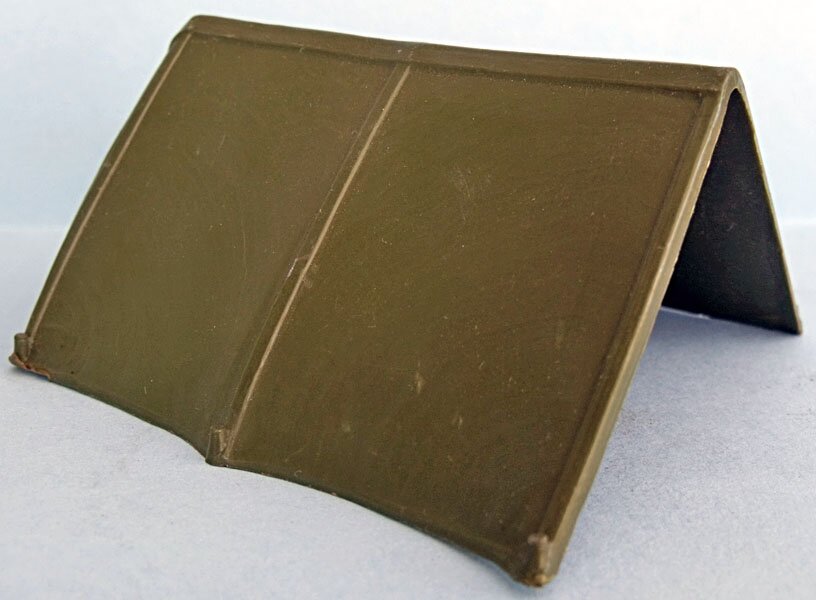  |
||
| 1. Pup tent front (Army olive drab) and back (Air Force metallic blue) Note pegs on tents. Competitor tents often looked similar, but had no pegs. |
||
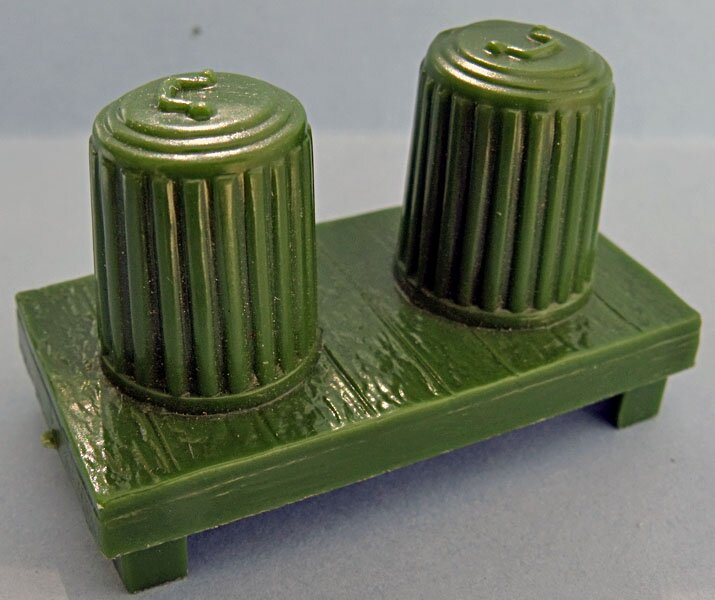 |
 |
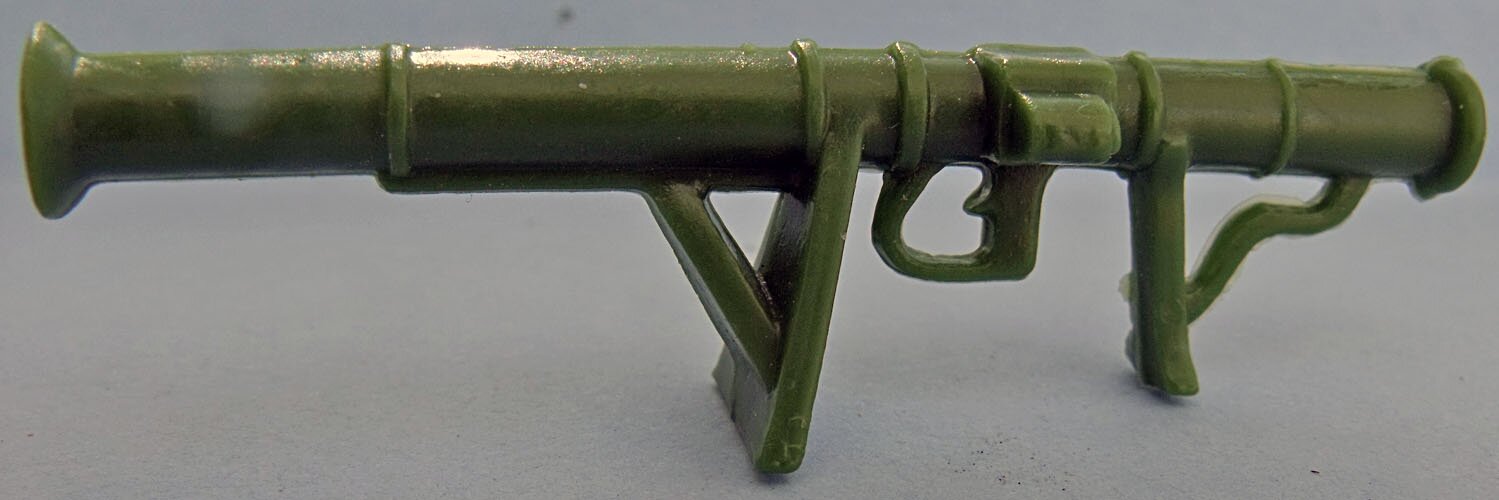 |
| 2. Trash cans | 3. Stack of five rifles | 4. Bazooka |
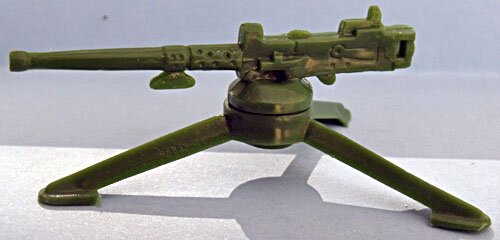 |
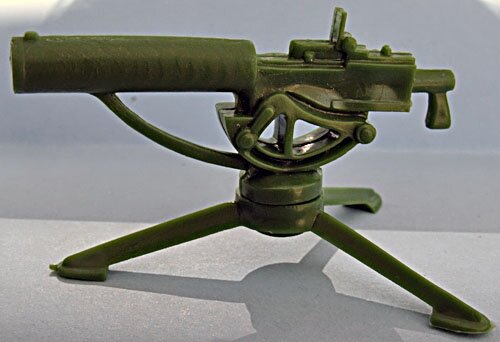 |
|
| 5. Air-cooled machine gun |
6. Water-cooled machine gun |
|
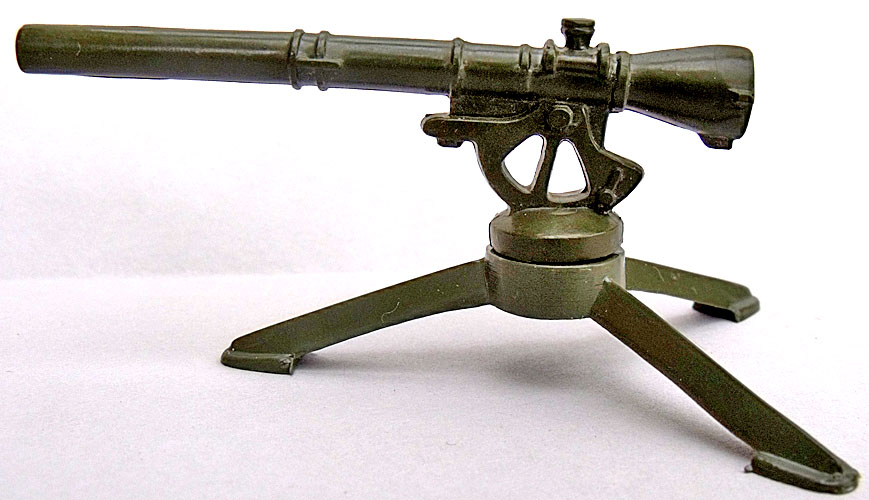 |
||
| 7. Recoiless rifle |
||

Training Center Office Accessories
PL-347
Army Training Center sets often included a headquarters building (see later on this page), which was furnished by hard plastic office furniture and accessories cast in olive drab. Those that had a barracks building, a down-sized headquarters building, or a headquarters building with no floor did not get the office accessories.
Most of the furniture is unique to the military playsets, but the table is identical to the one used in Western Ranch playsets.
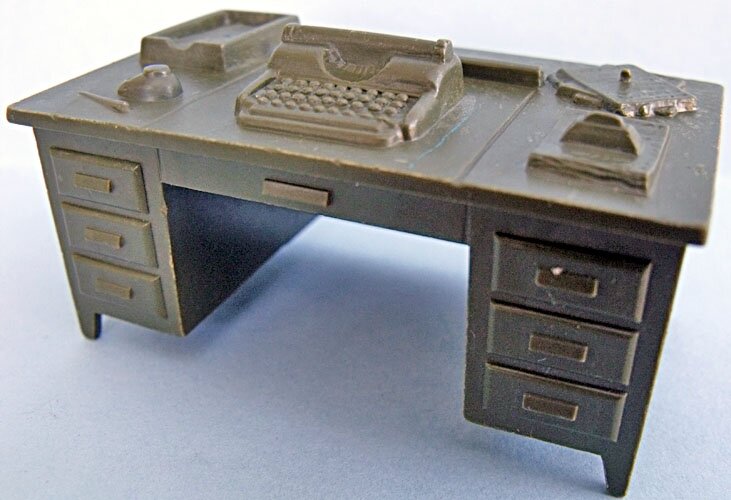 |
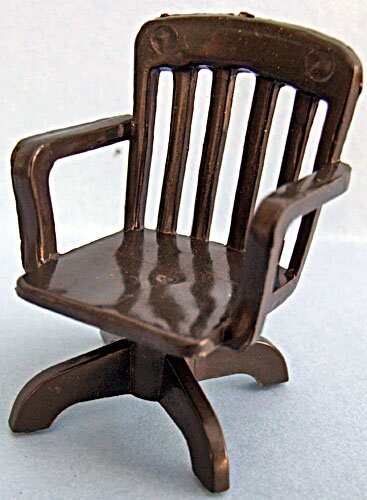 |
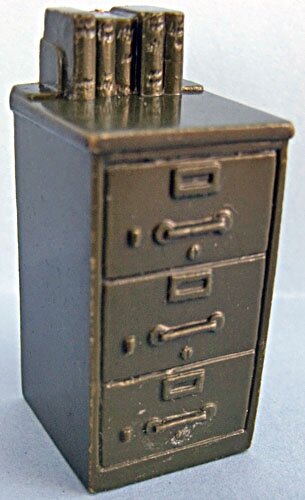 |
| 1. Sitting, shooting rifle with scope | 2. 2-piece swivel chair |
3. File cabinet |
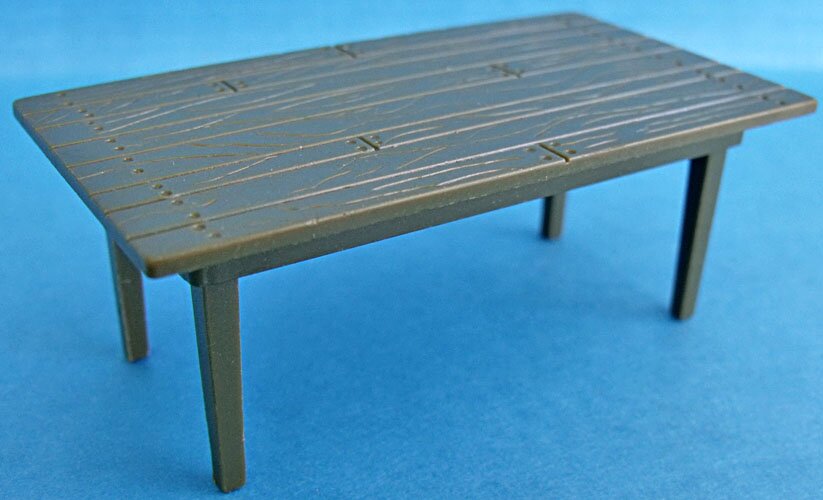 |
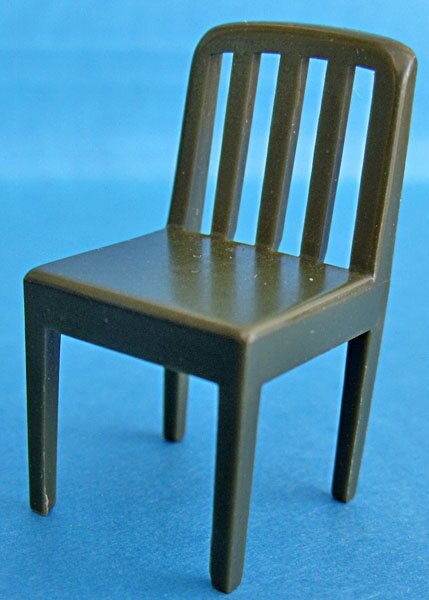 |
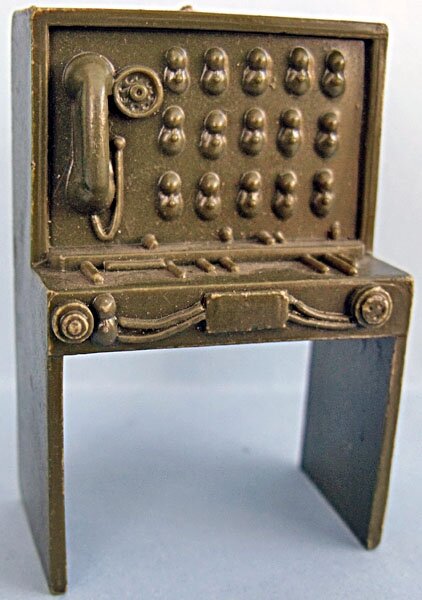 |
| 4. Table | 5. Straight back chair |
6. Telephone switchboard |
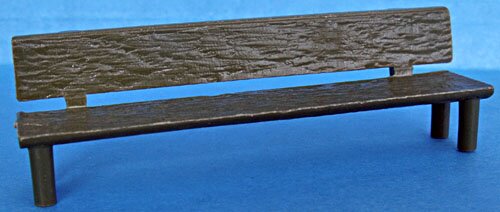 |
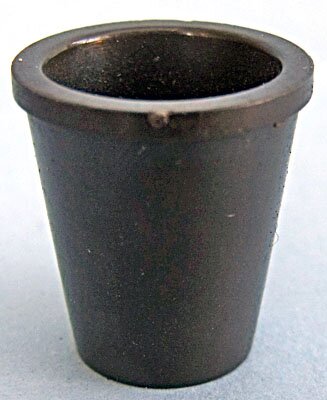 |
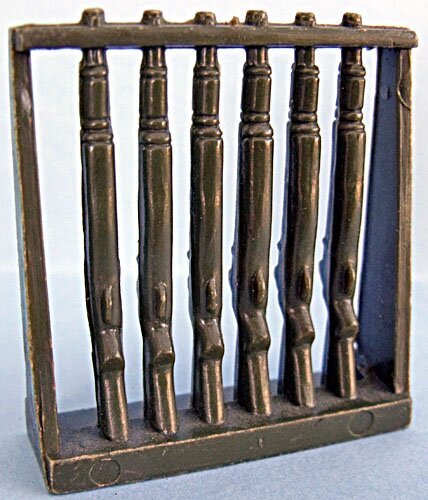 |
| 7. Bench, with back | 8. Waste basket | 9. Rifle rack |
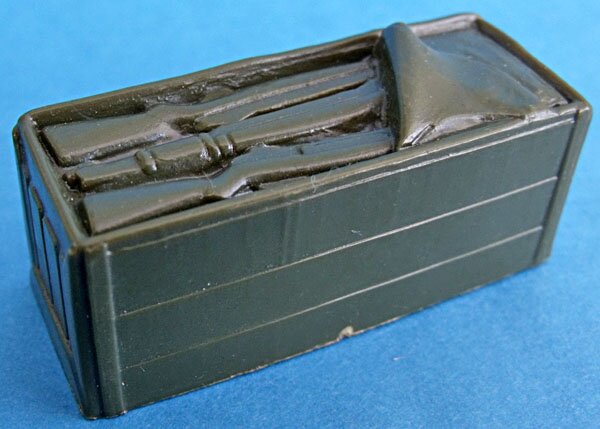 |
| 10. Crate of rifles |

Buildings
The first Army Training Center sets included a headquarters building that used the same metal stamping as used for buildings in the company's Western Ranch and Fort Apache playsets. Only the lithographing was changed, both the inside and outside. It is about 11 inches wide, 6 inches deep, and five inches high. Today this is by far the most common Marx military building to be had.
Click here to see inside of building
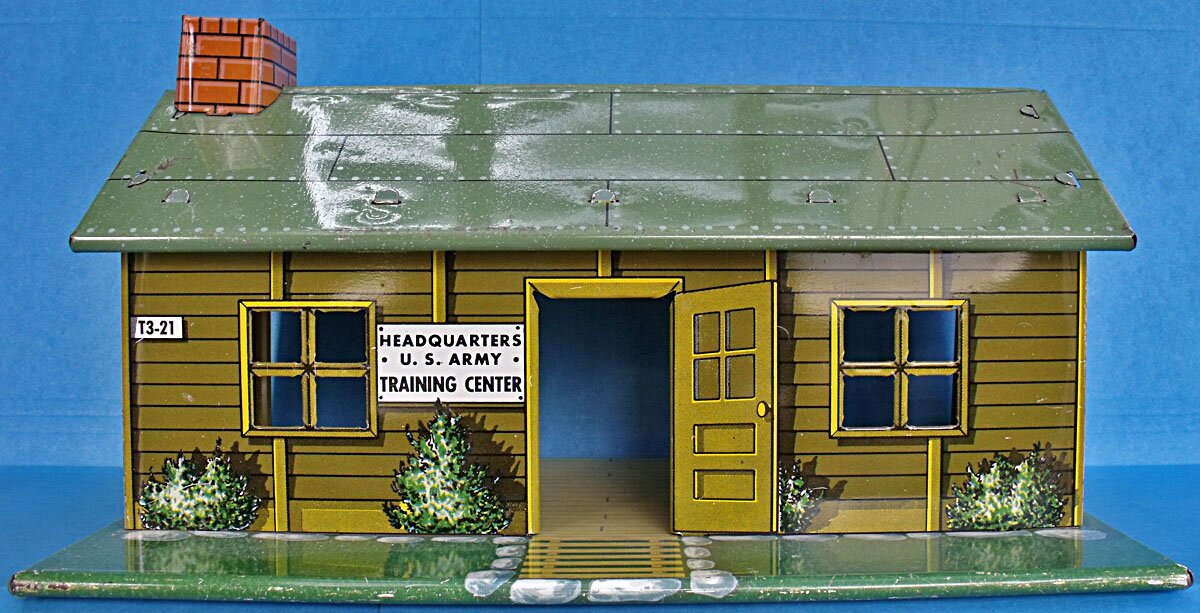 |
| U. S. Army Headquarters - Training Center - Building T3-21 |
Marx introduced its military barracks building in 1954, measuing about 5-3/4 inches by 11-1/2 inches, 8 inches high. The building is marked T7-34. The barracks replaced the previous headquarters building; it was four-sided, eliminating the need for the plastic office accessories. Some had the fire escape ladder lithographed onto the building, and others included a yellow hard plastic fire escape that was attached into small holes in the side of the building. Even those with the holes still had the lithographed ladder also. The plastic fire espace has been re-issued in both yellow and gray.
The company introduced an identical barracks for its Armed Forces Training Center with an oval sign on the roof, as shown below. As seen below, this building has a different color scheme, but otherwise was identical, using the same T7-34 marking and a plastic fire escape ladder.
While certainly an appropriate building for Marx' many military playsets, it has little play value for kids, and I'd have to say that it is one of the company's most boring playset buildings.
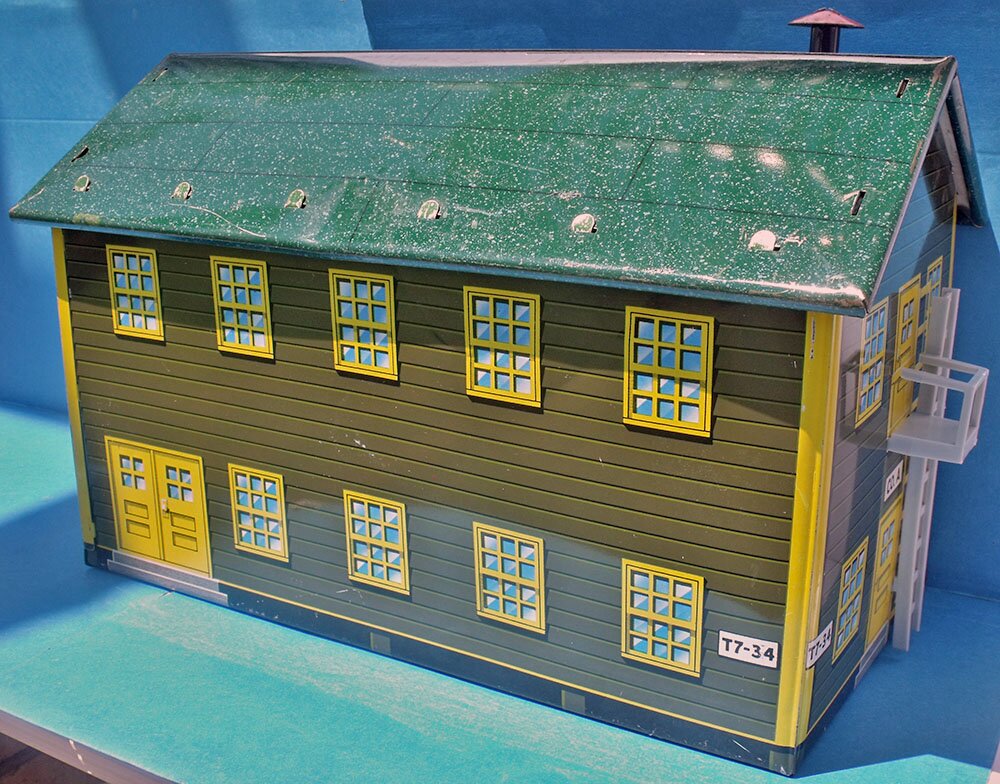 |
|
| Barracks - Building T7-34 Fire escape is re-issue. |
|
 |
|
| Other side of the barracks | |
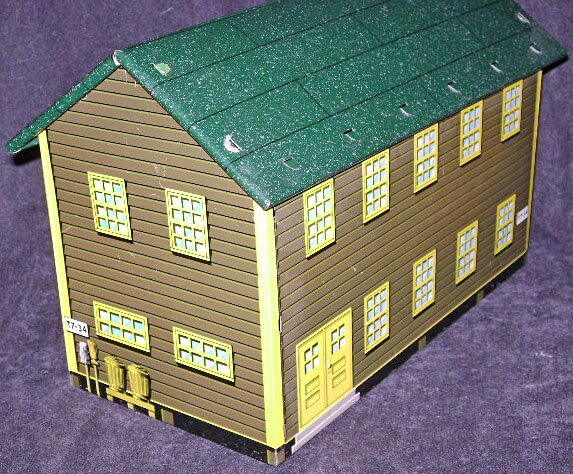 |
 |
| Ends of the Army barracks building - Building T7-34 Note that building has no sign on top and that fire escape is lithographed on. Smoke stack is missing Photos courtesy of Shannon Edwards, Ebay ID theworkingartist. |
|
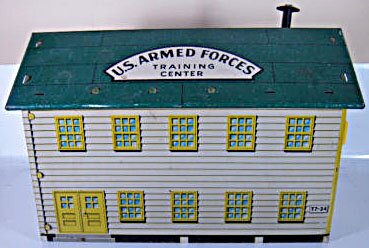 |
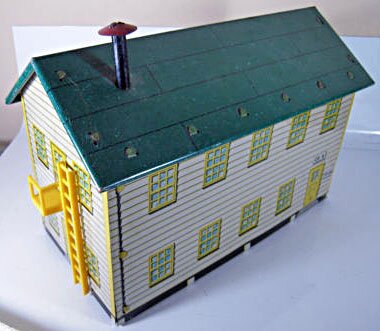 |
| Armed Forces barracks building - Building T7-34 Note plastic fire escape. Originals were yellow, as shown, though re-issues have been made in yellow also. Photos courtesy of Bob Wilson, Ebay ID angusiii. |
|
Later in the 1950s, Marx introduced a down-sized headquarters building, using the same metal stamping as the Wild West cabin used in such sets as the Rifleman. This building was marked T1-12 and has a roof-top sign reading U.S. Army Headquarters. According to PFPC, although the building has an open back with interior lithographing, sets came with no office accessories because they could not fit into the down-sized building. The building has no floor, but has a back bar in the back along the bottom that helps to hold the building in shape.
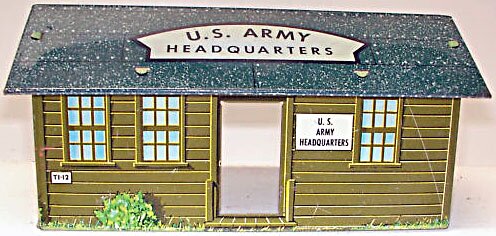 |
| Down-sized Army Headquarters - Building T1-12 Photo courtesy of Ebay ID wwsd516. |
| Recent Price Lines I have noticed | ||||
| $43 | September 2013 | Ebay | ||
For its Armed Forces playsets in the mid-1950s, Marx created an Armed Forces headquarters building that was the same size as the original Army Training Center building (T3-21). It is marked T1-14, and has no open door, open windows, or floor. With no floor, a bottom back brace was included to hold the building in shape. Also with no floor, the office furniture group was not included for the building. According to PFPC, some Armed Forces sets had the T3-21 Army Training Center building with a floor, and those included the furniture.
Click here to see inside of building
 |
| Armed Forces Headquarters - Building T1-14 |
Final versions of the Armed Forces Training Center sets had a down-sized building. This was the same as the down-sized Army headquarters building shown above, but with the designation changed to U.S. Armed Forces Training Center. The building number stayed the same, T1-12.
If you click to see the back of the building (which displays the interior lithographing), this building is missing the back bar, which is a thick metal wire that attaches to the back bottom corners to keep the two side walls in position.
Click here to see inside of building
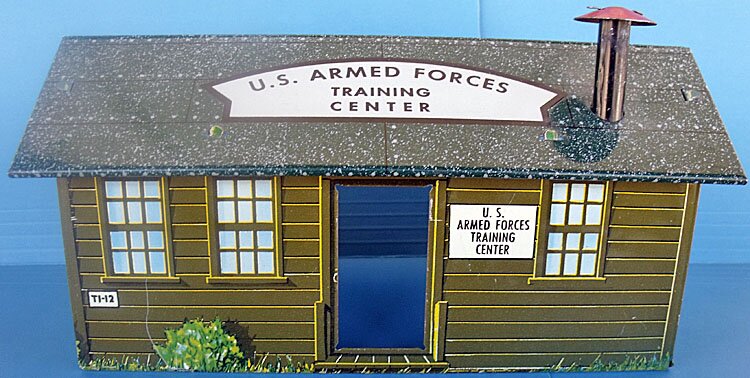 |
| Down-sized Armed Forces Headquarters - Building T1-12 |
| Recent Price Lines I have noticed | ||||
| $62 | June 2013 | Ebay | with back bar, price seems a little high | |
One of the most difficult of all Marx tin litho buildings to find is the Post Exchange. The building was included only in the company's final large Armed Forces Training Center Set, #4156, in the late 1950s. The "PX" building is actually a street front that includes three connected buildings: a Post Exchange, Company C Supply, and Headquarters of the 57th Training Battalion. It was manufactured using a slightly modified mold that had been used to produce the company's smaller Wild West streetfront buildings
Seen from the front, the size and shape of the PX -- including the doorways -- is identical to the Wild West buildings. However, the PX does not have the supporting posts that hold up a porch overhang on the Wild West buildings; the PX does not have the overhang. From the side, the PX bulding is much less deep than its Wild West counterparts, measuring only 4 inches deep, including the 1-1/2 inch porch. As a result, it has no room for interior furnishings, and the set included none. The top of the roof, not seen in the photos below, is a dark, white-speckled green, and the narrow sides are lithographed with doorways.
Like the Wild West buildings, the PX is 20 inches wide, has no interior floor, and no back bar. It has some very basic interior lithographing consisting of windows, a small map, a calendar, and a fire extinguisher, as seen in the photo. Sadly the interior lithography lacks any creativity, that could certainly have been used for the inside of the PX section, the military version of a department store.
The set is coveted by most collectors, but that is a result of its difficulty to find, not its attractiveness.
 |
| Post Exchange building - front The photo is shown slightly smaller in scale that most buildings on this page due to it 20-inch width. |
 |
| Post Exchange building - back |
| Recent Price Lines I have noticed | ||||
| $225 | March 2012 | Ebay | ||
| $370 | December 2015 | Ebay | ||
| $225 | September 2017 | OTSN | ||
Another rare Marx military building was exclusive to the 1958 unique Battle Field Play Set. This is the down-sized tin cabin, but lithographed on the outside as a destroyed building, riddled with bullet holes, broken windows, and a large hole in its roof. The building is three-sided, but includes no interior lithograph.
According to PFPC, the Battle Field Play Set had limited distribution, so is difficult to find today. The building alone can cost several hundred dollars. Interestingly, this was the only Battleground-related playset that included a tin litho building.
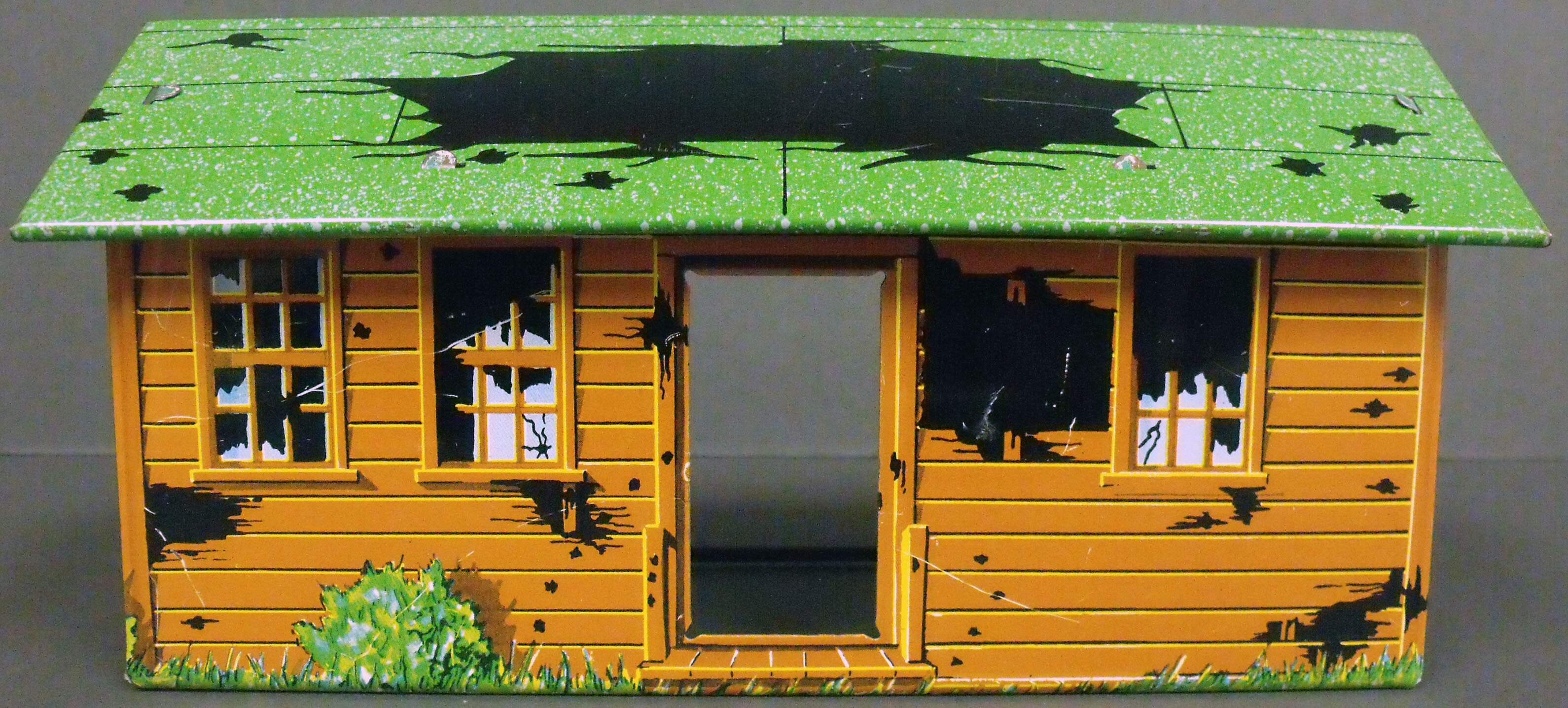 |
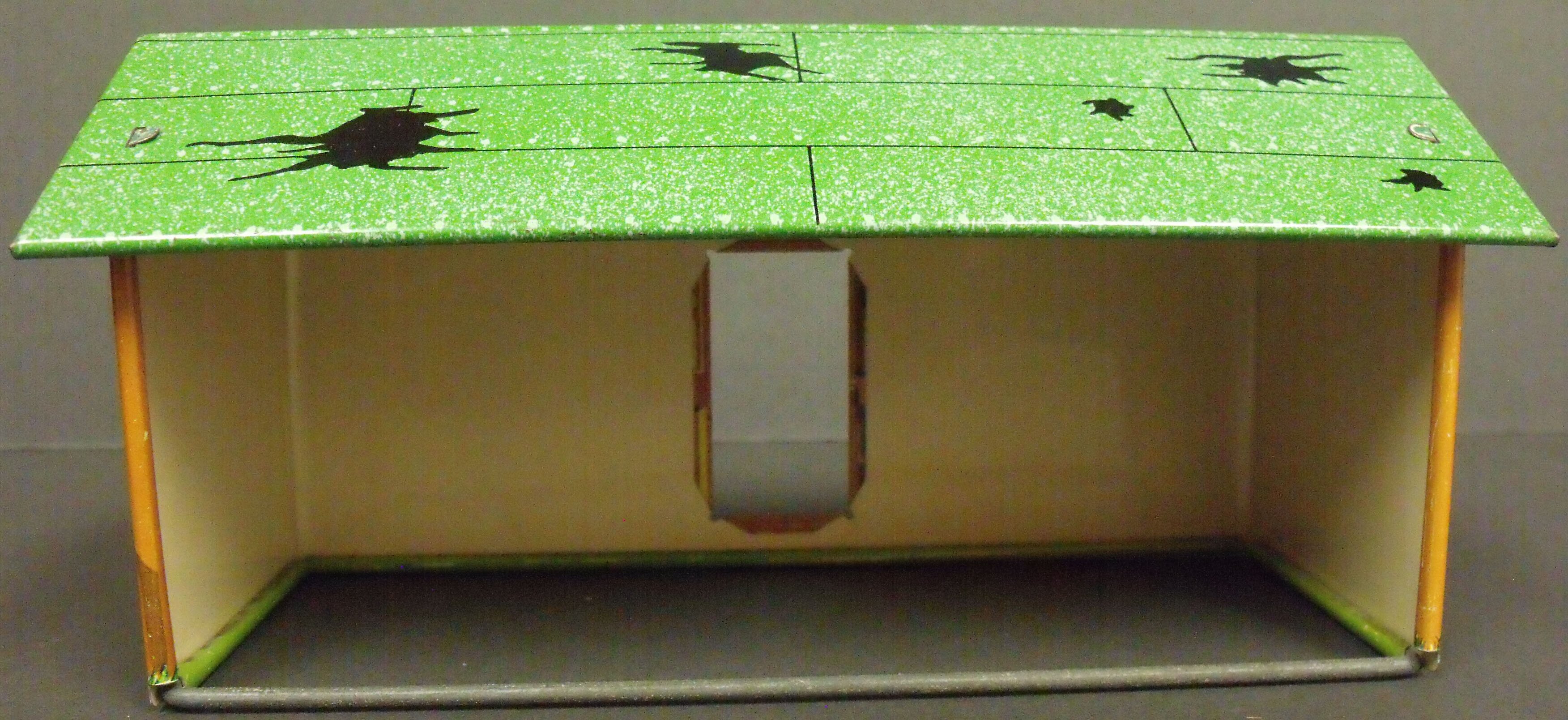 |
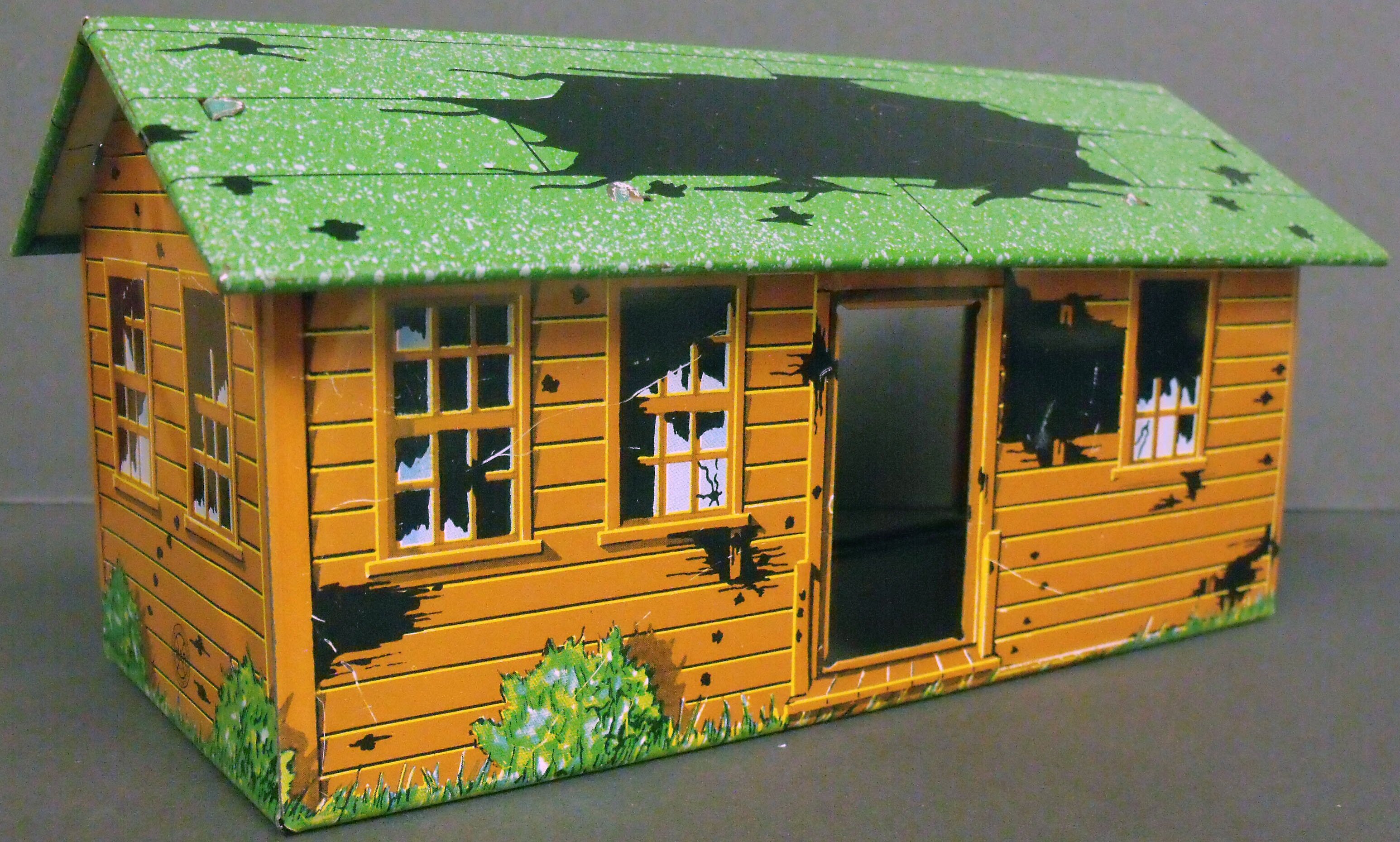 |
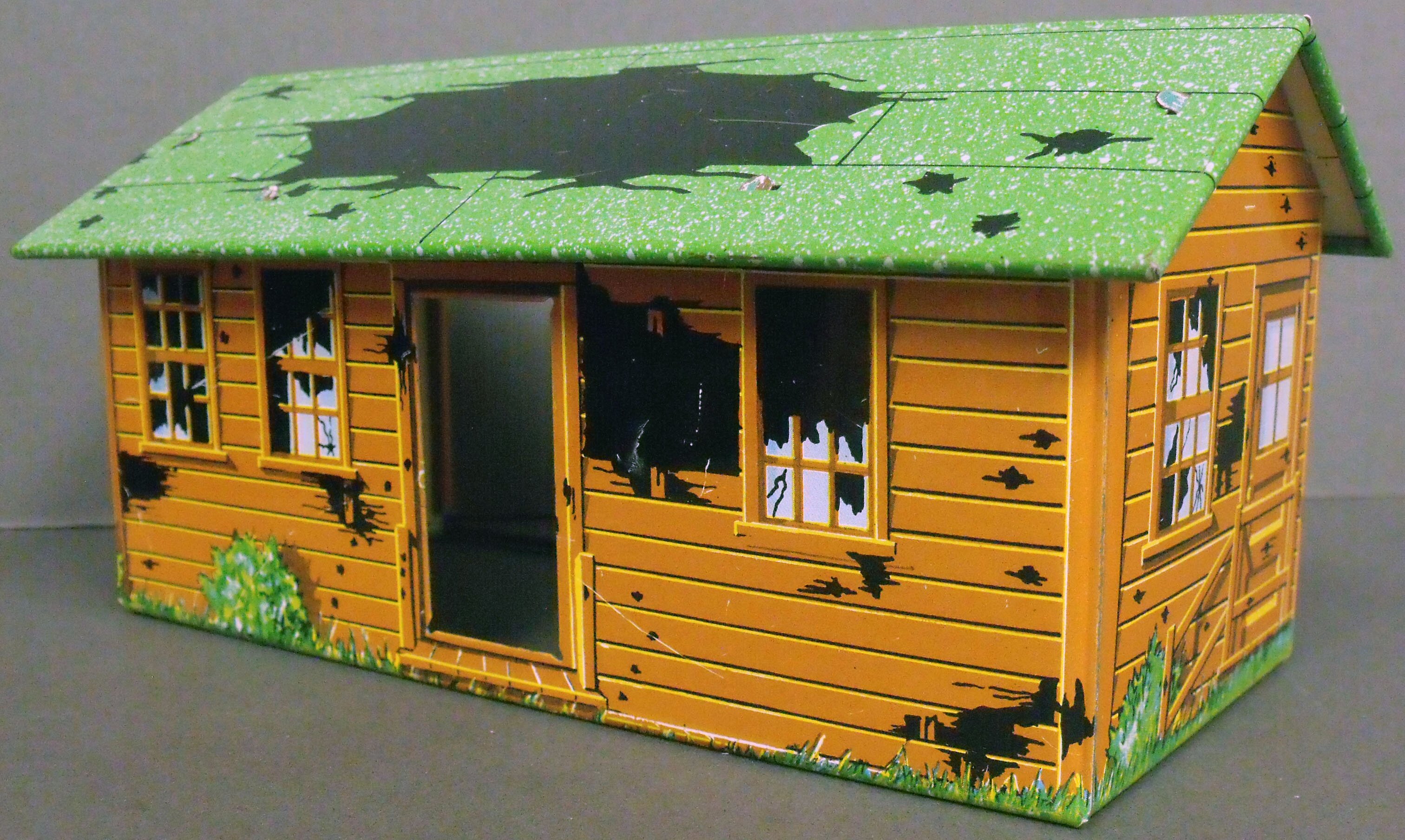 |
| Destroyed Building Photos courtesy of collector David Schafer |
|
| Recent Price Lines I have noticed | ||||
| $371 | September 2012 | Ebay | ||
| $306 | May 2013 | Ebay | ||
The Strategic Air Command playsets that were first sold in 1963 had a completely different tin litho building that was based on Marx' exisiting airport playsets rather than other military sets. This 26-inch wide structure consisting of a hangar (large enough to hold one of the set's B-52 bombers) and an attached S.A.C.Operations Office. Atop the hangar were a control tower, radar units, and antenna equipment. Needless to say, it is an impressive structure.
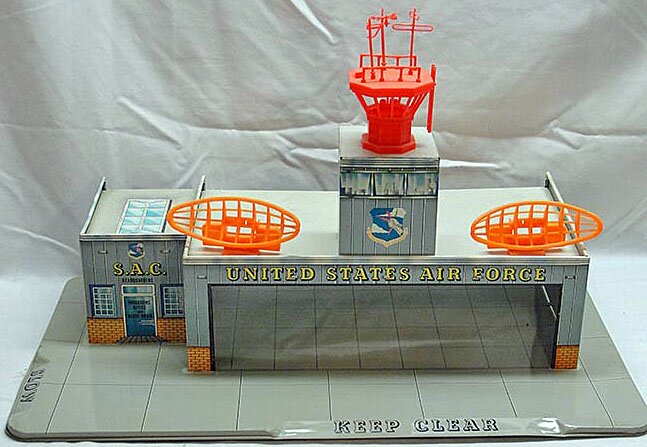 |
| S.A.C. Operations Office and Hangar Photo courtesy of Rick Eber, www.marxplaysets.com |
Marx' Military Academy Play Set, issued in 1954, included a main building that, according to Playset Magazine Issue 59, looks very much like the actual West Point cadet quarters. The set also has four tin litho walls with corner towers, pretty much identical to the walls of the company's medieval castle fortresses. However, the walls were not intended to create an enclosed fort, so no tin litho gate was in the set.
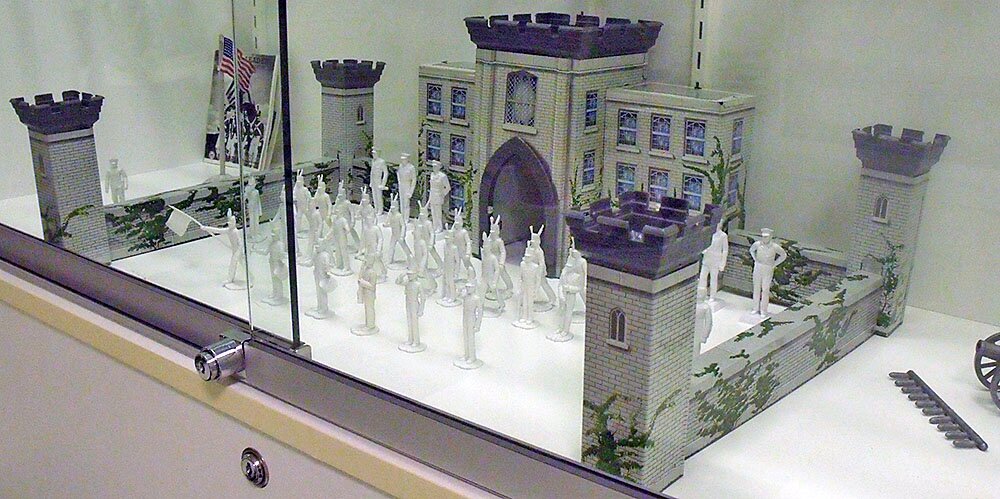 |
| Military Academy with figures Photo is of items in Marx Museum, Moundsville, West Virginia |
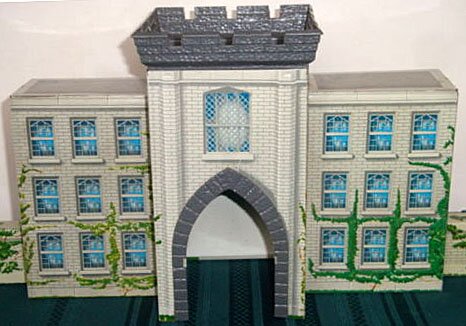 |
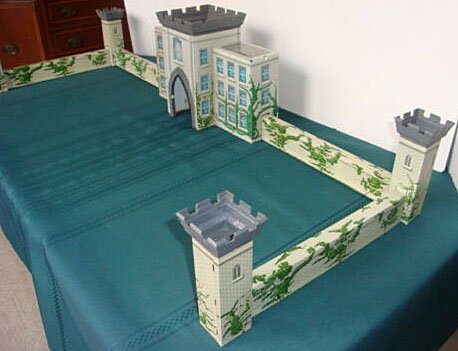 |
| Military Academy Photos courtesy of Allan Ford, Ebay ID 610allanf |
|
| Recent Price Lines I have noticed | ||||
| $47 | May 2013 | Ebay | some rust, walls in poor condition | |
| $80 | June 2013 | Ebay | light wear | |
A final military structure considered rare today is the tin litho Army Combat Center gate and fence. It is rare because no such item was ever included in any Marx playset. For some reason, it was sold only in a bagged header card set that PFPC states "apparently came with a small grouping of Army figures." The gate and fence use the same metal stamping as used by such "fort" pieces in several playsets, such as the Alamo and Fort Apache.
The gate is white clapboard with guard shacks on either side and an overhead sign reading "U.S. Army Combat Center." PFPC reports its measurements to be 5-1/2 inches high and 9 inches wide. Fences depict a chain link fence with barbed wire at the top, 3-1/2 inches high and 9-inches wide.
Although it would seem reasonable to do so, Marx never produced any military playset with a gate and fencing to allow kids to create an enclosed military base. PFPC points out that it was probably cheaper to make a few sections of split rail fence to include in playsets (see the Fence section below) than to manufacture tin litho gates and fences.
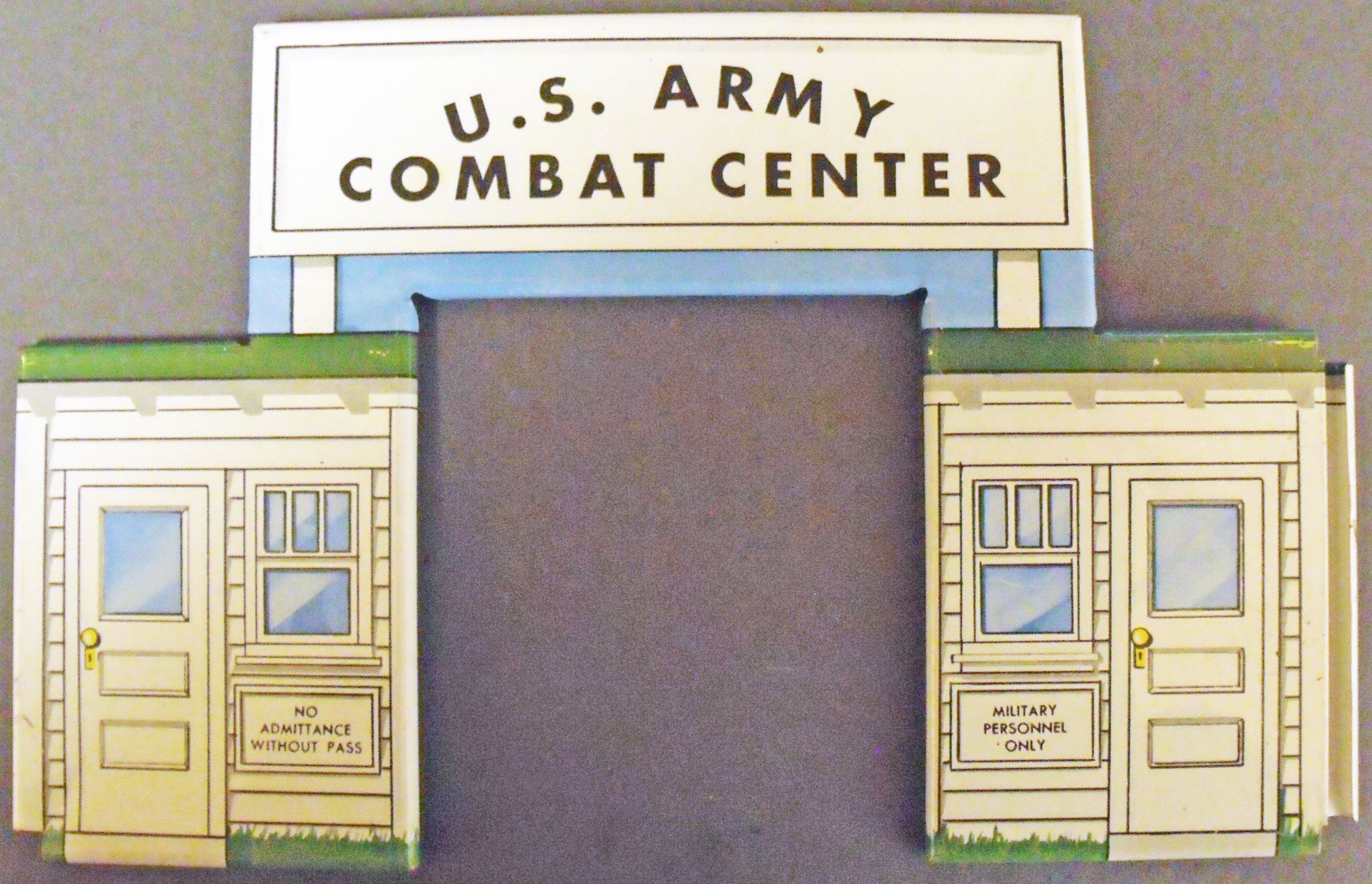 |
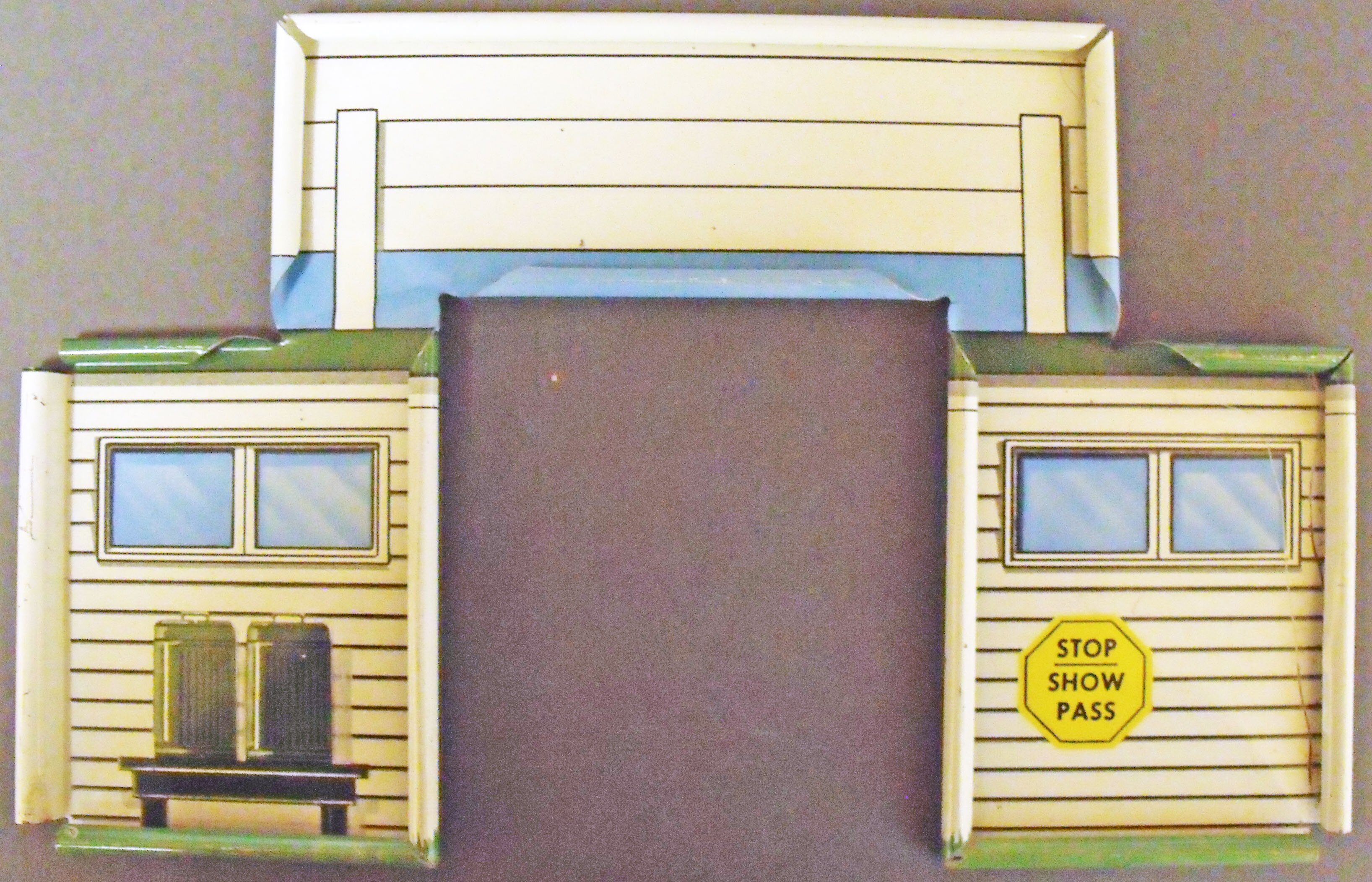 |
| Army Combat Center gate - front and back views Photos courtesy of David Schafer |
|
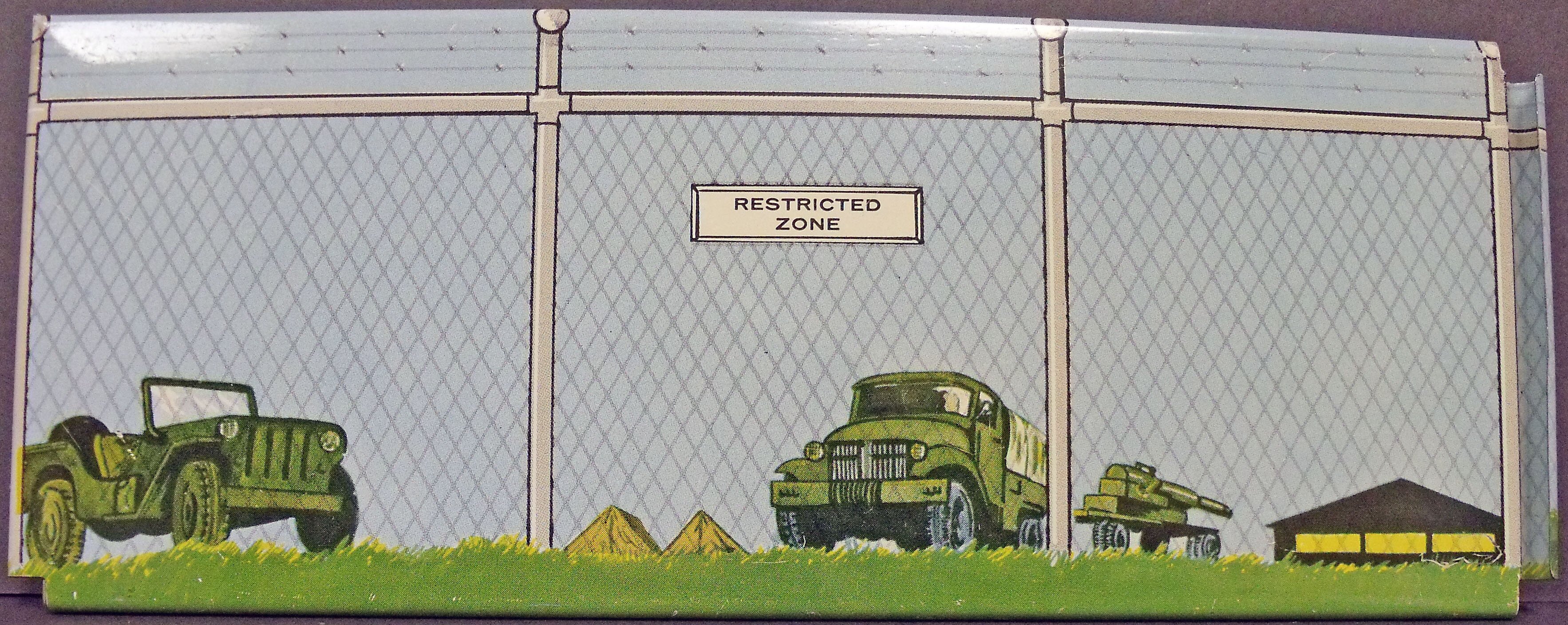 |
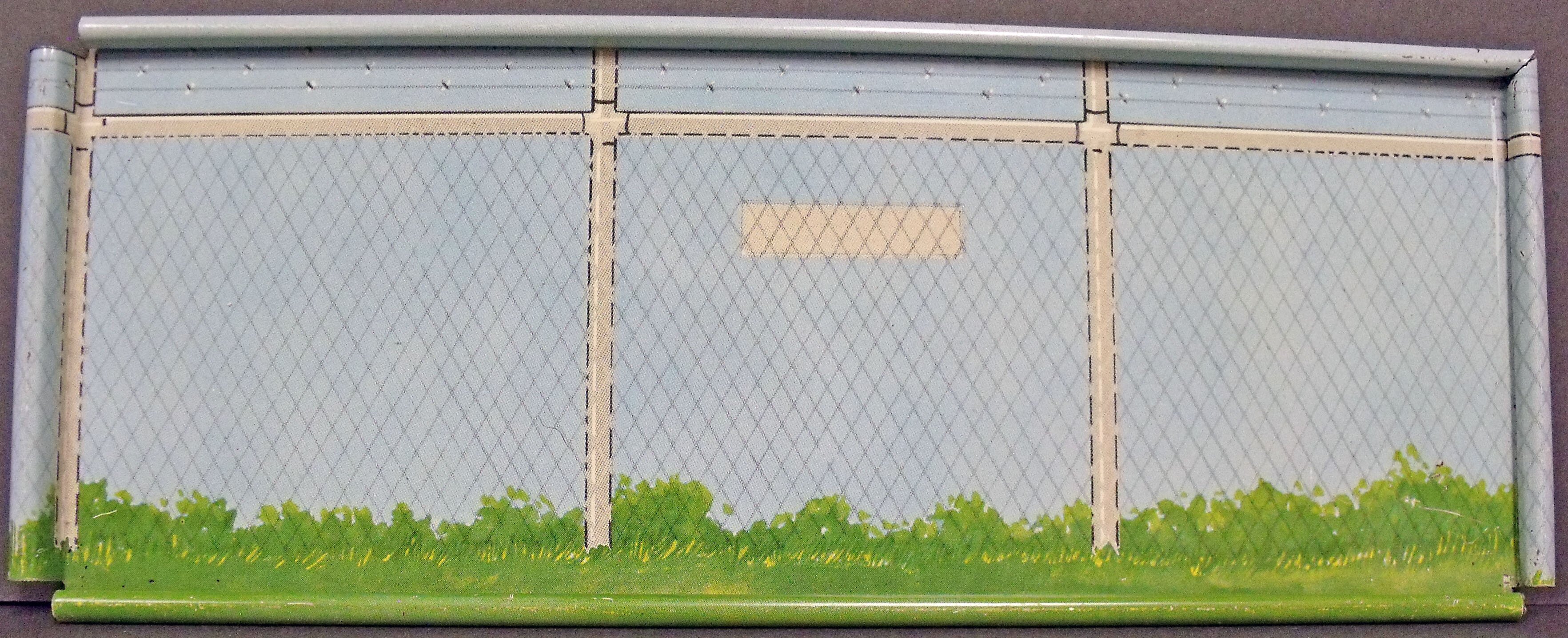 |
| Army Combat Center gate - front and back views Photos courtesy of David Schafer |
|
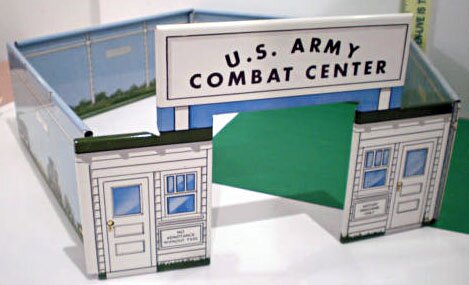 |
| Army Combat Center Gate and Attached Walls Photo courtesy of the Thomas Terry Collection, Ebay ID pfpcmagazine |

Other Structures - 54mm Playsets
In the midst of Armed Forces Training Centers, Marx introduced its command tent and 3-piece cot, made in olive drab soft plastic. Later Battleground playsets introduced in 1958 continued to include these items in various shades of green. These same items were used in other playset themes, such as gray ones in Civil War sets.
PL-765
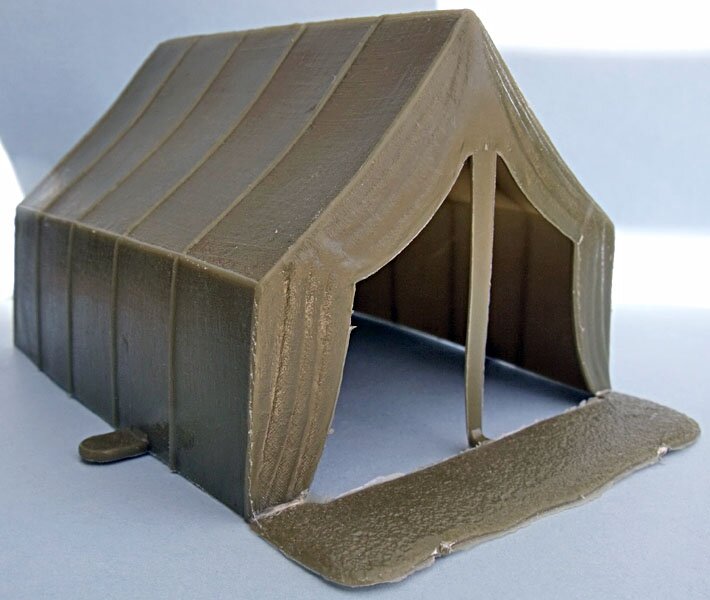 |
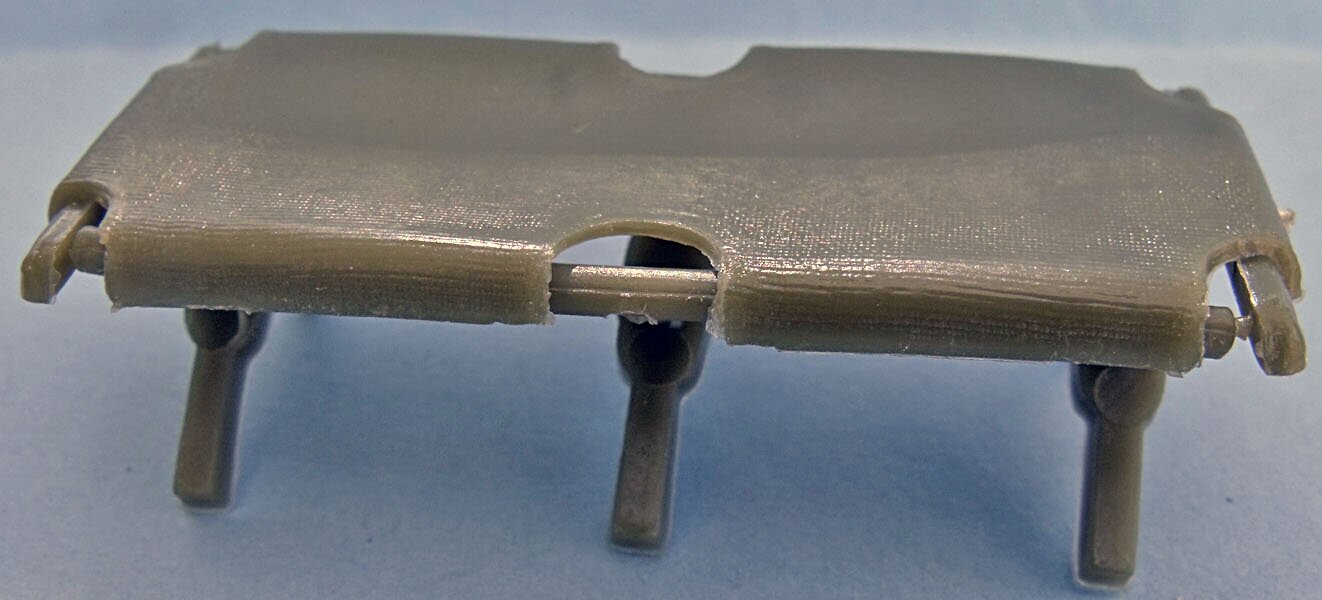 |
| 1. Command tent | 2. 3-piece cot |
The Atlantic seawalls below were first seen in 1964 American Patrol playsets. The largest version of the 19665 Europe Battleground, a late arriving playset, also included the hugely underscaled walls. Originals were made in gray hard plastic; the ones shown below are re-issue. Both walls are about 8 inches wide and 2-1/2 inches tall. They are nice pieces as long as they are placed far in the background. They are not often seen today.
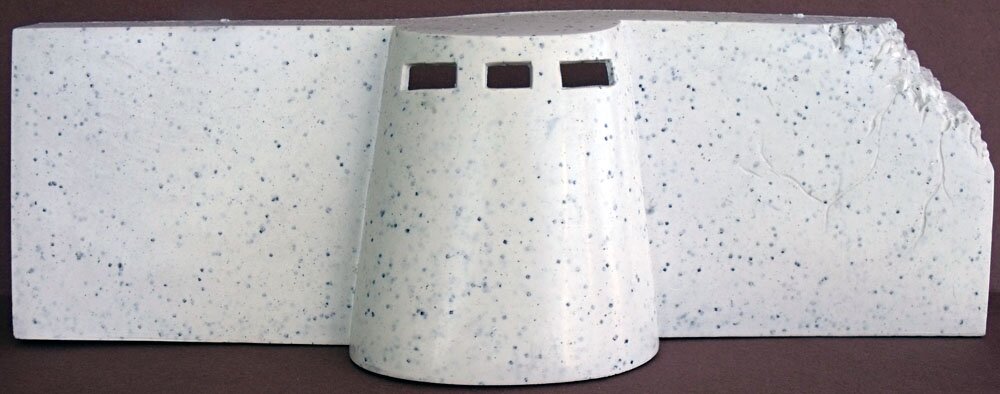 |
| Atlantic Seal Wall - crack on left side Item shown is is a re-issue. |
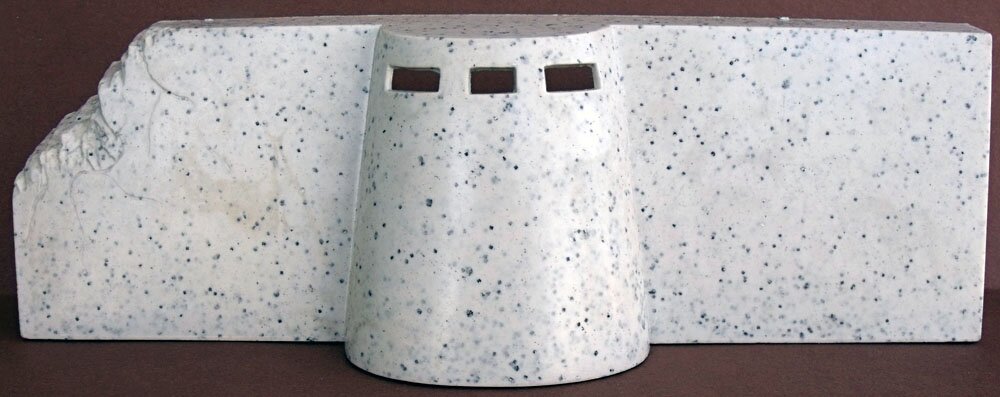 |
| Atlantic Sea Wall - crack on right side Item shown is a re-issue. |

Early Vehicles
Sometimes Marx did things right and sometimes they did things wrong. Most of the wrong things they did had to do with cost. One thing they did right was the group of vehicles in the Army Mobile Set and the series of training center playsets. Not only were they thougtfully conceived, accurately designed, and well made (in contrast with the sometimes crude training center figures), but they were pretty much the same scale as the 45mm figures. PFPC, in fact, says they are oversized at 54mm or 60mm scale, a situation unheard of in Marx toy sets.
The Army Mobile Set, seemingly the first military set produced by Marx, included three vehicles molded in olive drab hard plastic: a halftrack, an armored scout car, and a flatbed truck. The flatbed had three payloads -- a searchlight, a radar unit, and an anti-aircraft gun -- and two flatbeds came in each set. The half track had a place near the driver's seat to insert a flag pole and paper flag. A second version of the set had a stake-side truck (with seats to carry troops) instead of the scout car and an amphibious duck instead of the halftrack.
The training center sets, first sold in 1952, included a variety of vehicles, sometimes one or more of the vehicles in the Army Mobile Set. According to Plastic Figure and Playset Collector magazine, the most common vehicles in these sets were the armored scout car and the halftrack. New vehicles were also introduced in the same scale and material as the Army Mobile Set vehicles, the most common being a jeep. Less common vehicles that may have been found in the training center sets were a mobile gun carriage and trucks that were used in Marx freight station playsets. However, there is disagreement among collectors as to how often -- or even if -- these were actually included in any of these sets.
Unfortunately, when Marx changed its playsets from 45mm to the slightly larger 54mm scale, the vehicles were downsized, due to the company's efforts to keep prices low and to increase the number of pieces in each set. As a result, vehicles lost any realistic interaction with the figures. At the same time, such innovations as the three payloads for the flat bed truck were discarded. The only early vehicle to show up in any Battleground-related playsets was the halftrack, which came in hard plastic in the hard-to-find Battle Field Play Set in 1958.
My experience suggests that these vehicles will generally cost $50 to $100, with the jeep and scout car running less than $50.
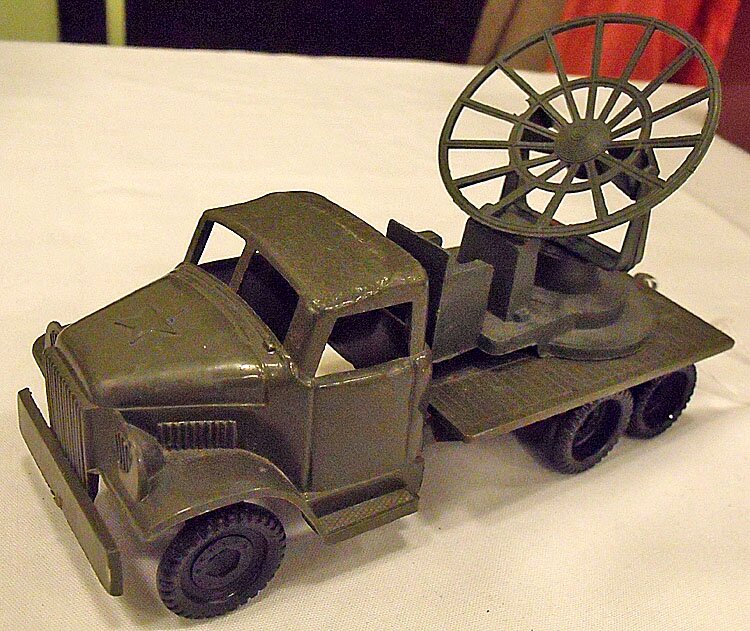 |
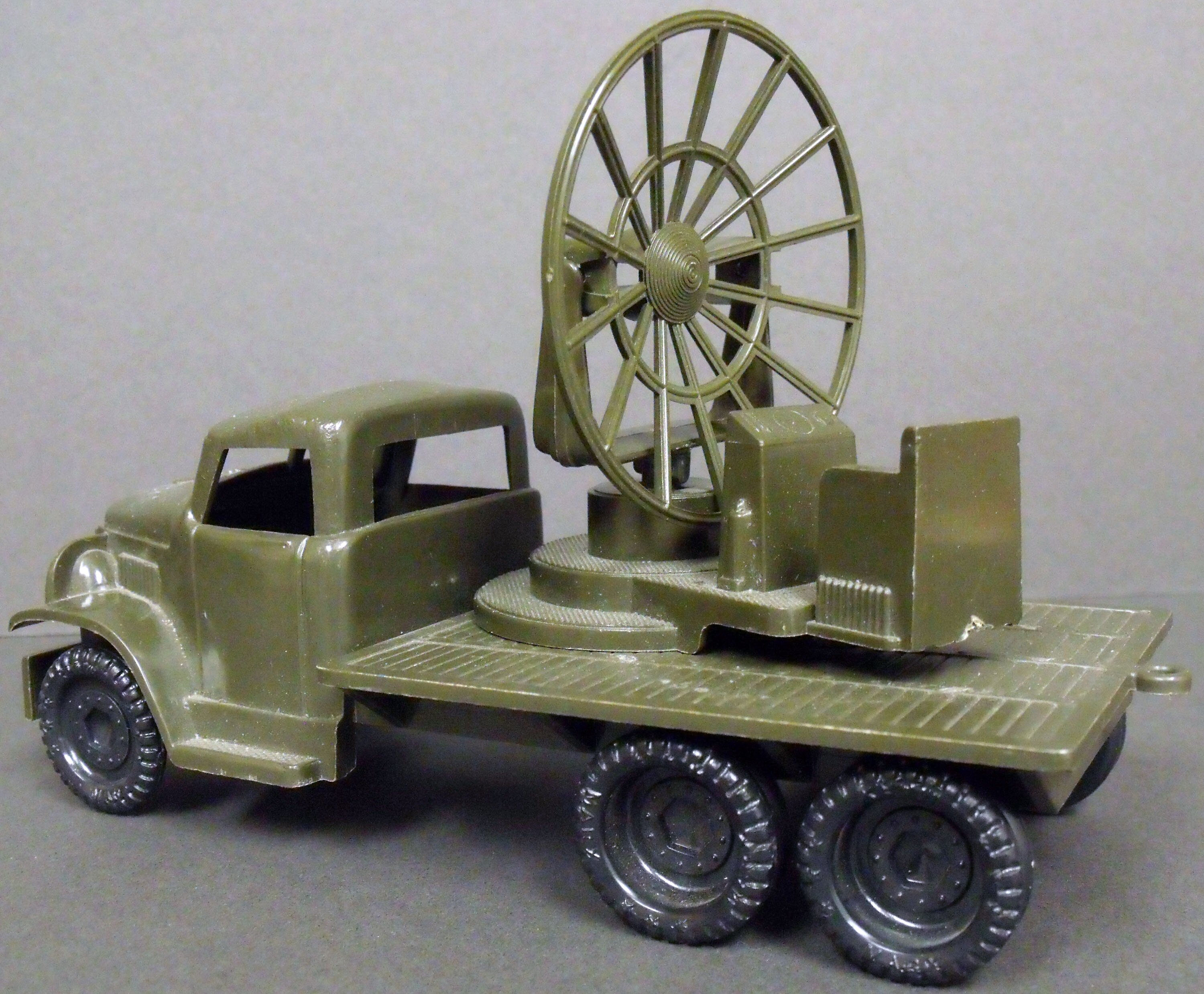 |
| Flatbed truck with radar unit Photo courtesy of Faded Glories (FG) Military Antiques of Lynchburg, VA. Vehicle is about 7-1/4 inches long. |
Back view of radar truck Photo courtesy of David Schafer |
| Recent Price Lines I have noticed | ||||
| $104 | October 2011 | Ebay | excellent condition | |
| Flatbed truck with searchlight |
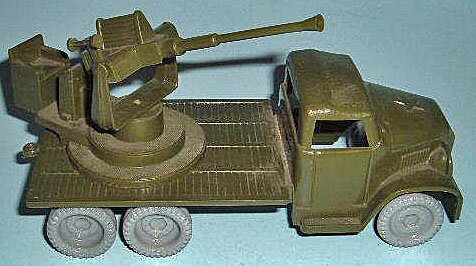 |
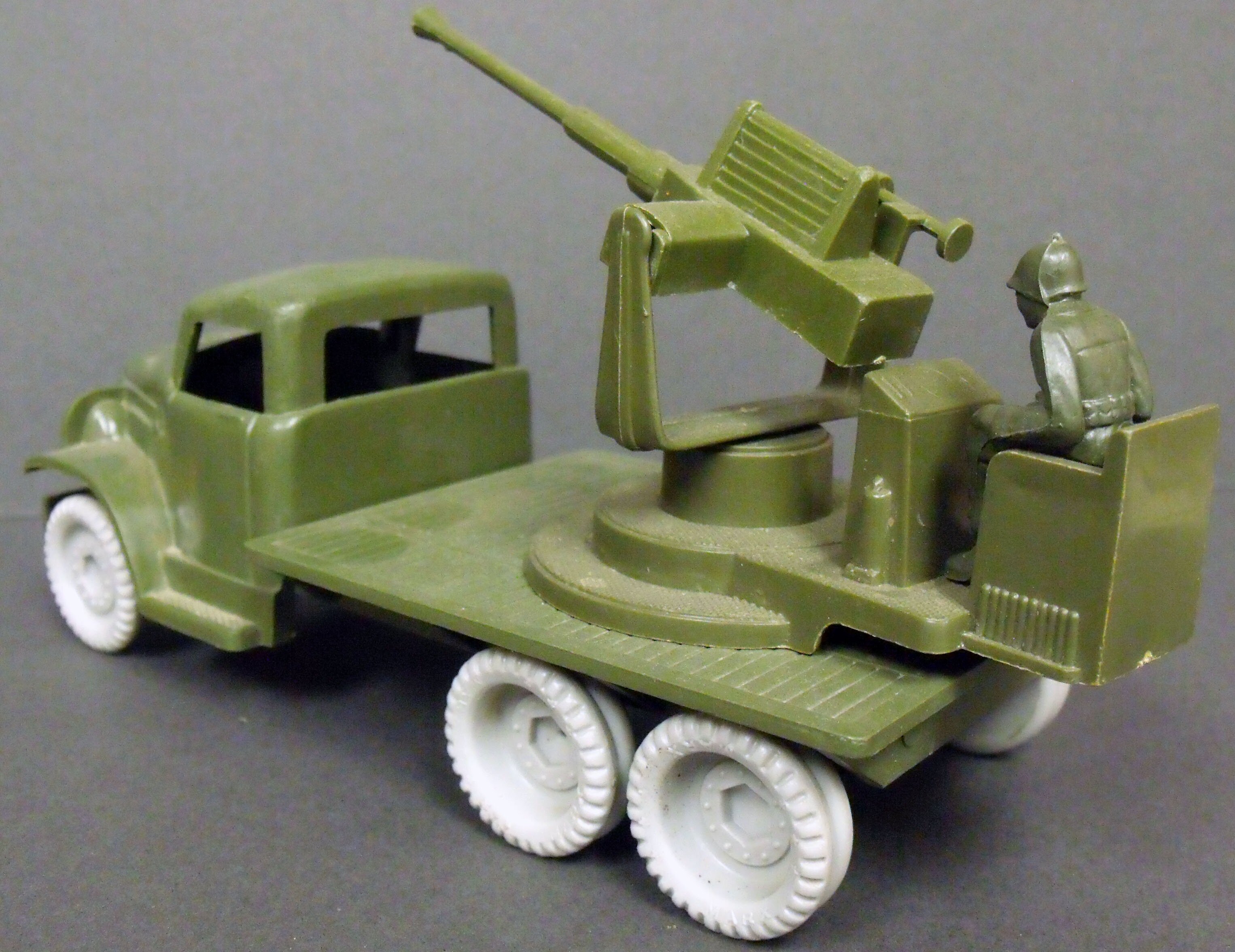 |
| Flatbed truck with anti-aircraft gun Photo courtesy of Rick Koch, Ebay ID toy-hood |
Back view of aircraft gun truck Photo courtesy of David Schafer |
| Recent Price Lines I have noticed | ||||
| $42 | September 2012 | Ebay | ||
| $183 | August 2013 | Ebay | excellent condition | |
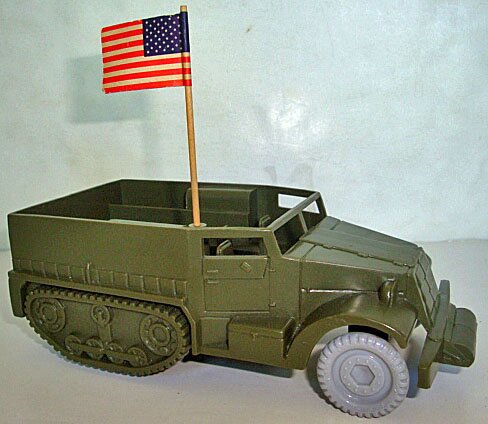 |
| Halftrack Photo courtesy of Allan Ford, Ebay ID 610allanf Vehicle is about 6-1/2 inches long. |
| Recent Price Lines I have noticed | ||||
| $38 | May 2013 | Ebay | with flag, nice deal for the buyer | |
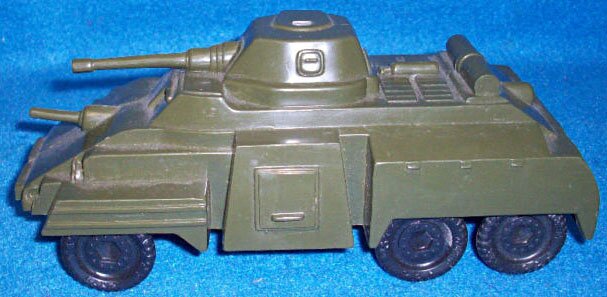 |
| Armored Scout Car (about 7 inches long) Photo courtesy of Jim McGough, Ebay j.mcgough |
| Recent Price Lines I have noticed | ||||
| $22 | November 2011 | Ebay | excellent condition | |
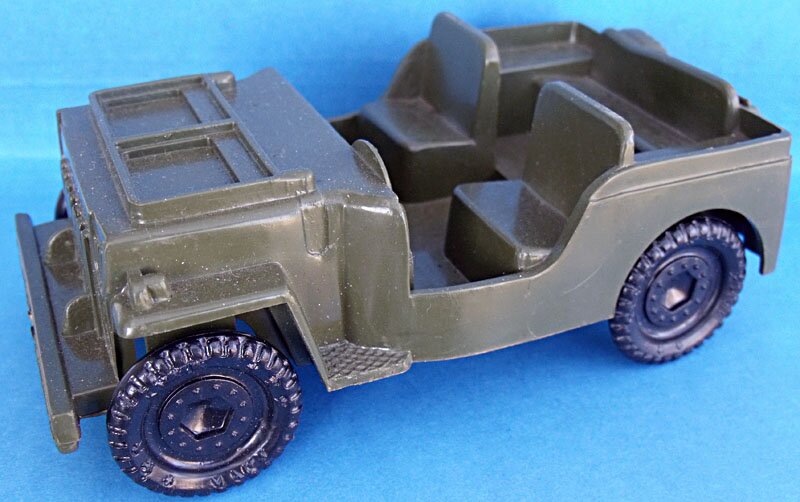 |
| Jeep Not quite 5 inches long, 2-3/4 inches wide |
| Recent Price Lines I have noticed | ||||
| Jeep | $19 | November 2011 | Ebay | excellent condition |
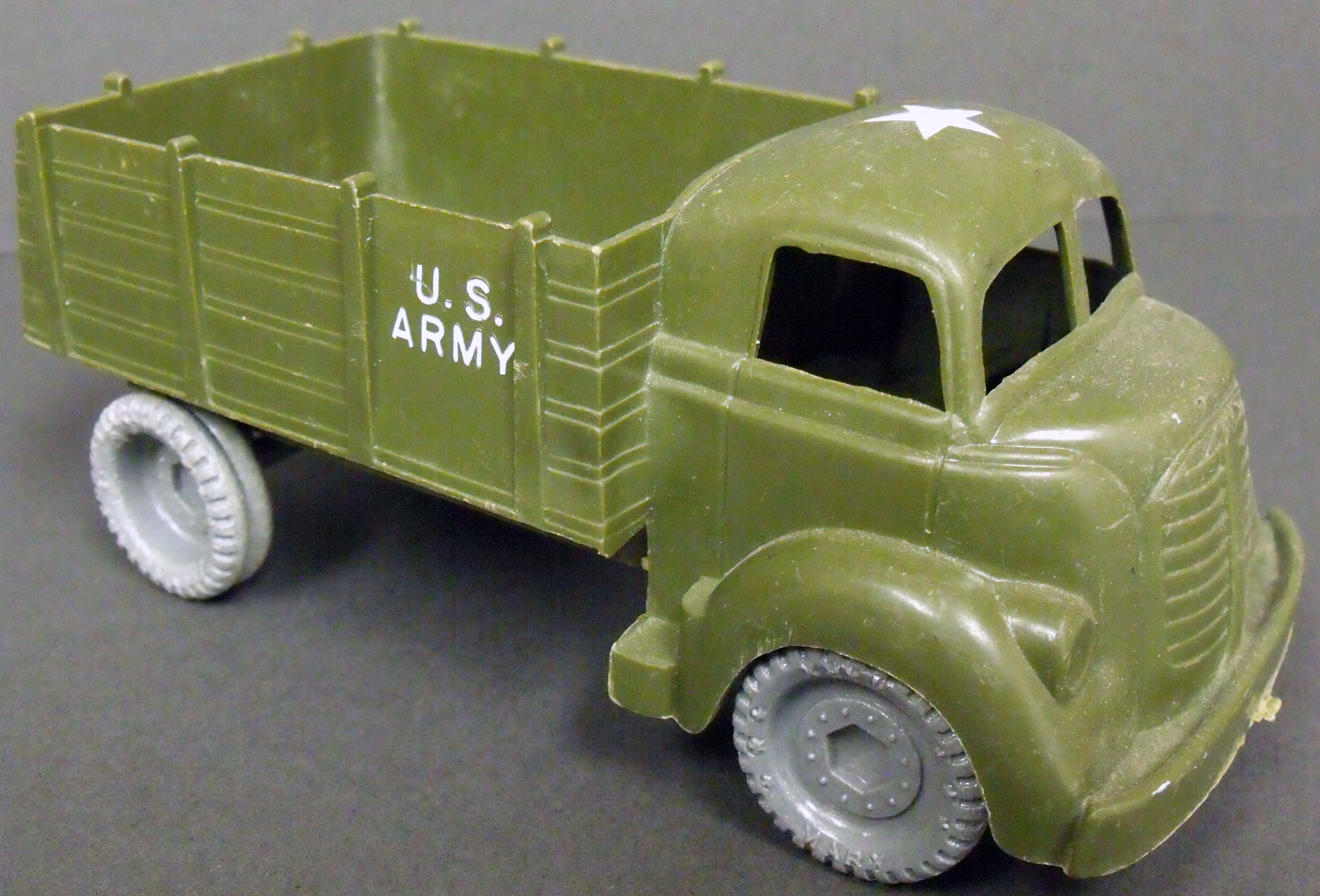 |
| Stake truck with sides up Photo courtesy of David Schafer |
 |
| Stake truck with sides off Photo courtesy of Rick Koch, Ebay ID toy-hood |
| Recent Price Lines I have noticed | ||||
| Stake truck | $66 | August 2013 | Ebay | excellent condition |
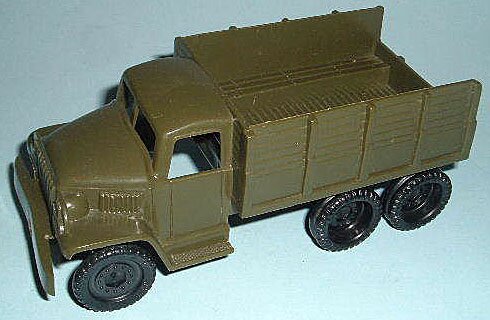 |
| Stake truck - personnel carrier Photo courtesy of Rick Koch, Ebay ID toy-hood |
| Recent Price Lines I have noticed | ||||
| Personnel carrier | $72 | August 2013 | Ebay | excellent condition |
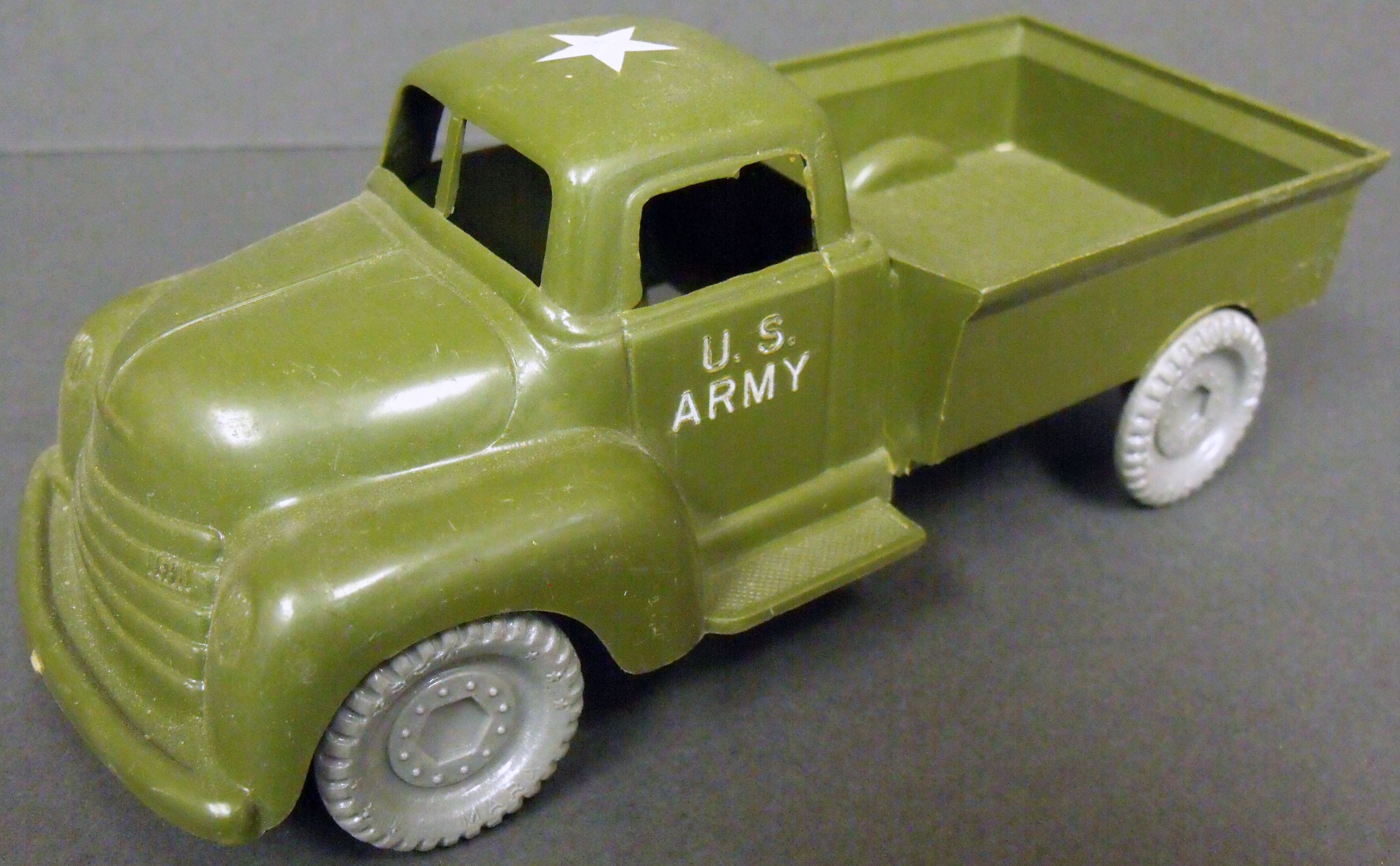 |
| Cargo truck Photo courtesy of David Schafer |
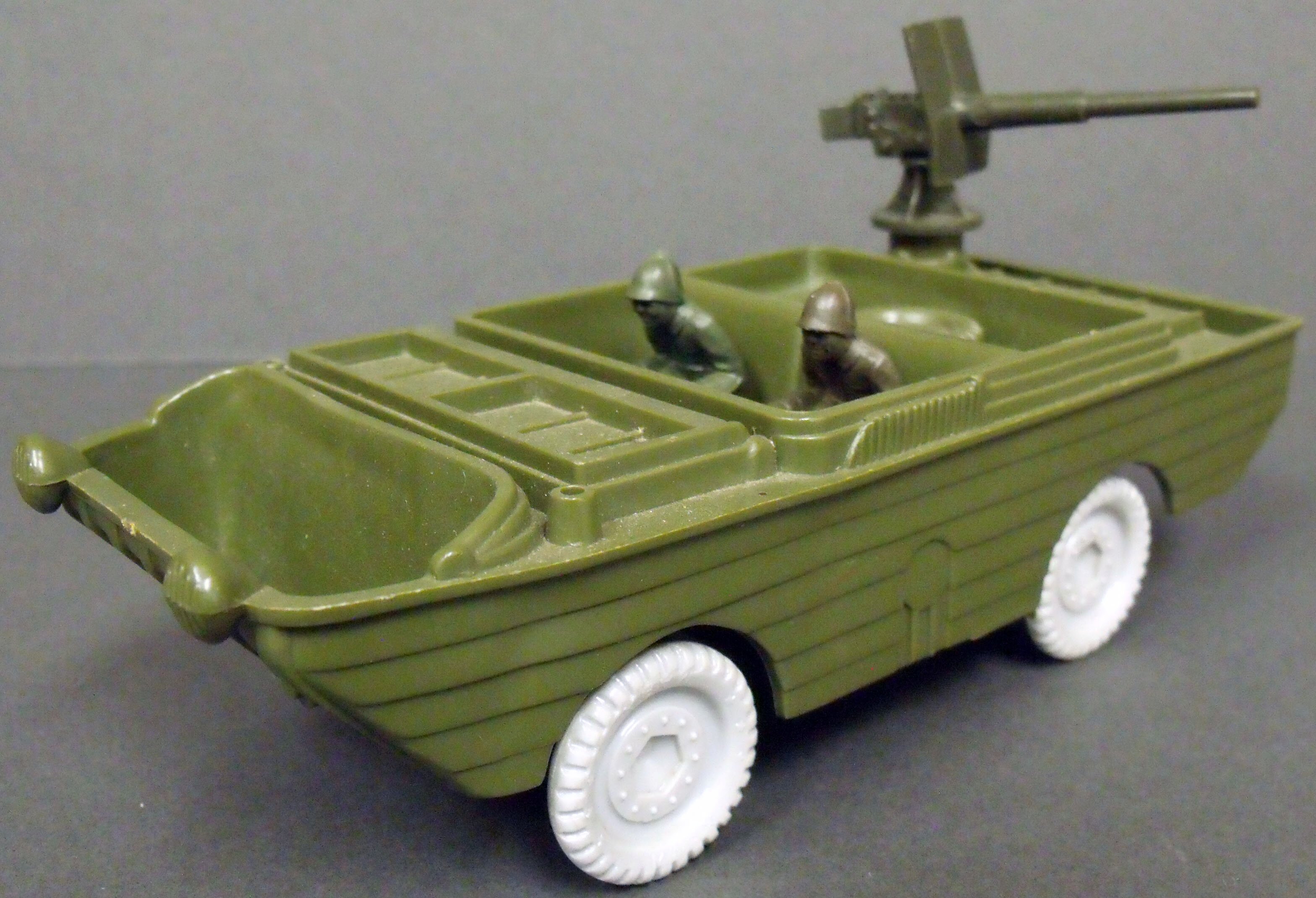 |
 |
| Amphibious duck - front and back views Photos courtesy of David Schafer |
|

54mm Playset Vehicles
U. S. 6-piece Vehicle Group
PL-934 (vehicle wheels PL-935)
From 1958 onward, the basic vehicles for Marx military playsets were this 6-piece "vehicle" set, which was first included in Battleground playsets that year. Unlike the earlier vehicles, these were significantly under-sized in relation to the 54mm figures that came with these playsets and notably smaller than vehicles provided with the former 45mm figures. This was certainly an attempt by Marx to reduce the cost of playsets, while at the same time increasing the number of pieces in a playset.
These vehicles were made in soft plastic, initially in an olive drab green and later in a darker green that collectors call forest green. Only five items are shown below, because the sixth "vehicle" was a light artillery piece, which is included in the artillery section below. The tank, half track, and jeep all have a hook on the back to pull the artillery piece. All six items except the raft use one-piece wheels/axles.
According to PFPC, this group was also used for British and Russian troops in Marx' Battleground Europe Play Set. British vehicles were a flat light tan; Russian were semi-waxy green. French soldiers had to walk. This Allied equipment is hard to find, and an August 2013 Ebay auction saw a British vehicle group along with 17 British soldiers (see military figure page) go for a whopping $1,414. I'd say between $100 and $200 was for the figures...so the auction winner paid about $1,000 for the accessories!
Playset Magazine Issue 33 notes that for Marx' 1963 D-Day Landing Set, the company created a PL-1016 solely for the group's landing craft (item 3 below). Larger D-Day sets got three extra landing craft (for a total of five), and smaller ones got two extra (for a total of three). The magazine points out that the PL-934 craft have black wheels, while those from PL-1016 have wheels the same color as the craft, because the wheels were included in the same mold.
The pieces below are shown in approximately correct proportion to the size of the 54mm figures on the Military Figures page.
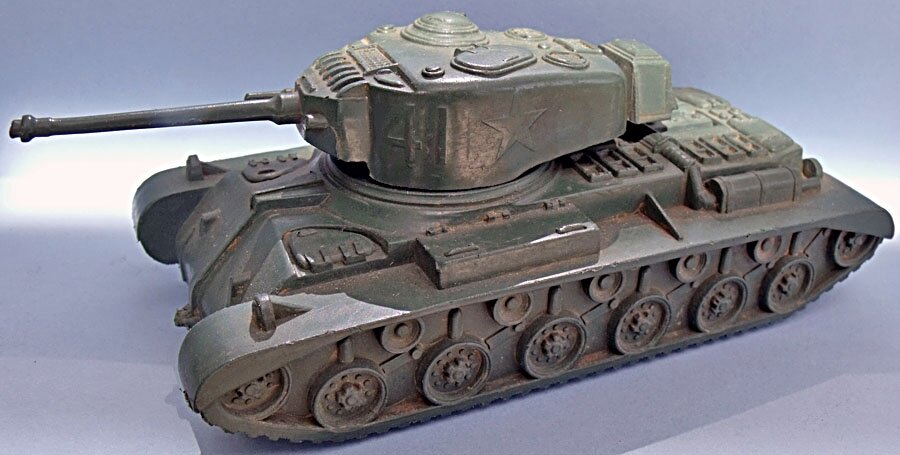 |
|
| 1. Tank 41 About 5-1/4 inches long. Although not seen, the tank has a pair of axles and wheels that allow it to roll. They protrude only about 1/16 of an inch below the tank treads, which do not move. |
|
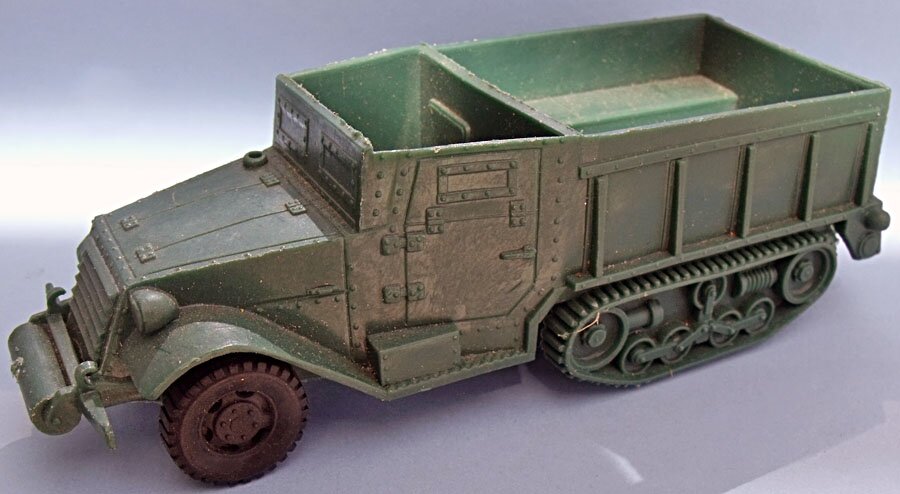 |
|
| 2. Half Track (Armored Personnel Carrier) Although not seen, the half track has an axle and wheels in its rear section that allow it to roll. They protrude only about 1/16 of an inch below the treads, which do not move. |
|
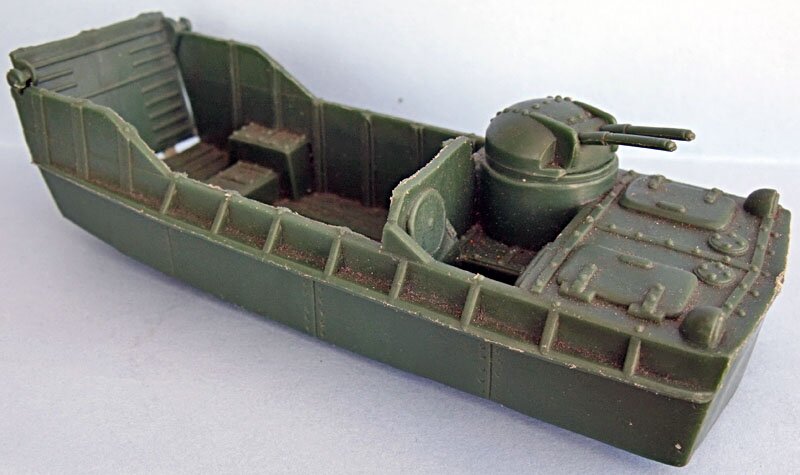 |
|
| 3. Amphibious Landing Craft About 5-3/4 inches long. Although not seen, the tank has a pair of axles and wheels that allow it to roll. They protrude only about 1/16 of an inch below the bottom of the craft. |
|
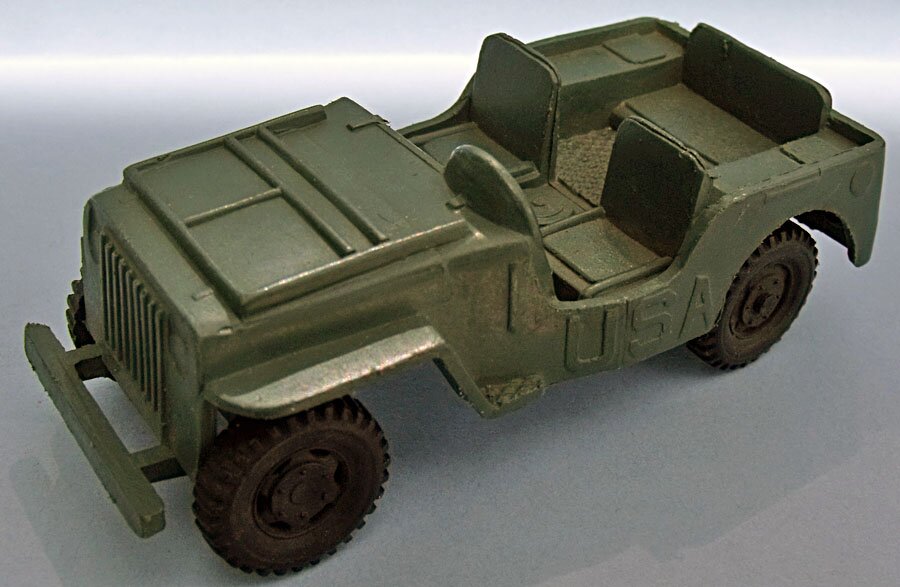 |
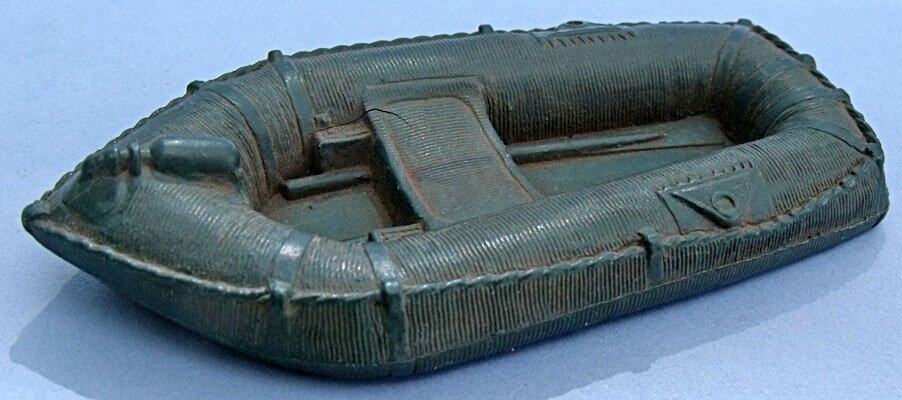 |
| 4. Jeep |
5. Small raft |
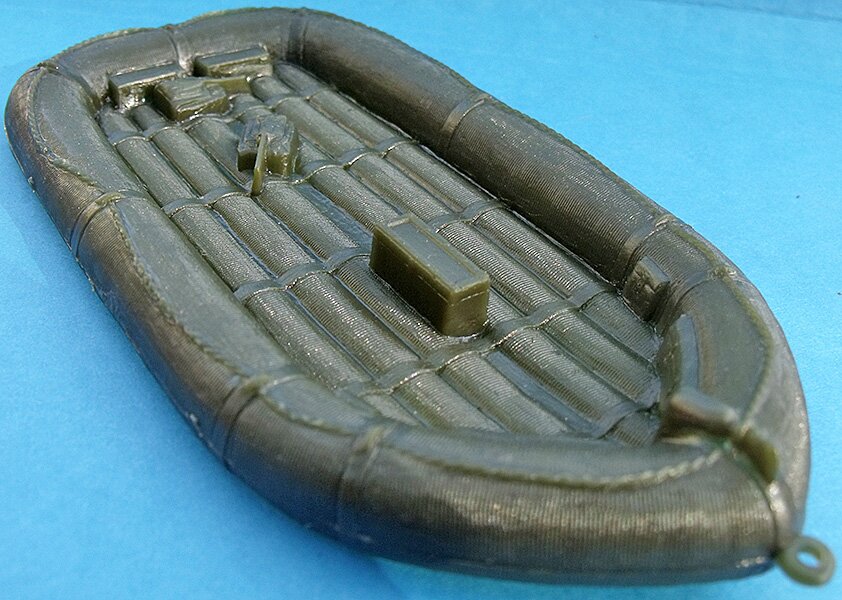 |
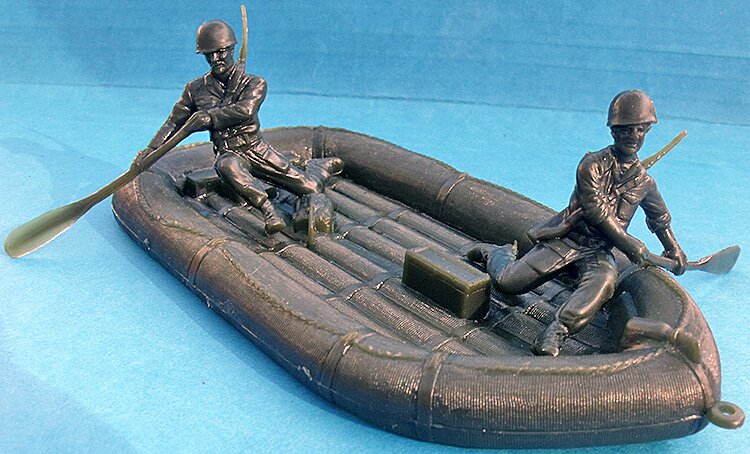 |
| 6. Large raft, measuring 5-1/2 inches long and 2-3/4 inches wide both rafe and figures shown are re-issue |
|
Later U. S. Tank
Marx introduced a new Tank 51 in 1958, which first showed up in the unique Battlefield Play Set. Made in soft plastic, the tank is 6-1/4 inches long -- an inch longer than Tank 41 above -- and has a turret-mounted machine gun. It's a beauty, but for the most part, it was included only in larger playsets.
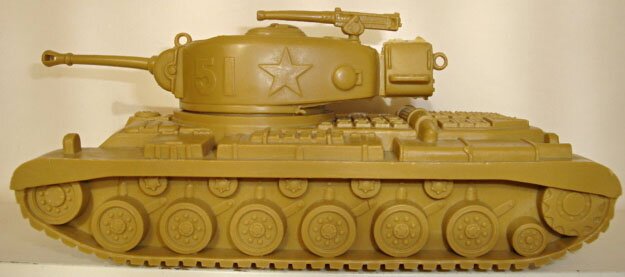 |
| Tank 51 Photo courtesy of Allan Ford, Ebay ID 610allanf |
| Recent Price Lines I have noticed | ||||
| $74 | November 2011 | Ebay | ||
| $76 | November 2011 | Ebay | ||
| $45 | March 2012 | Ebay | ||
| $59 | April 2013 | Ebay | Desert Fox tan | |
Marx also produced a few friction tanks, which could move on their own after being revved up by pulling them backwards on the rug. I am not aware that any of these were included in play sets, but some of them could have fit nicely into the sets. The one below is from the collection of David Schafer.
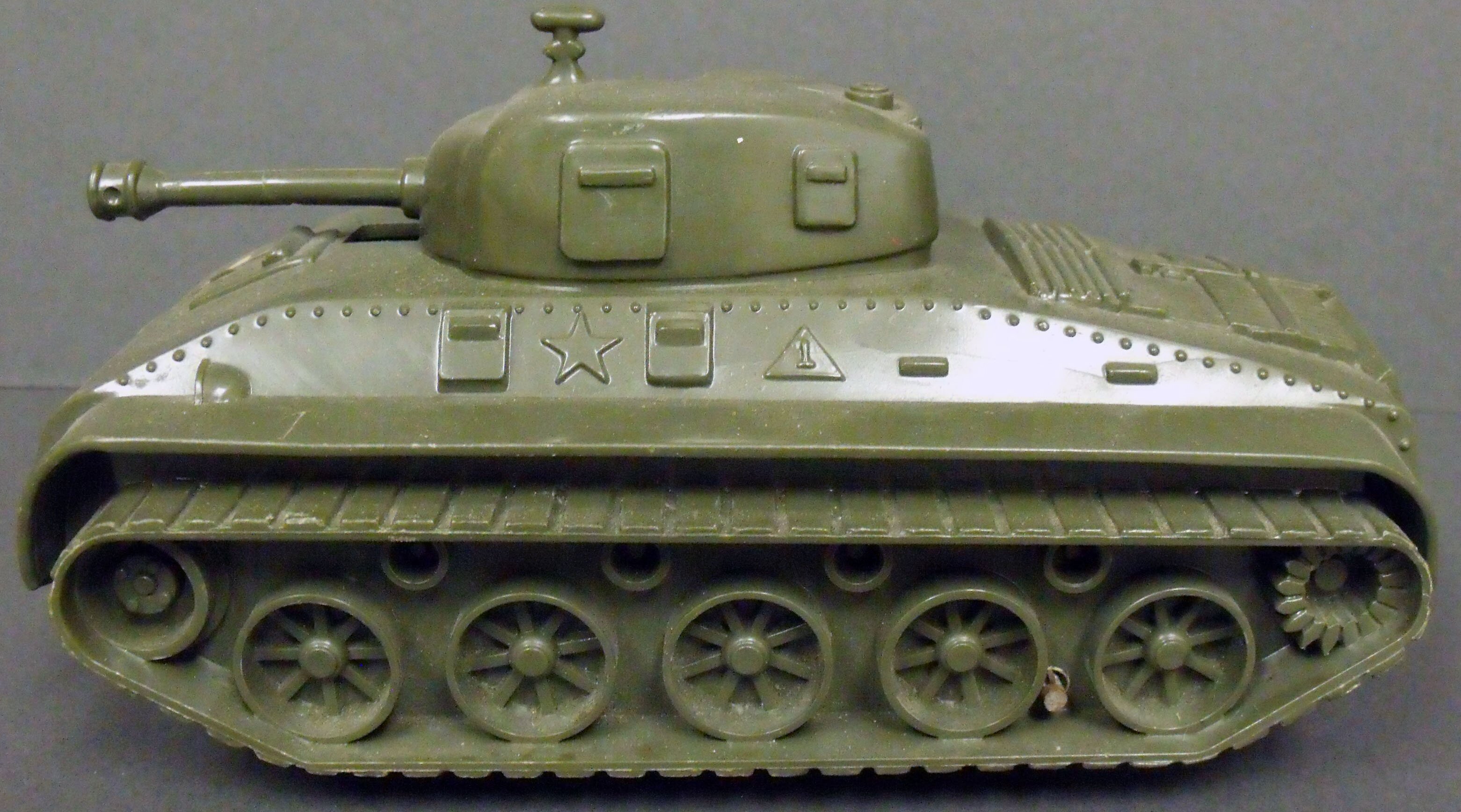
German Vehicle Set
PL-383
Marx' German vehicles are not nearly as well-detailed as the U.S. vehicles. Made in soft plastic gray, they were first issued in 1963 in the Battleground Europe Playset and were also in a few later sets. The motorcycle with side car is definitely the best of the three pieces, though all three added much needed enemy vehicles to the company's military sets
 |
| 1. Tank 351 |
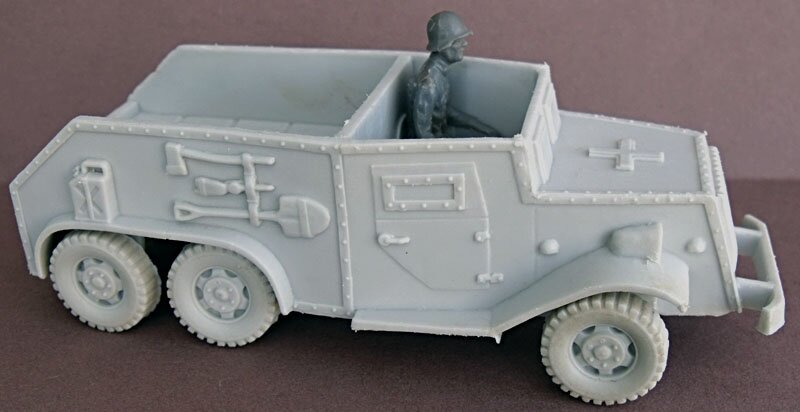 |
| 2. Armored personnel carrier Figure is seated German soldier shown on Military Figures page; back of carrier has room for six of the seated German figures. |
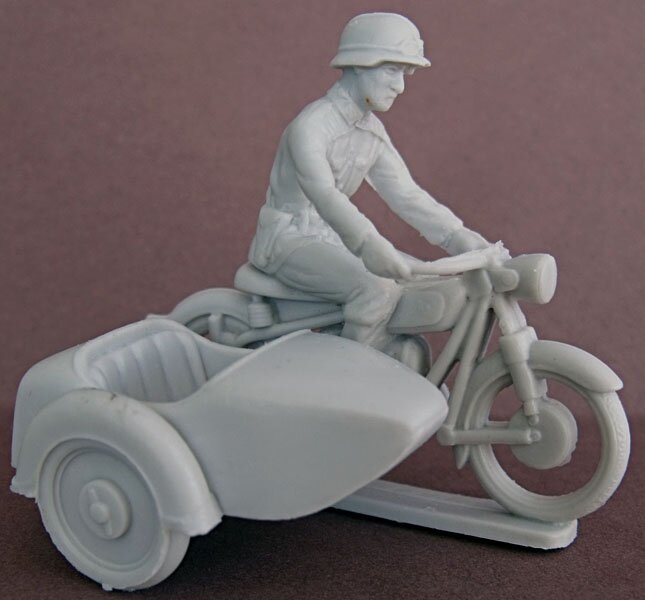 |
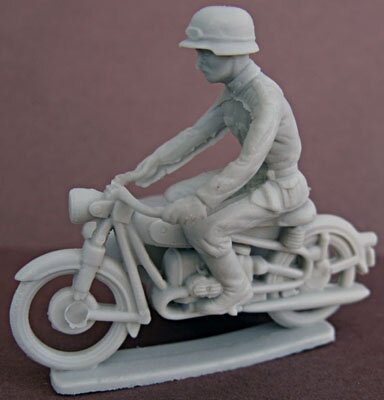 |
| 3. 2-piece motorcycle with driver and side car Driver is molded onto motorcycle; side car can be removed, if desired. Seated German figure shown on Military Figures page can be placed in side car by using a little force. |
|
Allied Vehicles
In a couple of late playsets, Marx included vehicles for the English and Russians. These, however, are simply the previously shown 6-piece U.S. vehicle group cast in different colors. I have none, and they are not often found. If I find any, I'll add photos -- or send me good photos of your own!

Aircraft
Though rarely seen, Marx included down-sized airplanes and airfield tractors in a few of its early Training Center playsets.
 |
| Airplanes included in a few early Training Center playsets Photo courtesy of collector Joe Henderson |
In 1954, Marx introduced its Army and Air Force Training Center playsets. These sets introduced the company's first three military aircraft: a Sabre jet, Banshee, and Navy Cutlass. These were intially made in silver hard plastic, but were later molded in metallic blue and in soft plastic. The Sabre is about 8-1/2 inches long, and the Banshee is about 7-1/2 inches.
Please note that many or perhaps all of the playsets with aircraft included various decals to attach to them. I have not researched information on these decals. I may or may not add such information in the future.
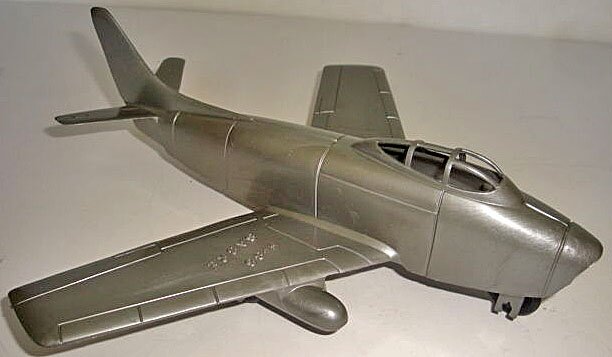 |
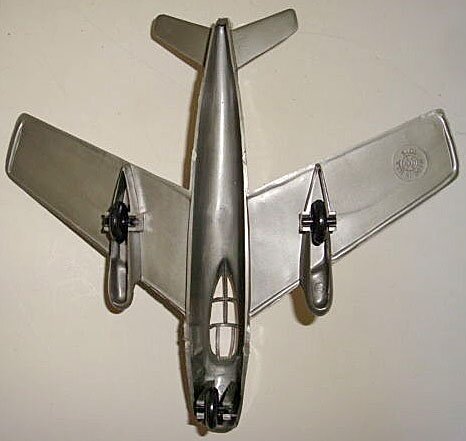 |
| F-86 Sabre jet Photo courtesy of Allan Ford, Ebay ID 610allanf |
Bottom of Sabre jet Photo courtesy of Allan Ford, Ebay ID 610allanf |
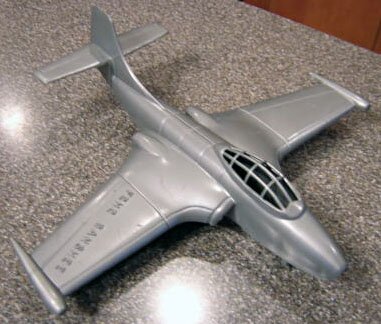 |
|
| 2. Banshee jet Photo courtesy of Ebay ID gtohall |
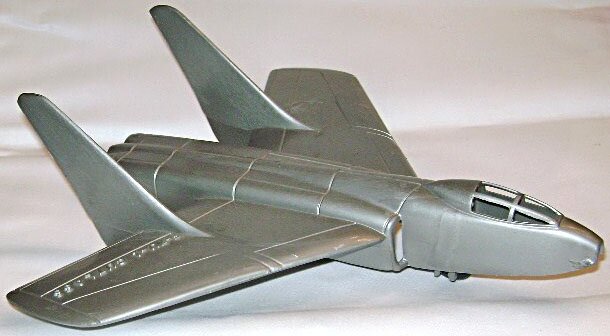 |
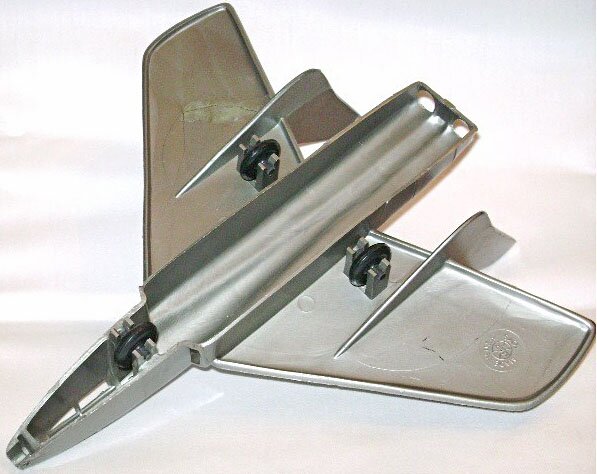 |
| 3. Navy Cutlass jet - top and bottom views Photos courtesy of Shannon Edwards, Ebay ID theworkingartist |
|
| Recent Price Lines I have noticed | ||||
| Banshee jet | $20 | May 2013 | Ebay | |
| Cutlass jet | $20 | June 2013 | Ebay | soft plastic blue |
| Banshee jet | $23 | June 2013 | Ebay | |
| Banshee jet | $25 | August 2013 | Ebay | partially painted |
| Sabre Jet | $70 | September 2013 | Ebay | |
| Sabre Jet | $33 | September 2013 | Ebay | |
| Sabre Jet | $150 | October 2013 | Ebay | With 11 bids, this is an example of what happens when a bidding war gets out of hand |
| Sabre Jet | $24 | October 2013 | Ebay | |
| Sabre Jet | $29 | October 2013 | Ebay | |
| Banshee jet | $29 | October 2013 | Ebay | |
Marx introduced a military helicopter in 1956 during the Armed Forces Training Center period. It is a 7-piece item that was made first in metallic blue and later in silver and olive drab soft plastic. It is about nine inches long. Eventually, for Battleground sets, it was modified to include an operating winch that allowed us kids to deliver military equipment to the front line and rescue injured troops.
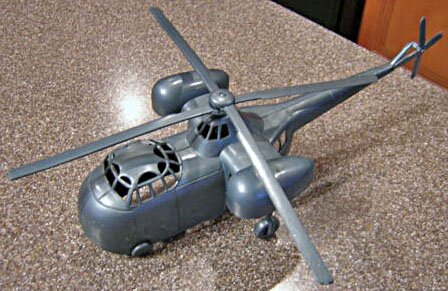 |
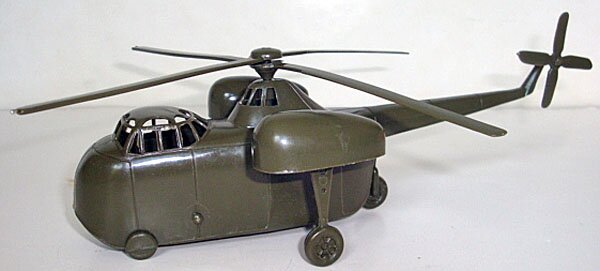 |
| 4. Helicopter Photo courtesy of Ebay ID gtohall |
4. Helicopter Photo courtesy of Allan Ford, Ebay ID 610allanf |
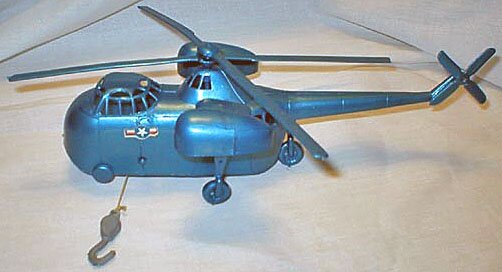 |
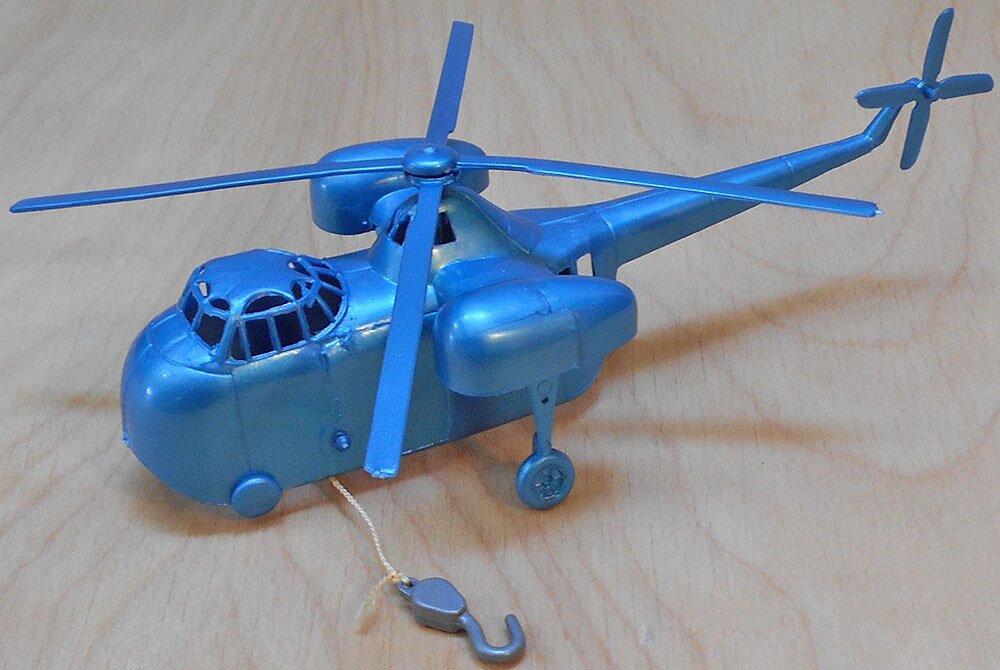 |
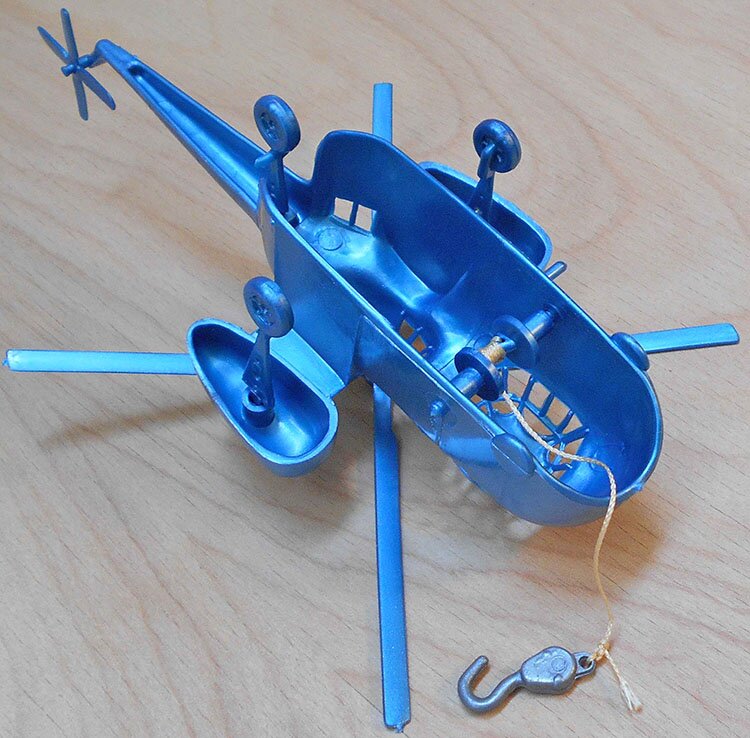 |
| Helicopter with winch Photos courtesy of veteran seller and collector Kent Sprecher and collector Bob Spreitzer |
Underside of helicopter Photo courtesy of collector Bob Spreitzer |
|
| Recent Price Lines I have noticed | ||||
| $36 | May 2013 | Ebay | metallic blue | |
| $37 | May 2013 | Ebay | metallic blue | |
| $31 | June 2013 | Ebay | metallic blue | |
The company's 10-piece rocket-shooting jet was introduced in its 1959 Battleground playsets. The Delta-wing jet held a spring-powered rocket under each wing. Six rockets came with each set, but most were surely lost by us kids within a few days.
The rocket-firing jet was also in Marx' Army Combat Training Center sets, as well as a metallic silver soft plastic flying helicopter. The helicopter "flys" with the aid of a wind-up base. PFPC quotes Rick Koch as saying that the helicopter appeared in only a few deluxe playsets. The helicopter was also made in a metallic blue color.
Both the rocket-firing jet and flying helicopter were also in one space playset, the 1961 Sears Deluxe Cape Canaveral Play Set (#4536). The helicopter there was silver, but, according to Playset Magazine Issue 37, the Cape Canaveral jet came in a unique mixture of colors: "...mixed blue semi-hard plastic, with silver rocket pods, rockets, and landing gear, or can be found in reverse with silver plane and blue accessories."
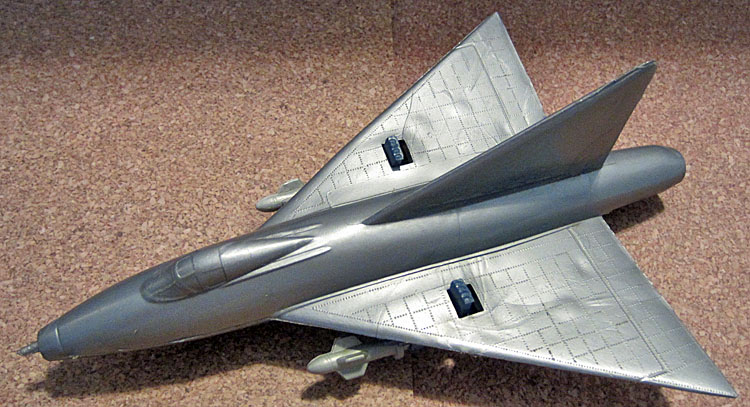 |
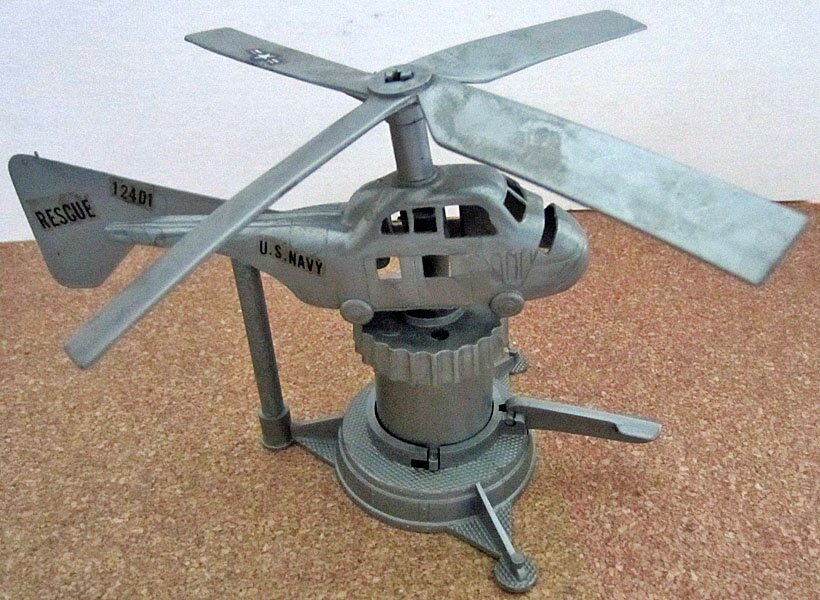 |
| Rocket-firing jet Photo courtesy of Phil Webb |
Flying helicopter (PL-1098 and 1098A) Photo courtesy of collector Phil Webb |
| Recent Price Lines I have noticed | ||||
| Rocket-firing jet | $31 | April 2013 | Ebay | with rockets, nice deal for the buyer |
Additional U.S. planes were added in 1963. The most commonly seen were the P-51 Mustang and the P-47 Thunderbolt, usually included with larger playsets that had paratrooper figures. Both were molded in silver hard plastic with black snap-on wheels. In the biggest sets, a P-39 was included with a shell-firing spring mechanism that fits into the nose of the plane. The shell is then fired through a hole in the the hub of the propeller. The P-39 is very difficult to find today.
PL-1189 (propellers and wheels PL-1190 and -1191)
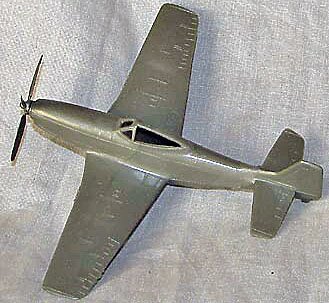 |
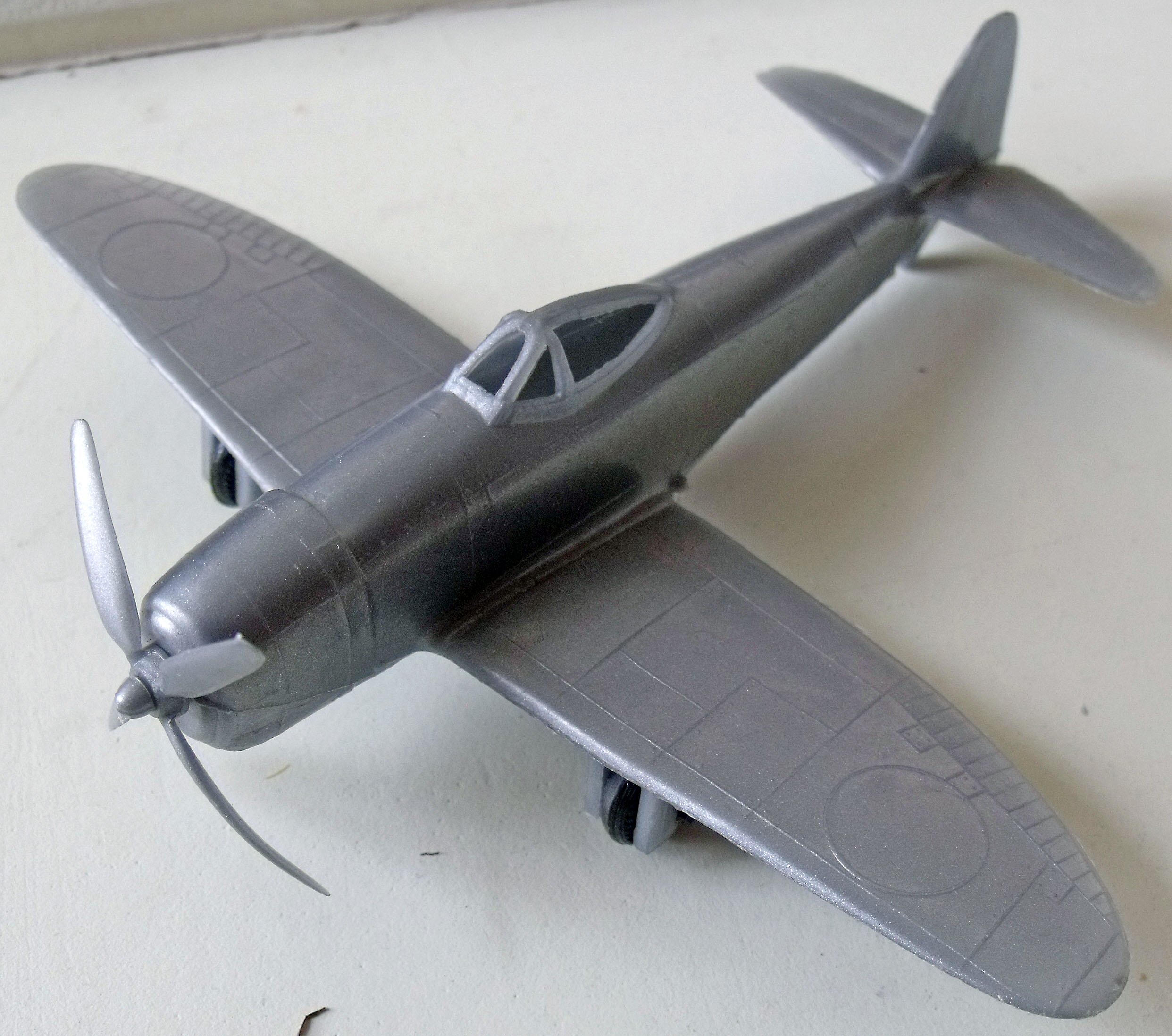 |
| 7. P-51 Mustang | 8, P-47 Thunderbolt |
| Recent Price Lines I have noticed | ||||
| P-51 Mustang | $16 | May 2013 | Ebay | |
| 10. Shell-shooting P-39 |
A year later in 1964, with the addition of enemy Japanese figures, Marx introduced a Japanese Zero fighter plane in silver with separate black wheels.
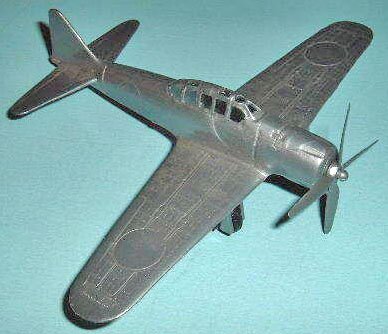 |
| 11. Japanese Zero airplane Photo courtesy of Rick Koch, Ebay ID toy-hood |
| Recent Price Lines I have noticed | ||||
| $28 | October 2013 | Ebay | nice price, wish I had bid! | |
With the Strategic Air Command Play Set in 1963 and 1964 came B-52 bombers -- seven in each set! They were unavoidably down-sized; Playset Magazine Issue 54 notes that if in scale, they would have been three feet long. Apparently, kids loved to play with them, because even if you miraculously find an SAC Playset for sale, the B-52 bombers are often missing!
| B-52 Bomber |

Artillery, Rockets, and Other Guns
With the release of its Army Training Center sets in 1952, Marx introduced two operating accessories, a short-barreled howitzer and a machine gun on a tripod. Both were molded in olive drab soft plastic (the machine gun later in silver) with spring mechanisms that fired individual shells. According to PFPC, Marx produced the machine gun over a span of two decades, but included it only in the larger playsets. The short-barreled howitzer was around only until 1958 or 1959, when it was replaced by the long-barreled version below.
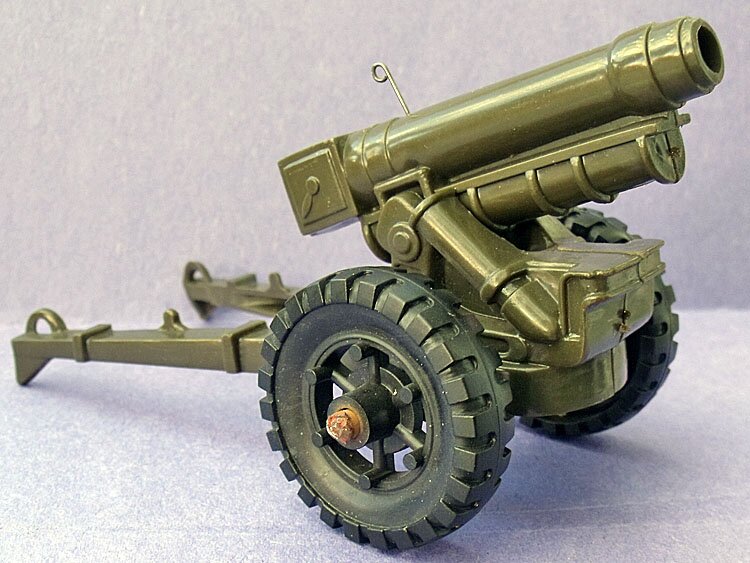 |
 |
| Short-barreled howitzer | Sprue of howitzer shells |
| Recent Price Lines I have noticed | ||||
| $28 | February 2013 | Ebay | minor damage, good deal for buyer | |
| $46 | October 2013 | Ebay | with sprue missing one of ten shells | |
A shell-shooting machine gun was also introduced in the mid-1950s. It came with a sprue of 10 shells, but did not actually fire them machine gun style.
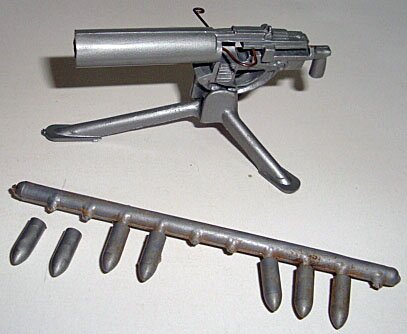 |
| Shell-shooting machine gun Photo courtesy of Allan Ford, Ebay 610allanf (PL-440) |
| Recent Price Lines I have noticed | ||||
| $48 | November 2011 | Ebay | with sprue of shells | |
| $34 | September 2013 | Ebay | silver with shells, eight on sprue | |
| $21 | September 2013 | Ebay | olive drab, no shells, good deal for buyer | |
| $52 | October 2013 | Ebay | with sprue of shells | |
In 1956, Marx added the Nike missile launcher to some military playsets, made in silver or orange hard plastic and equipped with a spring machanism to fire missiles. The launcher came with three soft plastic missiles, one each in red, yellow, blue, or white. Holes in the rear of the launcher base hold the two spare missiles in an upright position, and a larger hole is for the small compass shown in the photo below..
The identical item -- but without the compass -- also was included in some space playsets.
 |
| Nike missile launcher Photo courtesy of Rick Koch, Ebay ID toy-hood |
| Recent Price Lines I have noticed | ||||
| $32 | September 2013 | Ebay | ||
| $24 | October 2013 | Ebay | with three red rockets | |
The field cannon was one of the six items included in the 6-piece vehicle group described above under the 54mm Vehicle section. The group was introduced in 1958 in the Battleground playsets. The non-firing cannon was made to be towed by the group's tank, halftrack, or jeep.
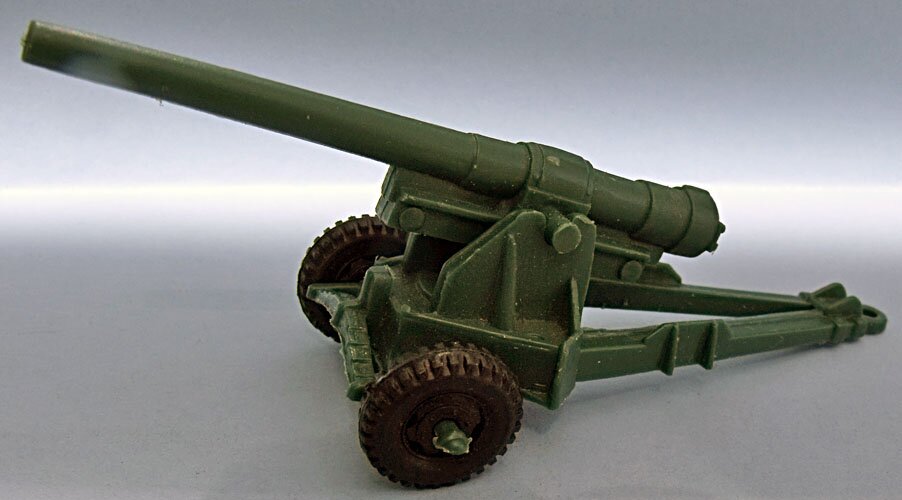 |
| Field cannon (Part of the 6-piece vehicle group shown above) |
Another cannon that made its debut as part of the Battleground playsets in 1958 was the long-barreled howitzer, replacing the short-barrled howitzer of 1952. It was made in metallic silver hard plastic with a spring mechanism that fired shells. Two sprues of ammunition were included, each with five shells. The cannon remained Marx' primary big gun until the company's demise, but according to PFPC, underwent three revisions related to its firing mechanism.
Playset Magazine Issue 9 states that the initial version was a "pull and shoot" breech loader, in which the breech at the rear of the gun was pulled out, the shell was placed in, and the breech was released to fire. The second version came in 1960; this one allowed the breech to be pulled out and locked into place to load the shell. The breech was then tapped loose to fire the shell. A third version in 1964 required the shell to be loaded into the front of the barrel, then fire with a stiff L-shaped metal pin in the breech. The final revision was the removal of the firing mechanism due to new child safety laws.
The howitzer is about seven inches long and three inches tall at its highest point.
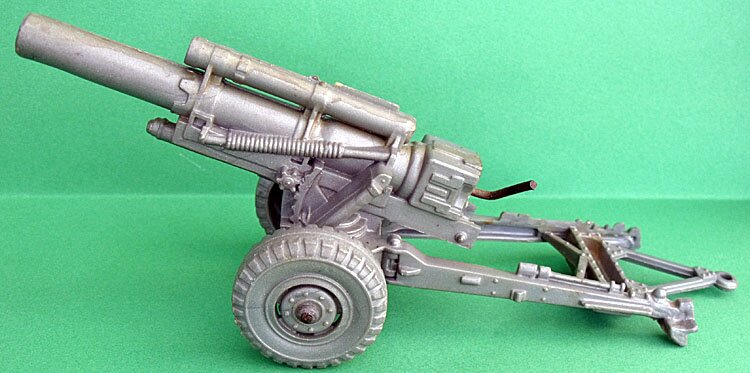 |
|
| Long-barreled howitzer (PL-943) Third version with L-shaped metal pin. |
|
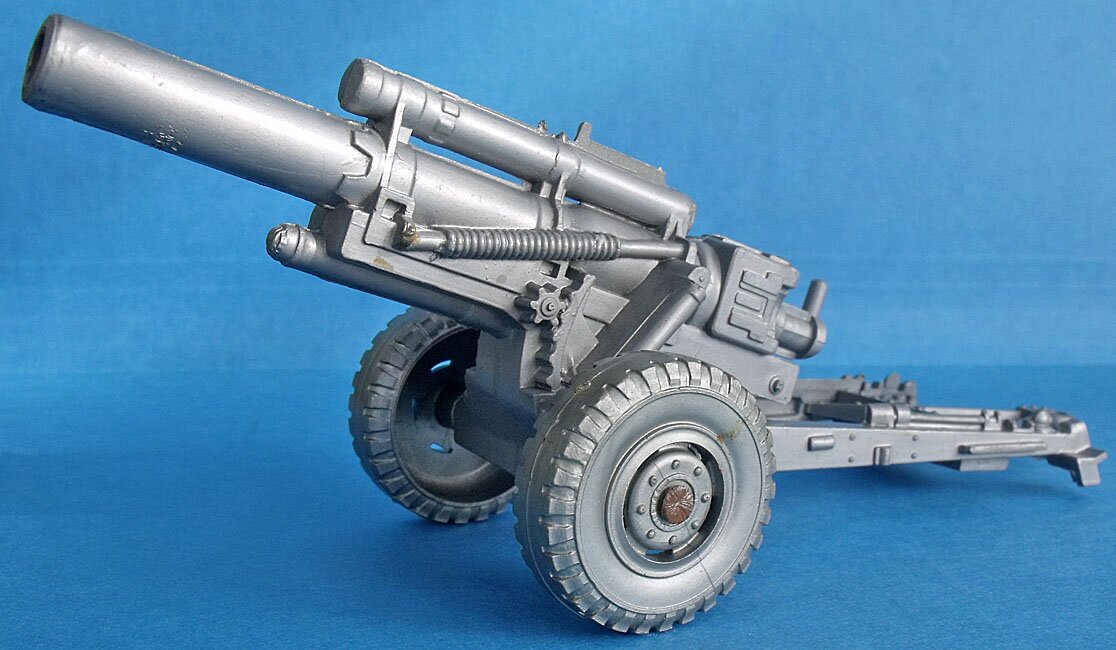 |
|
| Long-barreled howitzer (PL-943) Version in which breech is pulled out and shell placed directly into breech. |
|
 |
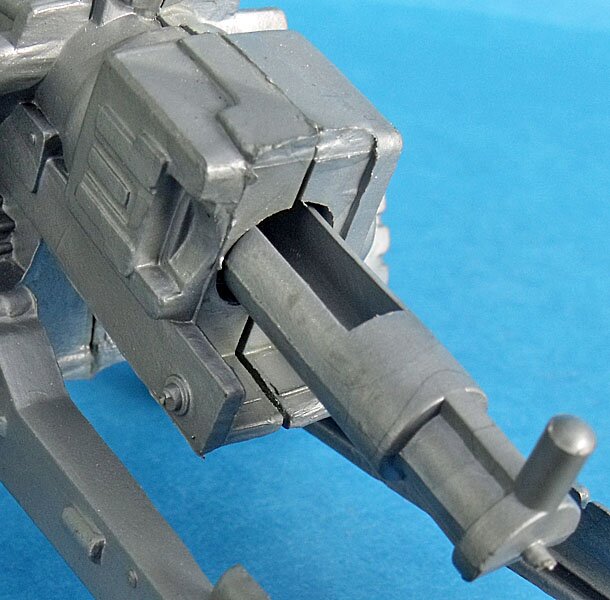 |
| Close-up of breech on breech-loaded version | Close-up of shell compartment in breech on breech-loaded version |
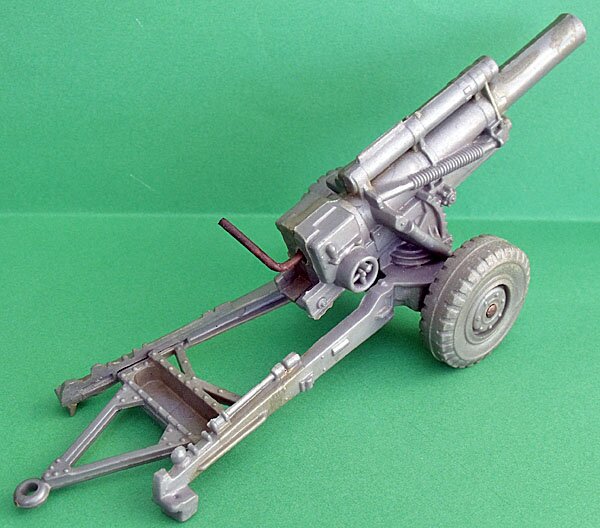 |
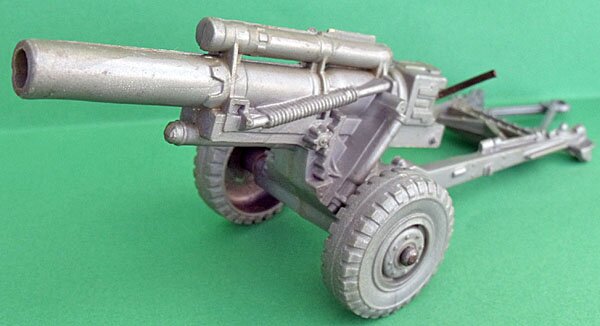 |
| Back side of howitzer Third version with L-shaped pin to fire shells |
Front side of howitzer |
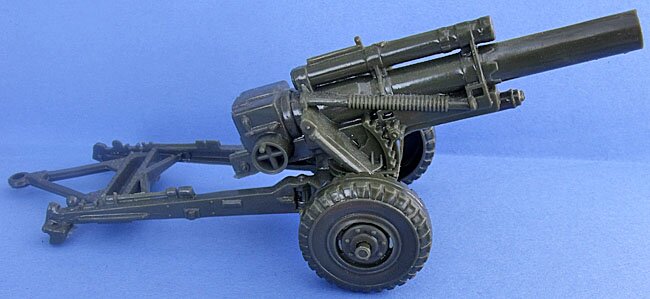 |
|
| Re-issue howitzer in olive drab (non-firing) | |
The BOMARC missile was a long-range, anti-missile weapon. Marx made the missile in black, sittin on an attractive orange platform. Both the missile and platform are soft plastic. The platform is in three pieces -- base, turret, and boom -- and the missile is made up of the body and a small nose cone. The launcher is a bit more complicated that most of the company's missiles and rockets, with a boom that can swivel on its base, as well as raise and lower.
It is the company's only rubber-band powered launcher. Without instructions, figuring out how the launcher fires can be a bit tricky; a copy of a playset instruction sheet below explains the configuration of the rubber band. The boom's runner then is locked into place near the bottom of the boom, and a push on the trigger releases the runner and sends the rocket flying. I do not have an original rubber band and am not sure how far the missile originally traveled, but the strongest rubber band I have felt safe in using (without damaging the launcher) sends the missile about eight feet when the launcher is set at about a 45 degree angle.
The identical missile and launcher were included in some space playsets also.
 |
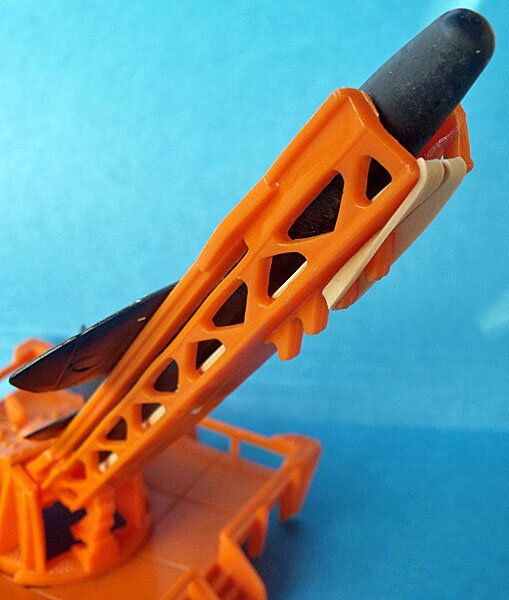 |
|
| Bomarc missile launcher | Launching instructions from playset instruction sheet | Ready to launch with rubber band attached to one of four hooks below the boom (rubber band is not original) |
| Recent Price Lines I have noticed | ||||
| $10 | April 2013 | Ebay | item from Cape Canaveral set | |
| $23 | June 2013 | Ebay | with 5 figures and 2 other small accessories | |
| $24 | October 2013 | Ebay | this was me | |
Among the German accessories released in 1963 was an 88mm cannon molded in gray hard plastic. Initial cannons were shell-shooting with a spring mechanism located toward the front of the barrel. This was later removed to comply with new child safety laws.
The cannon came in two pieces (base and gun), with a separate spring mechanism that was inserted into a slot in the barrel. The gun itself is actually two pieces, which were glued together at the factory. On the one I have, you can see traces of the yellow glue along the contact line. Also included with the shell-shooting version was a sprue of 10 shells.
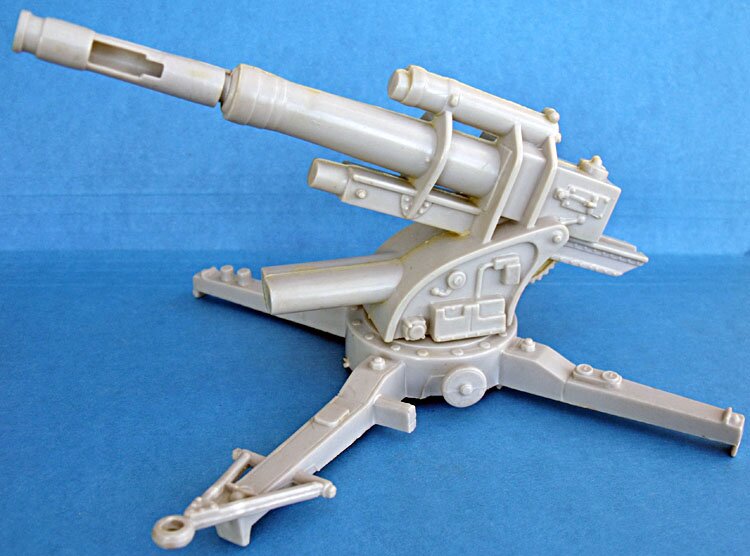 |
 |
| German 88mm artillery gun (non-firing version) Hole in side of front barrel is for firing spring. |
Shells for German artillery gun Shells are about 3/4 of an inch long, two are missing from the sprue |
| Recent Price Lines I have noticed | ||||
| $20 | December 2011 | Ebay | no spring | |
| $41 | March 2012 | Ebay | ||
| $41 | September 2012 | Ebay | firing with shells | |
In the early 1960s -- apparently at the same time the German 88mm artillery gun was introduced -- Marx created a camouflaged artillery cover for its larger military sets. Both PFPC and Playset Magazine Issue 4 report that it is most often found with sets that include the German 88mm artillery gun, and Playset Magazine reports that former Marx employee Al Bagg said that the cover was designed to go with the German gun.
The cover consists of a thin piece of camouflage-colored plastic that fits onto brown hard plastic poles and is held in place by small cap pieces placed on top of the poles. Photos of the gun and cover in Playset Magazine Issue 4 show that they are very attractive pieces when placed together. Unfortunately, the the camouflage cover and the poles are fragile and when found today are often in poor shape.
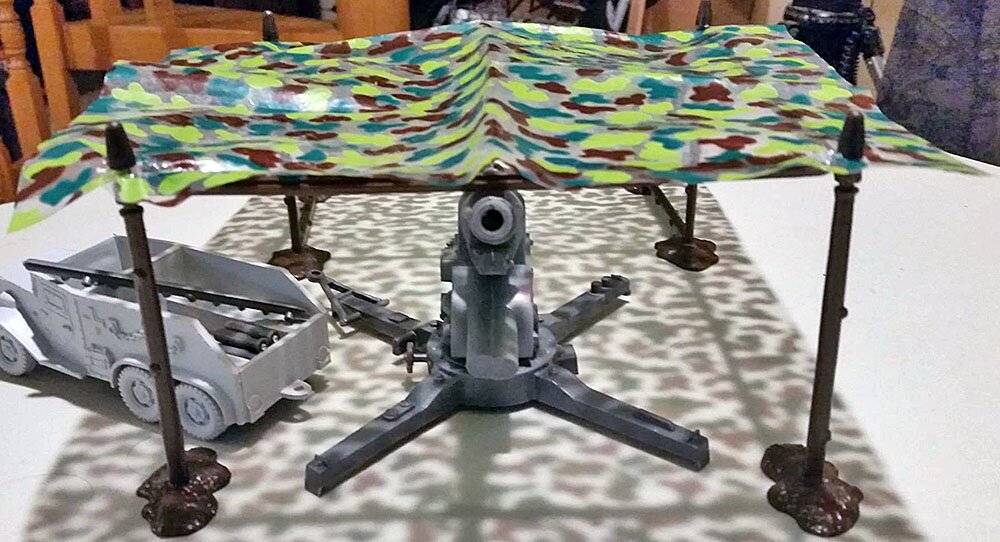 |
| Assembled camouflage artillery cover Slanted support rods shown below are at the back in the photo above Photo courtesy of collector Terry Isbell |
The artillery cover pieces shown below were sold by Allan Ford on Ebay in February 2016 for $385. Allan did not assemble the pieces, because assembling will cause tears or holes in the camouglage cover where support rods are inserted. Items shown in these photos are not in scale with one another, and I do not presently know the measurements of the piece.
| All photos of camouflage cover below are courtesy of seller Allan Ford, Ebay ID 610allanf | |
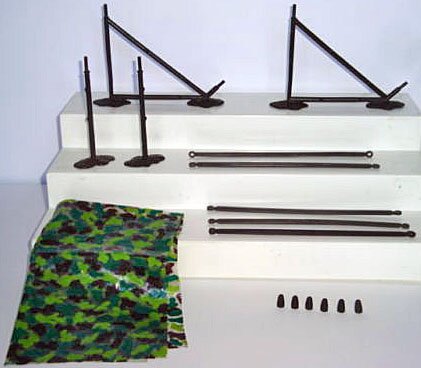 |
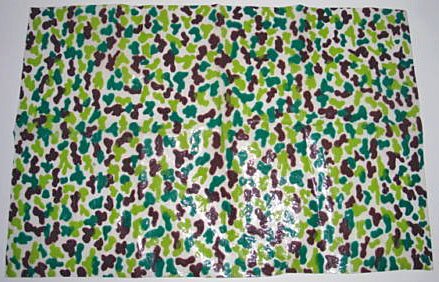 |
| Unassembled pieces camoulaged gun cover | Thin plastic camouflage cover |
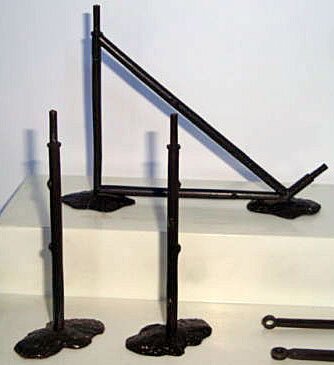 |
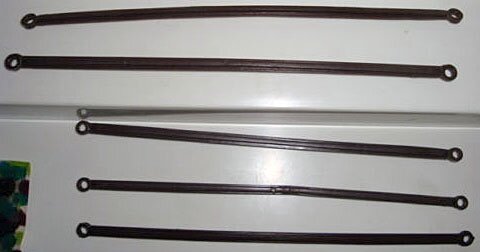 |
| Poles for frame The piece includes two straight poles and two triangular pole frames. |
Cross bars for frame The piece includes five cross bars. |
 |
|
| Caps for tops of poles The caps hold the plastic cover in place. |
|
| Photos above are courtesy of seller Allan Ford, Ebay ID 610allanf | |

24-Piece Terrain and Accessories Group - 54mm Playsets
PL-933
I have seen this listed as a 22-, 23-, and 24-piece group of battlefield accessories. I count 24, including two pieces to make up the pontoon bridge and the recoiless rifle, plus four landmines and two each of the flag and rag mine markers. Marx first included this group in its new Battleground Play Sets in1958. These accessories became a standard for all later military playsets.
All items were made of hard plastic in some shade of brown and tan. Marx made many with marbled plastic, which adds depth to the pieces. Marbled plastic is simply one basic color of plastic with a few other colors of plastic added in random dabs while mixing the molten plastic. You can see the effect in the second photo of the destroyed building below.
Playset Magazine Issue 33 notes that for Marx' 1963 D-Day Landing Set, the company created a PL-933C solely to make extra pillboxes (item 1 below). Two extra pillboxes were included in each set, making a total of three in the smaller D-Day sets and four in the larger ones. This was offset by dropping the destroyed building (item 3 below) from PL-933, though the magazine article states that at least some of the smaller sets also ended up with the building.
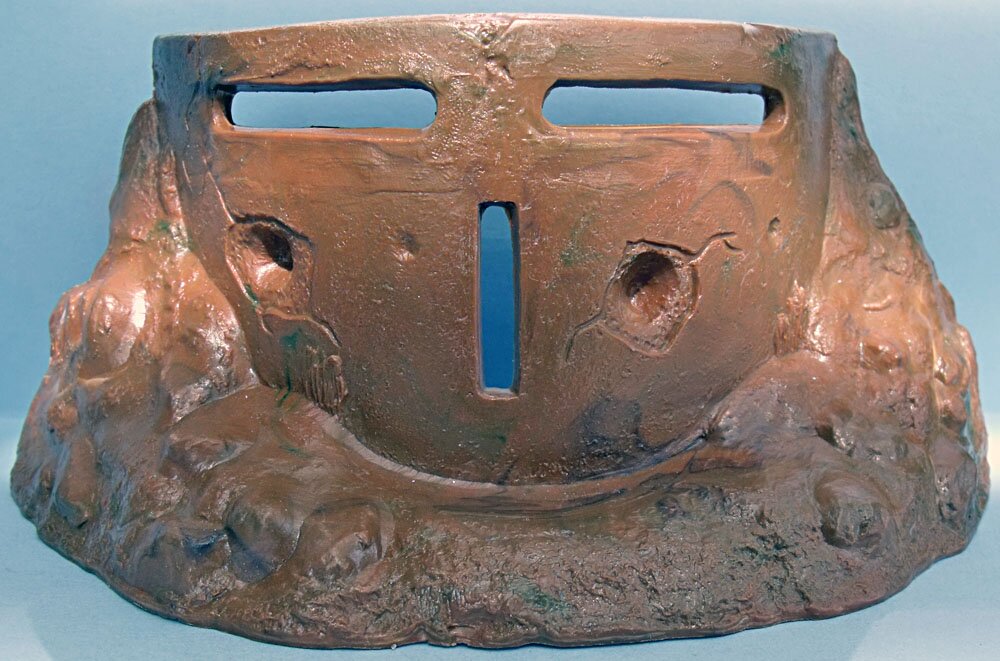 |
| 1. Pill box |
 |
| 2. 2-piece potoon bridge |
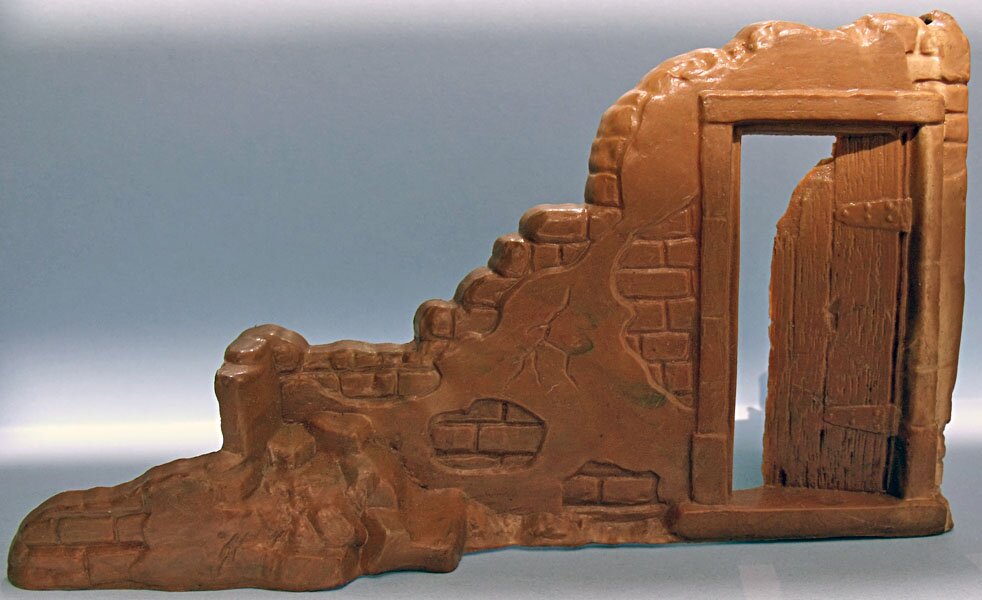 |
| 3. Destroyed building |
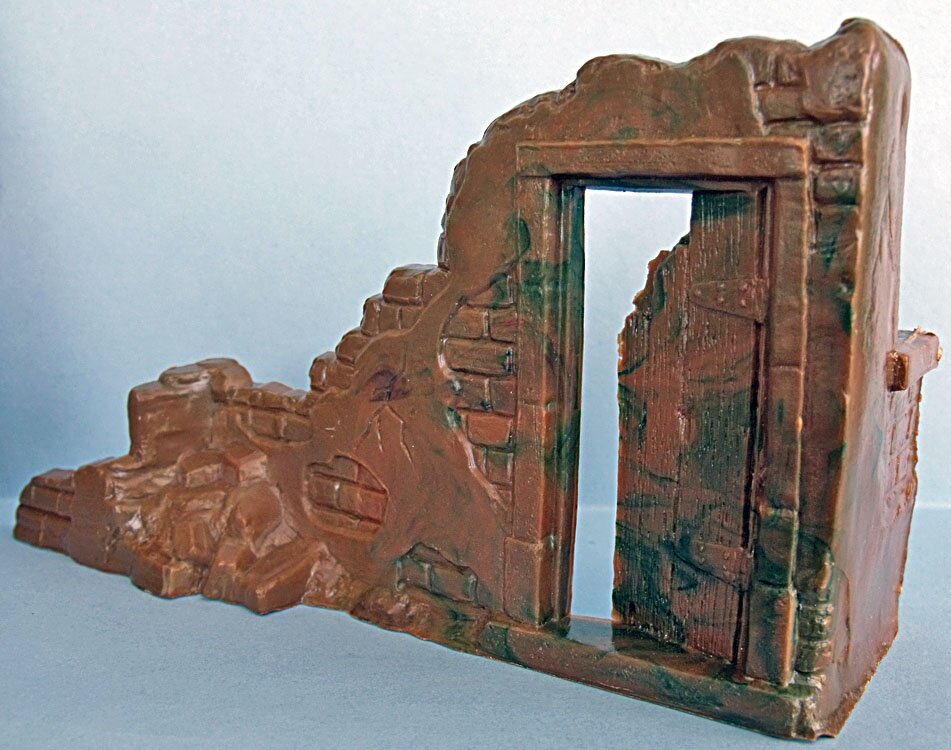 |
| 3. Second view of destroyed building (with marbled plastic) |
 |
| 4. Log and barbed wire barricade Photo courtesy of Samm Graci Barricade is shown smaller than other accessories; it is about 9-1/2 inches wide. |
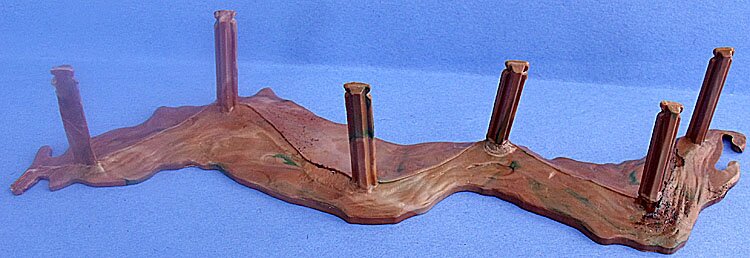 |
| 5. Barbed wire barricade About 6-3/4 inches wide |
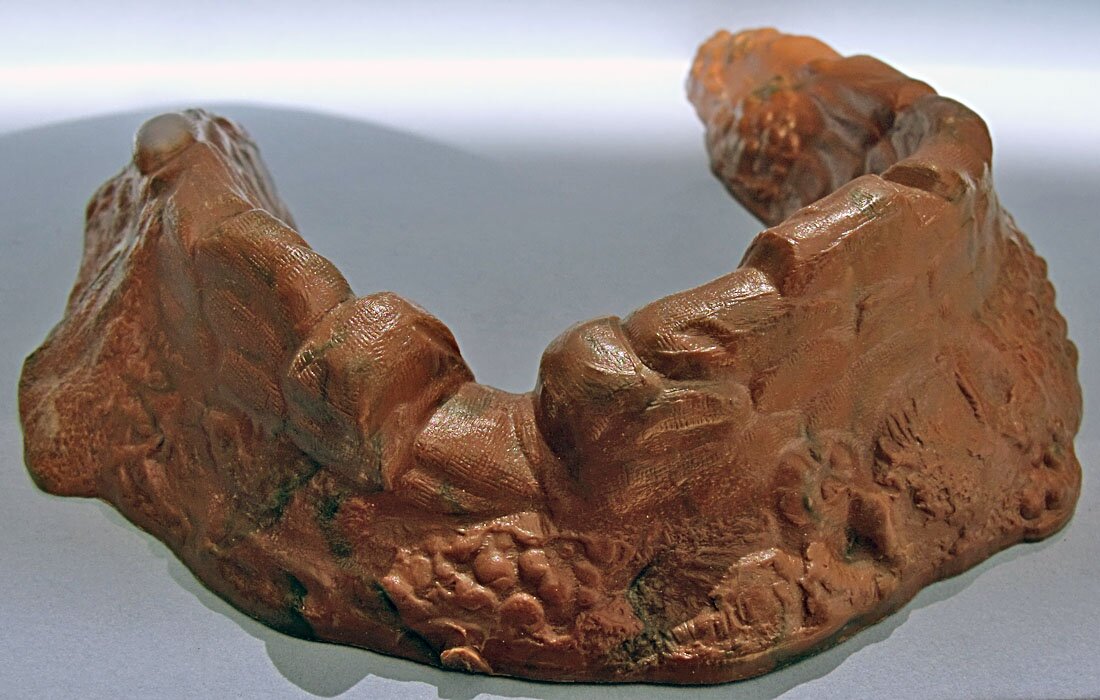 |
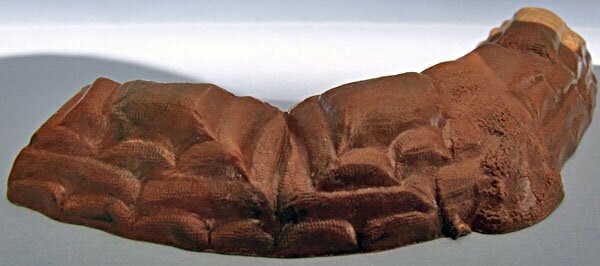 |
| 6. Large gun emplacement | 7. Small gun emplacement |
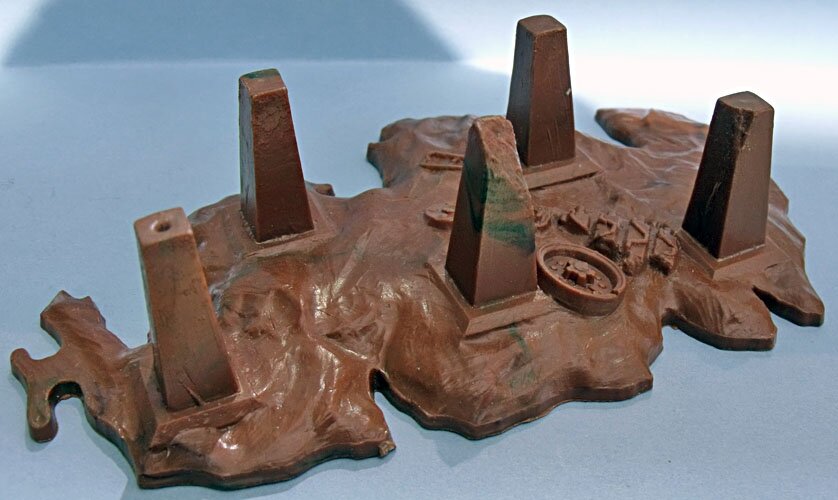 |
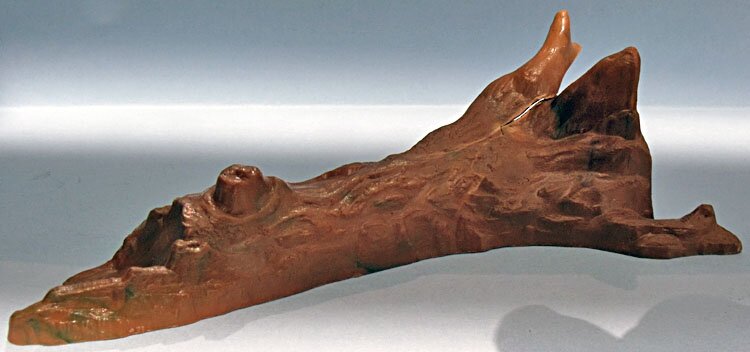 |
| 8. Tank barricade | 9. Fallen tree |
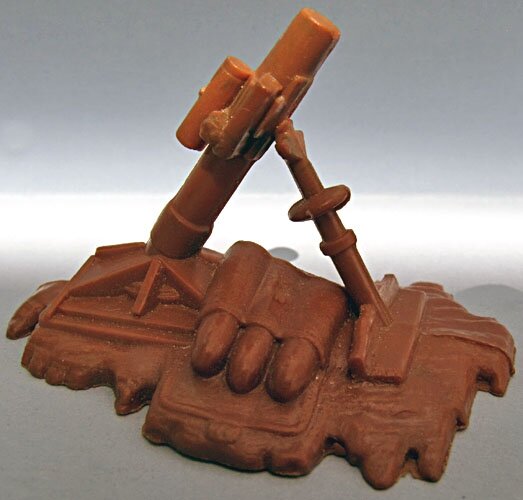 |
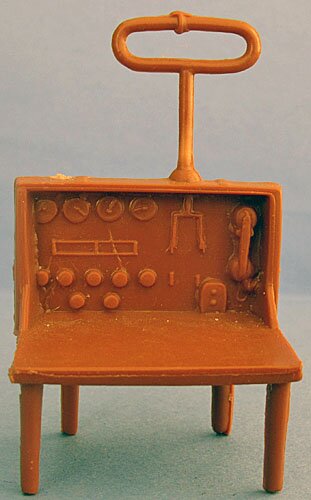 |
| 10. Mortar | 11. Radio on table About 2-1/4 inches high |
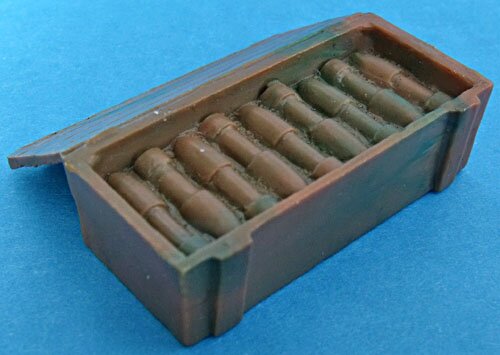 |
 |
|
| 12. 2-piece recoiless rifle with separate tripod | 13. Crate of mortar shells |
14. Crate of medical supplies |
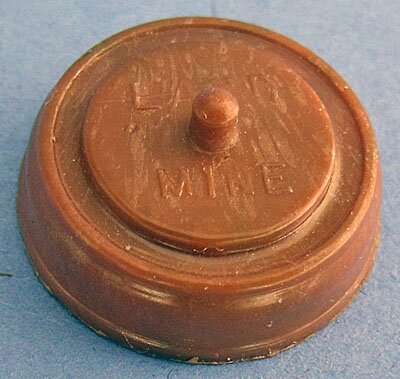 |
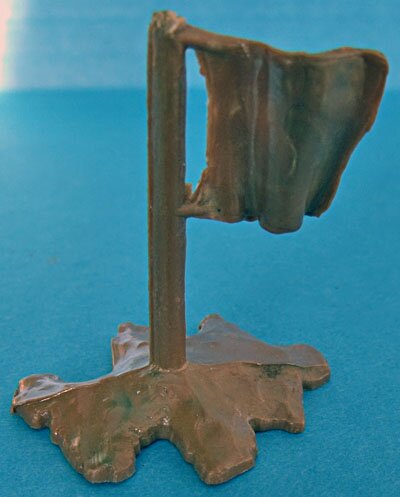 |
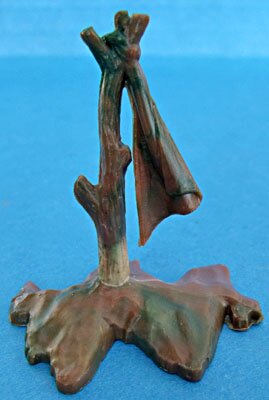 |
| 15. Landmine |
16. Mine marker flag |
17. Mine marker rag |

35-Piece Weapons Sprue
PL-882
The 35-piece military weapons sprue was first included in the company's final large Armed Forces Training Center Set, #4156. Containing small pistols, rifles, grenades, and other military items, the sprues were initially made in olive drab soft plastic, but were later molded for Battleground sets in other colors such as silver, dark green, and black. The entire sprue is about 4-1/2 by 9 inches.
Similar sprues were included in other theme playsets -- such as Wild West, Civil War, and Service Stations -- and added greatly to the set's "piece count," an important selling point for playsets in the 1950s and 1960s.
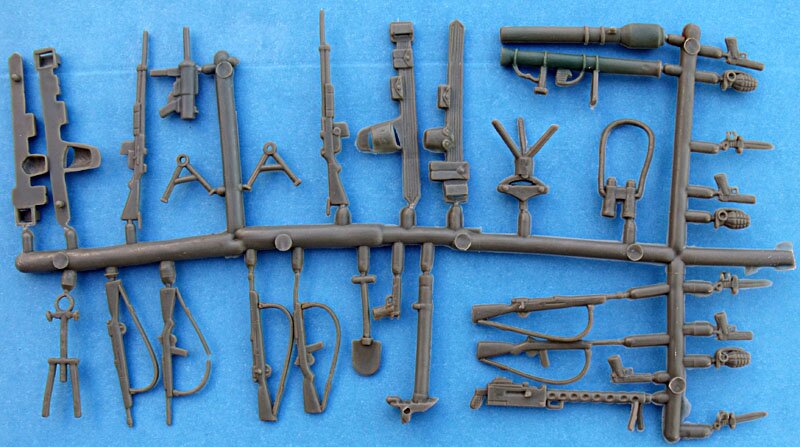 |
| Military Weapons Sprue Sprue shown is missing its second grease gun which should be opposite the grease gun attached, in the upper left of the photo just above the two bipods. |

Exploding Accessories
According to PFPC he first exploding accessory was a small building that showed up in the hard-to-find Battle Field Play Set in 1958. I remain uncertain whether this is accurate, as noted below on the exploding building which Marx introduced in 1964.
| Exploding building |
The next year (1959) the company's more easily found exploding machine gun nest (or bunker) was included in Battleground playsets and also showed up in the final, large Armed Forces Training Center Set. It explodes when the target extending from the front of the machine gun next is struck.
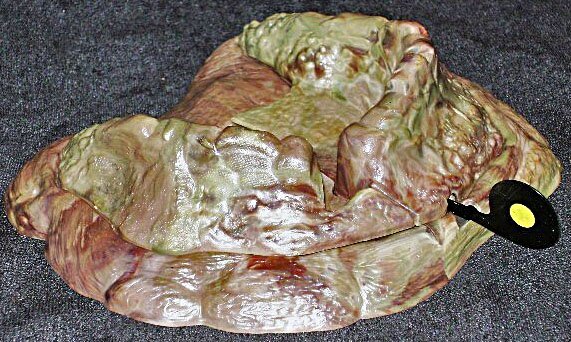 |
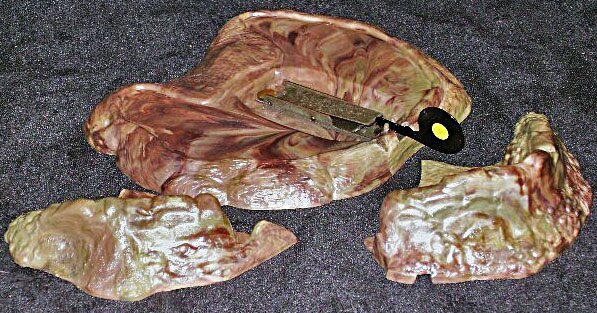 |
| Exploding machine gun nest (PL-1056) Photos courtesy of Shannon Edwards, Ebay ID theworkingartist |
|
In 1962, Marx added its "exploding mountain," though small hill might be a better term for it. This same mountain was used in Moon Base playsets. For military sets, it was molded in a marbled brown hard plastic. It is made of four pieces that fly apart when a spring mechanism is activated by pretty much anything that strikes the small piece at the top of the mountain. Of course, us collectors today would have liked to see an exploding mountain the size of the Guns of Navarone/Iwo Jim mountain discussed later on this page, but that probably would not have complied with child safety laws even back in the 1960s!
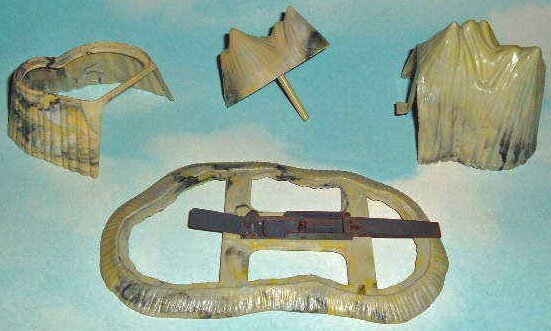 |
| Exploding mountain (PL-1163) Photo courtesy of Rick Koch, Ebay ID toy-hood |
| Recent Price Lines I have noticed | ||||
| $60 | March 2012 | Ebay | Price seems very low | |
PFPC and Playset Magazine Issue 4 state that 1964 American Patrol playsets introduced an exploding house, which was included only in American Patrol and Battleground Europe sets. It goes on to state that the 5-piece marbled brown hard plastic house exploded with a spring mechanism in the same manner as other exploding pieces. The trigger was the door, so I'd imagine it was intended to represent a cleverly-made booby trap. On the other hand, a random mortar or artillery shell might be just as good.
I am a bit confused on the origination of this exploding building, because PFPC states that an exploding building was included in the hard-to-find Battle Field Play Set in 1958 (as noted above), but provides no details on it. Based on other information I have found, I believe that this was an error by PFPC, but am not certain. As noted in the previous paragraph, the same PFPC article also states that the accessory was introduced in the American Patrol Play Set.
| Exploding building |
One final and somewhat odd blow-it-up accessory was an exploding submarine. According to Playset Magazine Issue 37, this item was in only two playsets, one military set (not identified) and the 1961 Sears Deluxe Cape Canaveral Play Set (#4536). According to Playset Magazine, the submarine was eight inches long, made in silver-gray hard plastic, and exploded with a "mousetrap-like spring mechanism." As many Marx accessories, it was grossly undersized for the rest of the playset.
The sub was made up of two body halves, a small tower that fits atop the sub, a small array of antennas that attach to the tower, and the exploding mechanism. Any disturbance to the top of the submarine would dislodge the parts and send them flying. Playset Magazine notes the sub was so delicate that its parts were often damaged the first time it was "exploded." Obviously, it is rarely found in today's market...and is expensive.
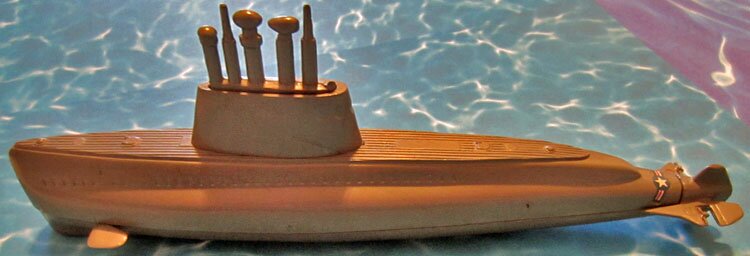 |
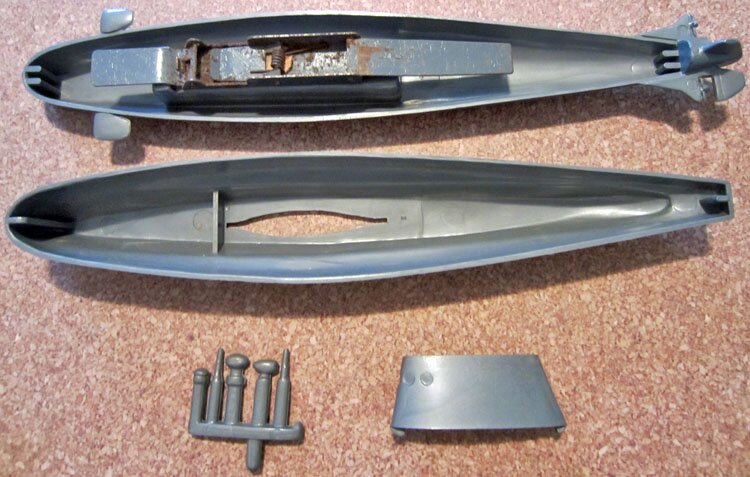 |
| Exploding submarine Photos courtesy of collector Phil Webb |
|

Flags
Army Training Center sets, first sold in 1952, included only the 48-star U.S. flag, the same flag as used in many other Marx playsets. Early military sets included the company's round log flagpole with rock base, but later playsets had the second version of a square pole with a cement base, as shown on the German flag below. Both types and poles are the same size.
The German and Japanese flags were produced when Marx added enemy figures to its sets in 1963 and 1964 respectively. The British, French, and Russian flags were added in 1965 with the Battleground Europe Play Set, which included five flags, missing only the Japanese.
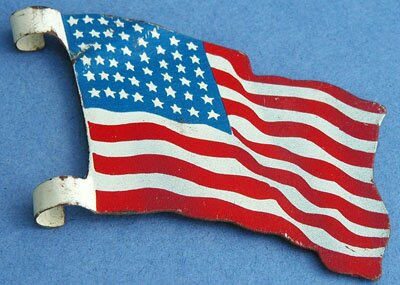 |
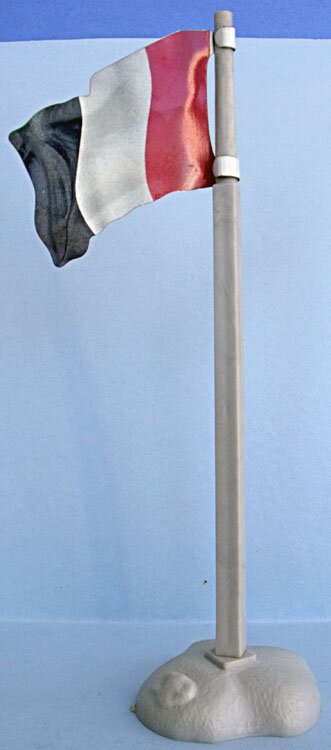 |
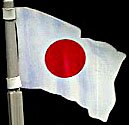 |
| 1. 48-star U.S. Flag | 2. German Flag | 3. Japanese Flag Photo courtesy of Kent Sprecher of Toy Soldier HQ |
| 1. British Flag | 2. French Flag | 3. Russian Flag |
| Recent Price Lines I have noticed | ||||
| French flag | $40 | January 2012 | Ebay | with pole and base |

Fences
According to Plastic Figure and Playset Collector magazine, early Army Training sets included the split-rail fence used in Wild West playsets, usually in white. Later military sets had dark brown or silver fencing. This was the only fencing included in military sets until the late 1950s.
 |
| Split rail fence |
 |
| Barbed wire fence (PL-939) |
Concertina wire was added in the early 1960s, generally made in gray soft plastic. The pieces came flat, with tabs to hold it in place when bent into a cylindrical shape.
 |
| Concertina wire Note tabs at bottom of fence that keep it rolled. |

Terrain pieces
Beginning with its larger Army Training Center sets, Marx included a variety of terrain pieces in military playsets. These were the same as trees, rocks, and similar items included in Wild West and other playsets.
Trees and plants
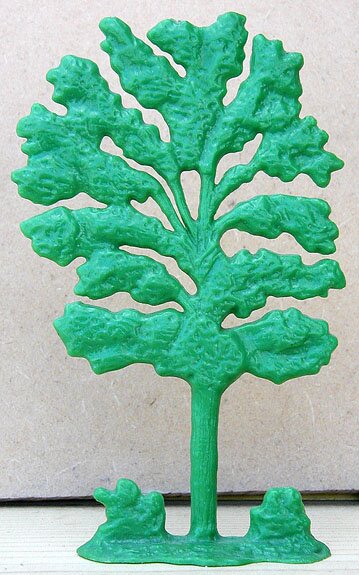 |
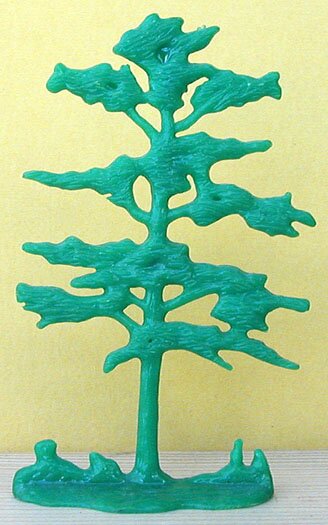 |
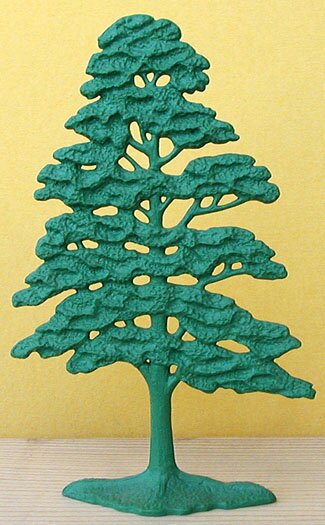 |
| Full tree or Oak tree (PL-131) |
Scraggly tree (PL-131) |
Delta tree or A tree (PL-524) |
The stand or row of trees was added to some playsets in the 1960s.
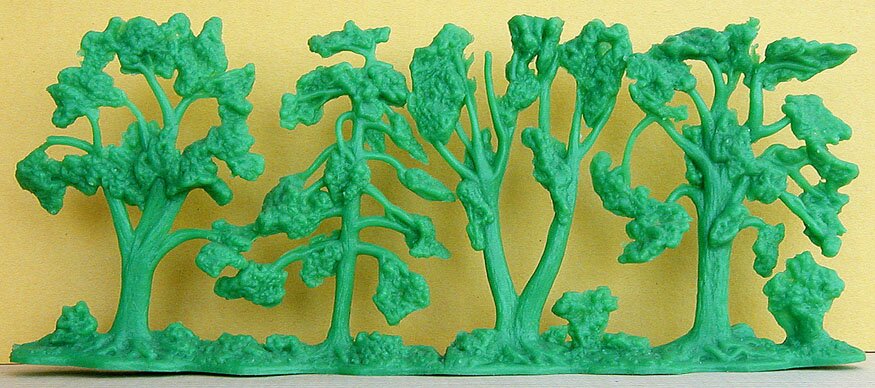 |
| Stand of trees (not separated) - Identified as unforked section on left, Forked section on right |
Marx produced three palm trees that appeared in sets involving Japanese troops. These trees were in two or three pieces with the top parts in a soft plastic green, and the bottom trunk part a hard plastic brown. Mold numbers for the plams and the ferns below are PL-760 for the tops and PL-761 for the bases. Rather nice re-issues exist in slightly lighter colors than the originals.
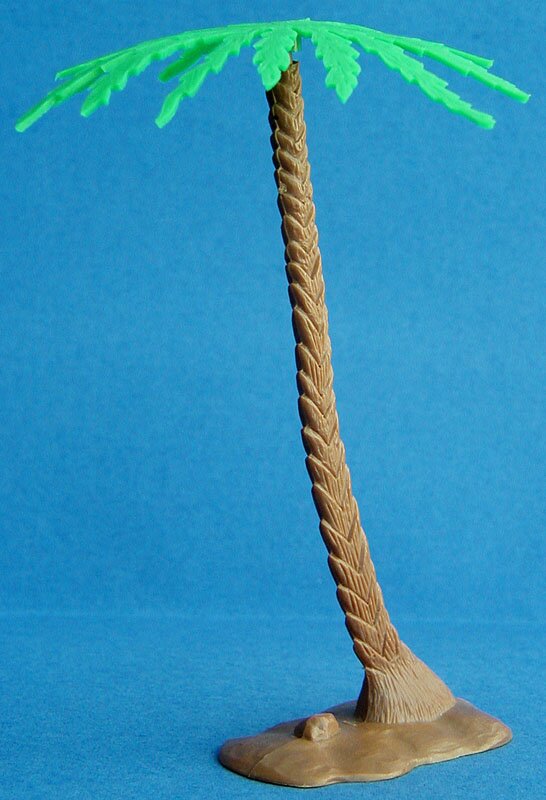 |
 |
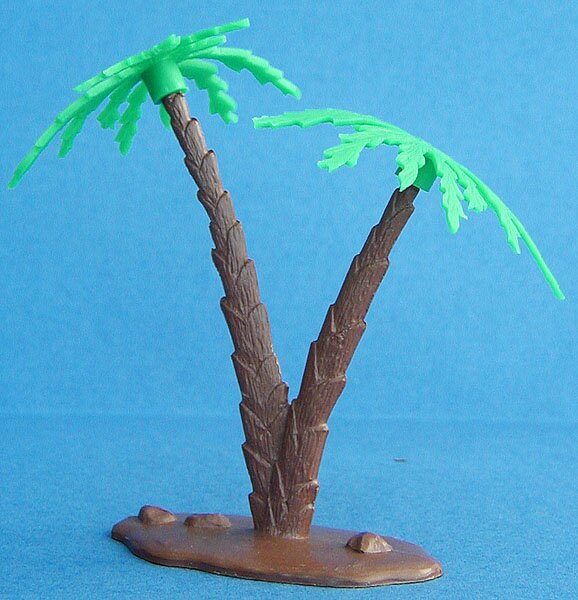 |
| Large single palm tree | Large double palm tree | Small double palm tree |
| Many thanks to the late Rob Colwell for providing original palm trees and ferns for photos. | ||
To go with the palm trees, Marx also produced two fern plants, also two-piece items with soft plastic tops and hard plastic bottoms. One has three leaves on it and the other four leaves; the bases are identical. As noted in the previous group of palm trees, mold numbers for the ferns are PL-760 and PL-761. As with the palm trees above, re-issues are slightly lighter in color than the originals.
 |
 |
| Fern with three leaves | Fern with four leaves |
The eighth and final tree included in some military sets was a "dead tree", 4-3/4 inches tall. Marx produced it in both hard and soft plastic gray, as well as two tree stumps. The large stump is 1-1/2 inches tall, and the small one 1-1/4 inches. With roots going every which way, breadth of the stumps varies, but the larger is about 3 inches in diameter at its widest point, and the smaller is about 2-1/2 inches. These three items are also seen in brown.
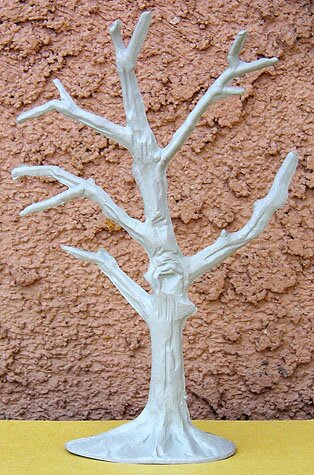 |
 |
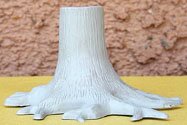 |
| Dead tree (PL-332 and PL-332A) |
Large stump (PL-332A) |
Small stump (PL-332A) |
Rocks
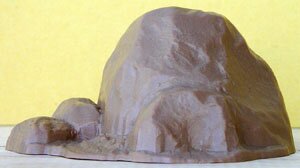 |
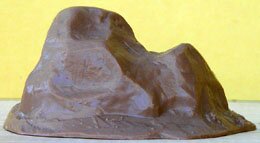 |
| large boulder (PL-332) |
small boulder (PL-332) |
 |
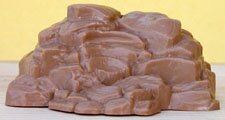 |
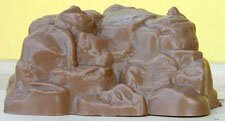 |
| pile of rocks - bulge left | pile of rocks - bulge center | pile of rocks - bulgeless |
Rock Formations and Pond
PL-1018 (all four pieces), PL-1018A (three pieces, no pond), PL-1018B (pond only)
Borrowed from Marx' Pre-Historic and Wild West playsets, the first of the four terrain pieces shown below were a part of the 1963 Army Combat set (designated as American Patrol in Sears advertising), according to PFPC. They were molded in a marbled brown hard plastic. Playset Magazine Issue 20 notes that they were also included in the largest version of the Iwo Jima playsets.
 |
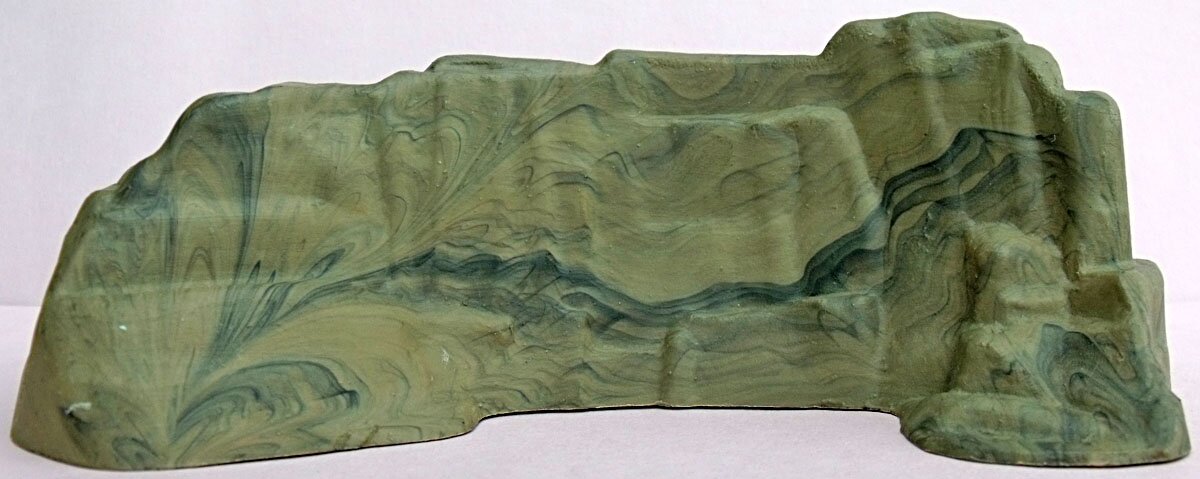 |
| Small mesa rock | Small cliff rock Notice the nice marbling in the plastic. |
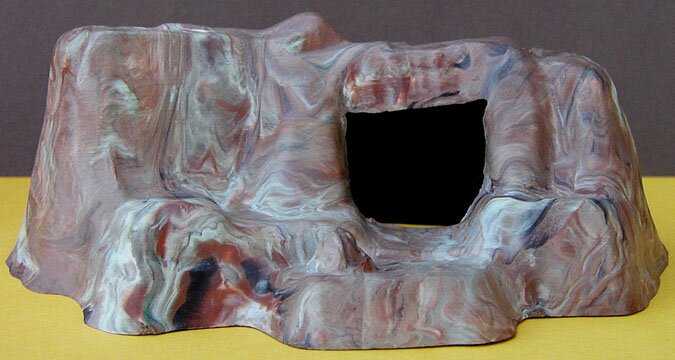 |
 |
| Rock formation with cave Again, notice the nice marbling in the plastic. |
Hill with pond No longer in the best shape, but it is original and also nicely marbled! |
A Marine Beach Head Play Set, issued in 1960, included a unique vacuform island that measures 10 inches by 23 inches. PFPC reports that it was molded in tan with green and brown airbrushing. Due to the limited production of the island and the fragility of vacuform, I doubt that many still exist, and I have never seen one. The PFPC Special Collector Edition of 1994 includes a photo.
| Vacuform Island |

Playmats and Bases
Many Marx playsets included plastic playmats with terrain features painted onto them. The mats were made of a very thin plastic material and were very fragile and easily torn.
I have only the one shown below for the Navarone Play Set below and am not familiar with how many playmats were produced. I believe that some mats were sold separately to be added to sets. I welcome information and/or photos on playmats.
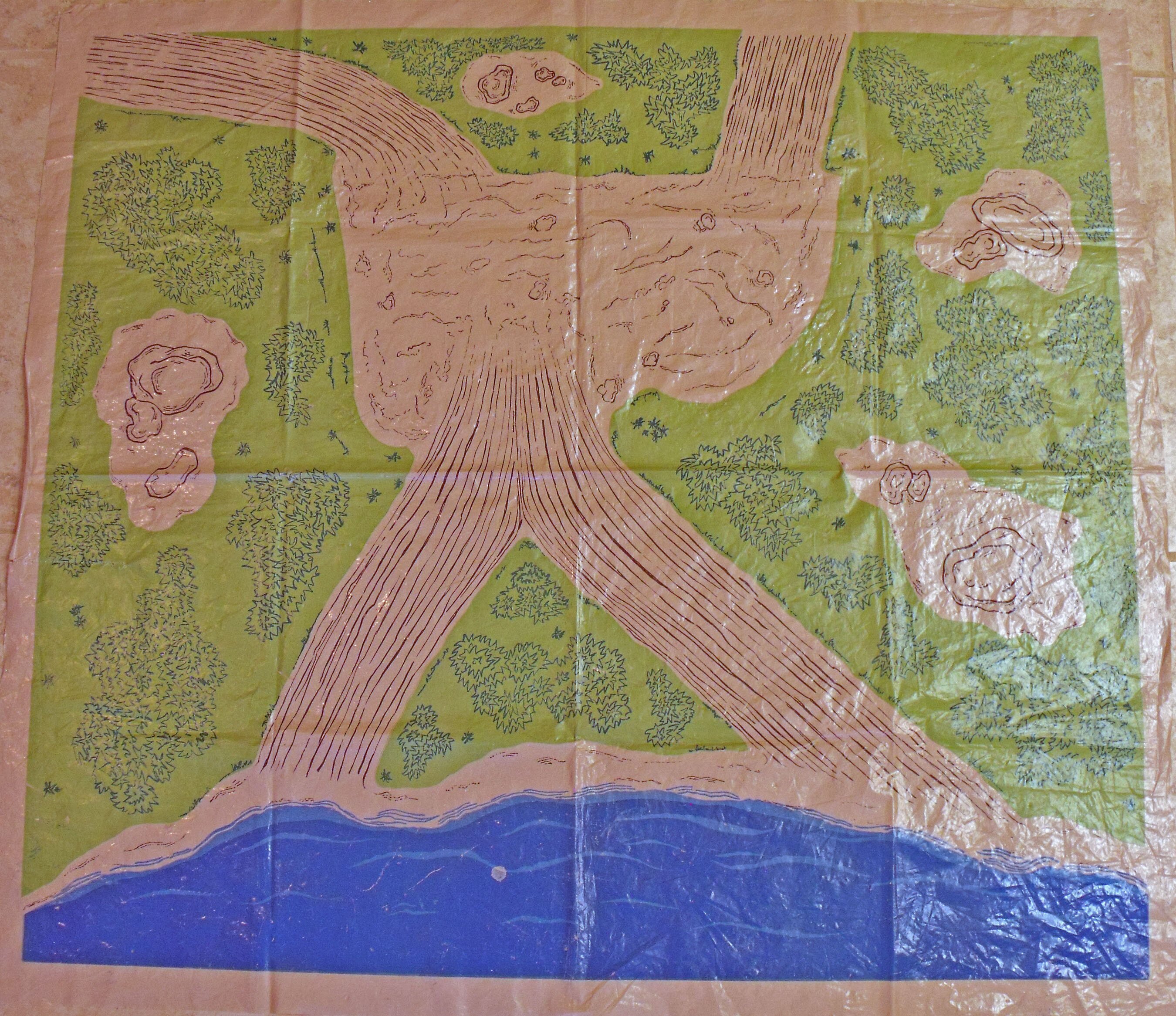 |
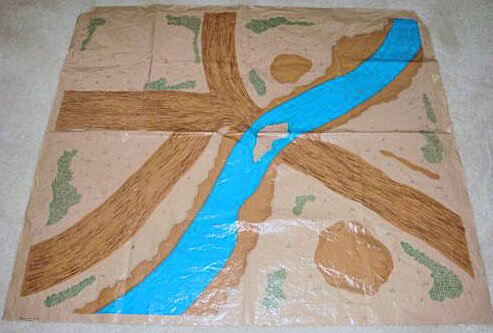 |
| Playmat for Navarone Playset The mat is about 32 inches square. |
Playmat for Desert Fox Playset Photo courtesy of veteran collector/seller Allan Ford, Ebay 610allanf |
Rather than a playmat, a very attractive and unique terrain base was included in the 1966 Battleground Terrain Set. The base is made up of six interlocking hard plastic terrain pieces. Each piece is 12-inches square in a tan hard plastic with airbrushing of green and blue; when attached, they make up a play base two feet by three feet. This is the only known playset in which Marx used such terrain pieces, most likely due to the costs. The set, of course, included the normal Battleground assortment of military figures and other accessory pieces.
Thanks to collector Darrel Lang, you can see exceptional photos of the terrain base below. He provided all of the photos from a Battleground Terrain Set that his brothers bought for him one Christmas. He has obviously kept it in good shape! The box has the original price tag on it of $6.97. (Today you can buy a couple of figures from the set for the same price!)
I have seen re-issues of these pieces in off white, green, and painted at the annual OTSN toy show near Chicago.
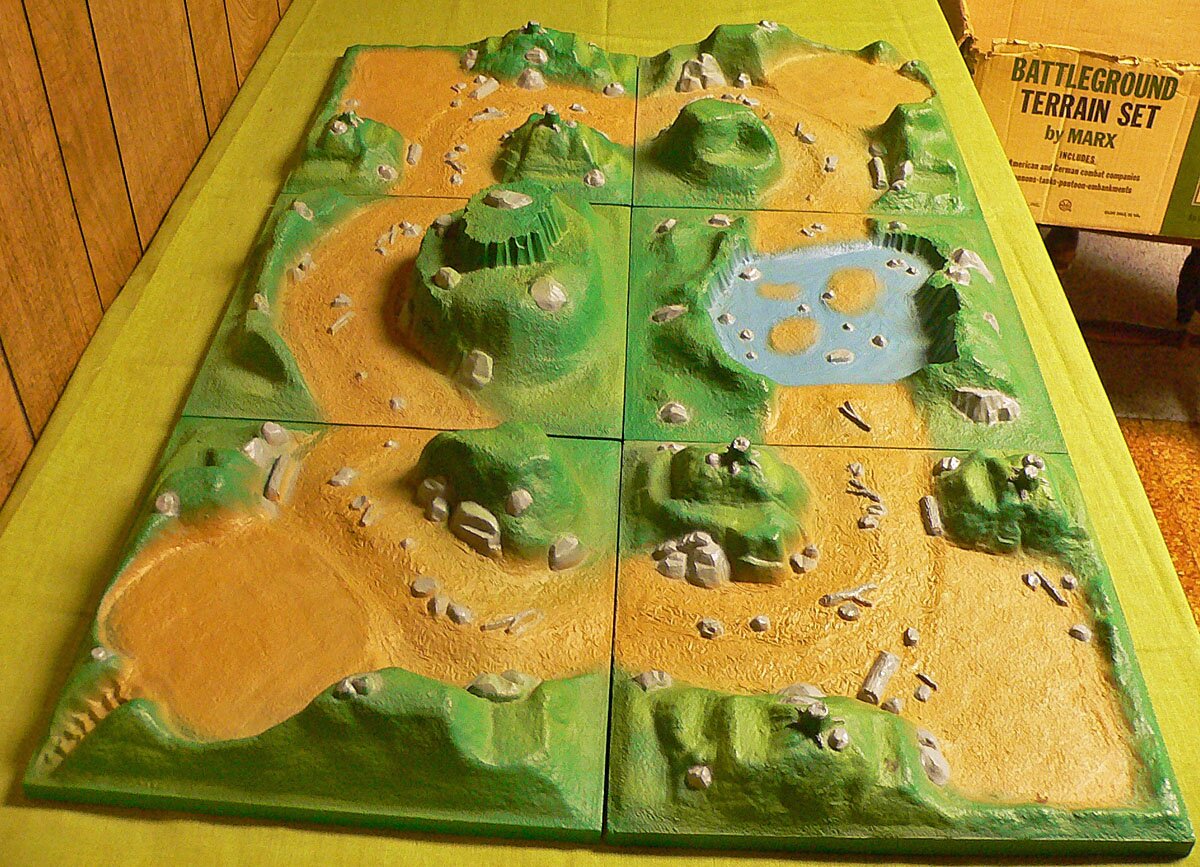 |
| Six-piece Battle Terrain Photos of original terrain courtesy of collector Darrel Lang |
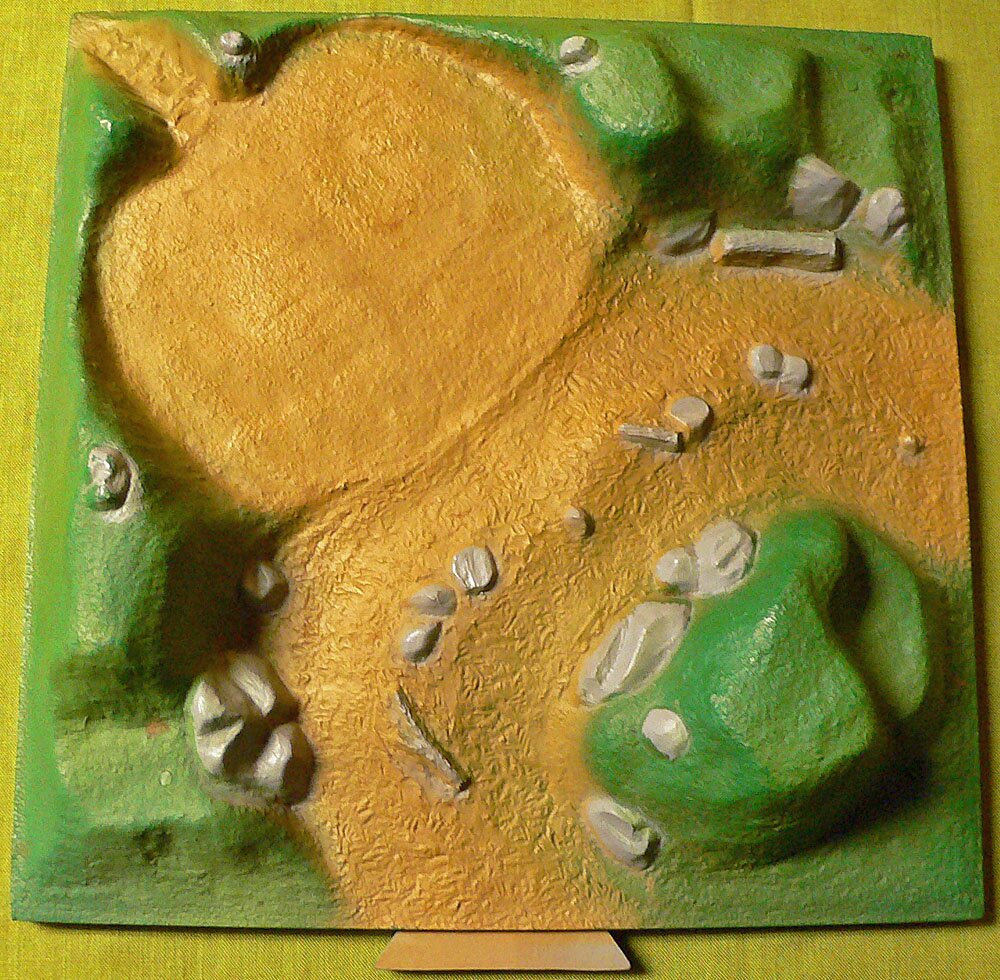 |
 |
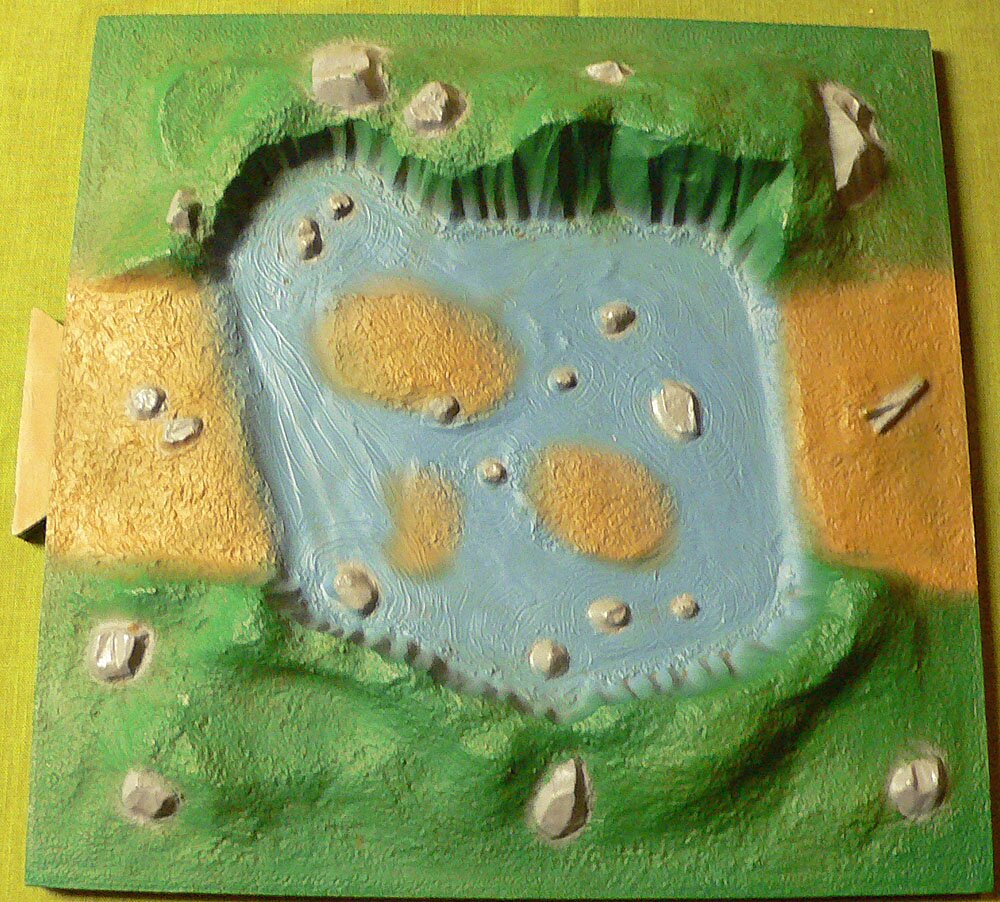 |
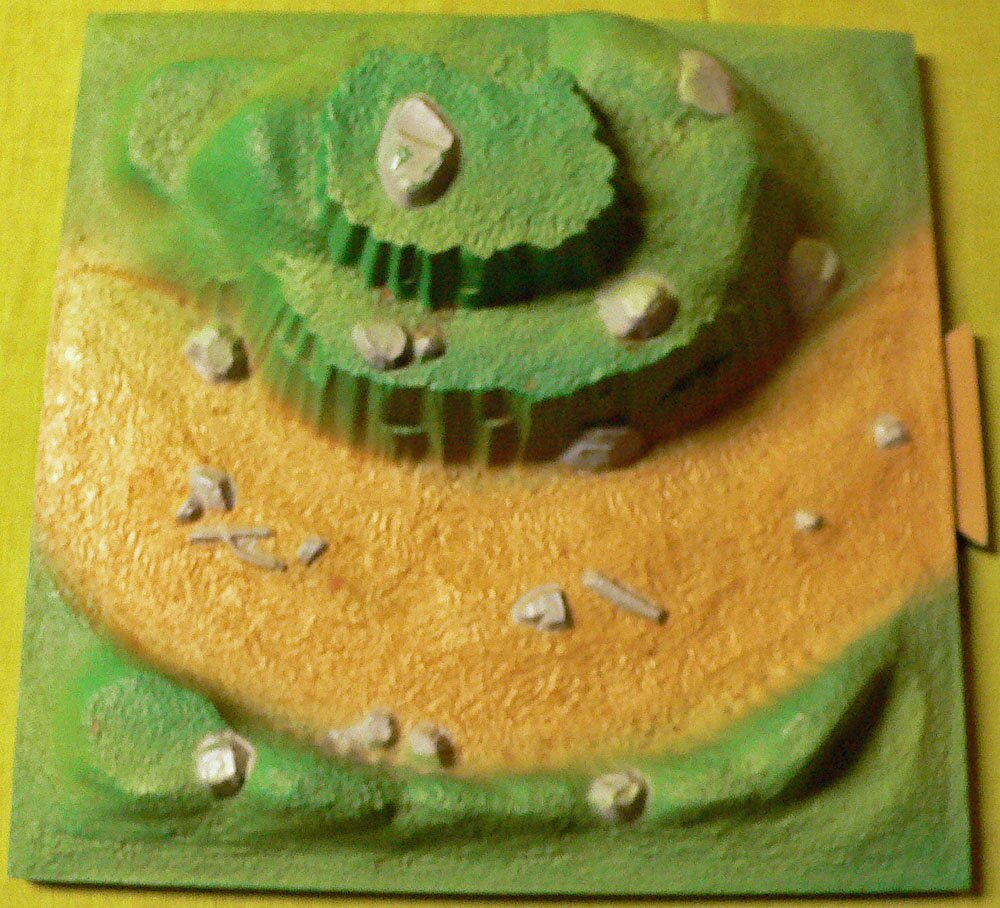 |
| Four of the six terrain base pieces Three of the four corner pieces are almost identical to the photo in the upper right. |
|
 |
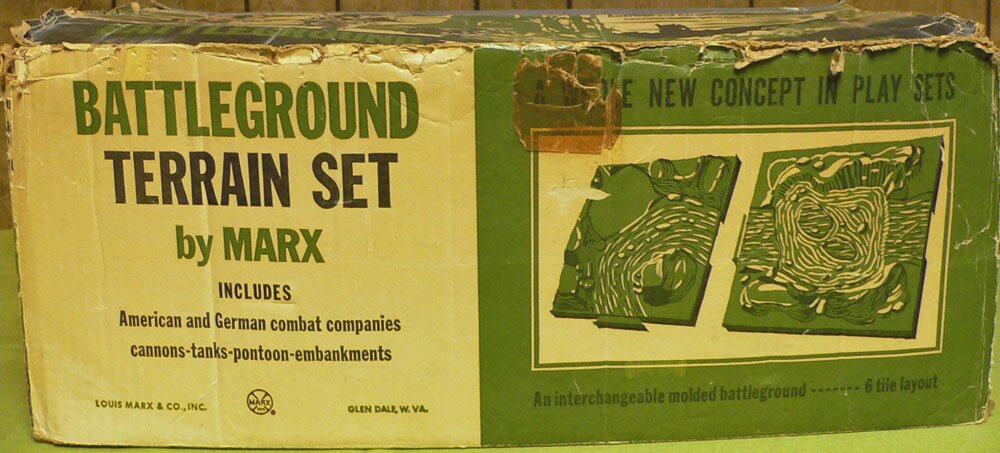 |
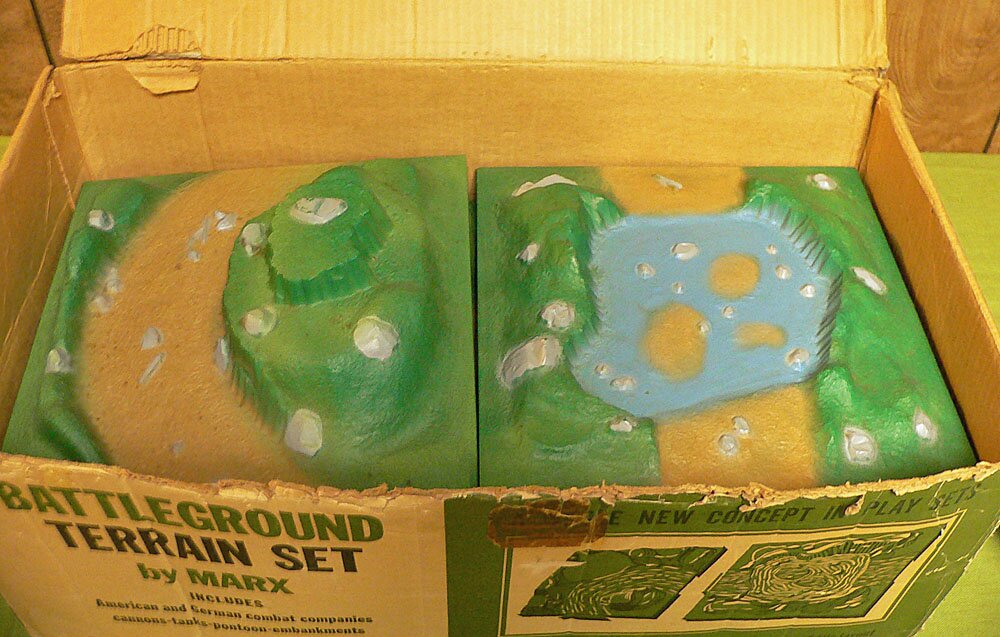 |
| Terrain Set box | Side of box | Terrain pieces packed in box |
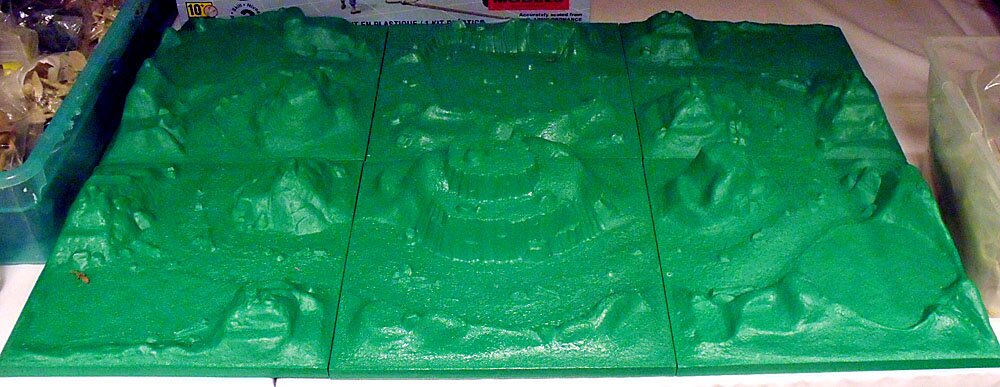 |
| Re-Issue Battlefield Terrain Photo courtesy of John Stengel, aka The Marx Man |

Comments on a Few Specific Playsets
A few Marx military playsets deserve specific mention, either for their unusual theme or unique accessories. I would deem them to be those that follow.
D.E.W. Defence Line Arctic Satellite Base
The Distant Early Warning Line -- often referred to as Defense rather than Distant -- was a system of radar stations in the far northern Arctic region of Canada with additional stations along the North Coast and Aleutian islands of Alaska, in additional to the Faroe Islands, Greenland, and Iceland. It was set up in the 1950s to detect incoming Soviet bombers during the cold war and to provide early warning of any sea-and-land invasion. The shortest route for a Russian air attack on North American is through the Arctic, so line stations were constructed to give warning of a Soviet strike and allow time for U.S. bombers to get off the ground and ICBMs to be launched. As construction began in 1954, many thousands of skilled workers were transported to polar regions, housed, fed, and supplied with tools, machines, and materials to construct the needed buildings, roads, tanks, towers, antennas, airfields, and hangers.
The 1959 Marx playset -- #4802 -- depicts a completed station in the Arctic with similar contents to the IGY set, which is shown on the Space Exploration Accessories page of this web site. Of course, the name on the gate in changed, and there is a large radar atop the quonset hut in the DEW set. The radar is unique to this set. There are also differences in figure and accessory colors. As with the IGY set, an article in Playset Magainze Issue 32 provides detailed information on the DEW set, including contents of the set.
Marx produced four playsets related to the Arctic regions in 1958 and 1959, perhaps partially to honor Alaska, which became a U.S. state in 1959. Besides the DEW set here and the IGY set on the Space Exploration Accessories page, an Arctic Explorer playset is on the Scientists and Explorers page and the Alaska Playset is in the Wild West section.
As an added note -- and oddity -- the name of the DEW playset shown above is accurate. I have no idea why the box uses the British spelling of defence (with the "c") rather than the good old American spelling of defense (with an "s")!
Strategic Air Command Accessories
The 1963 Strategic Air Command playsets -- sold by both Sears and Montgomery Wards -- included several small accessories that are not included in any other military playsets. I have none, so do not include any here. Hopefully, I will obtain some soon so that I can show them, or perhaps one of you out there can send me some good photos. Meanwhile, an article in Playset Magazine Issue 54 provides information on and photos of the set.
Navarone and Iwo Jima Mountain and Small Accessories
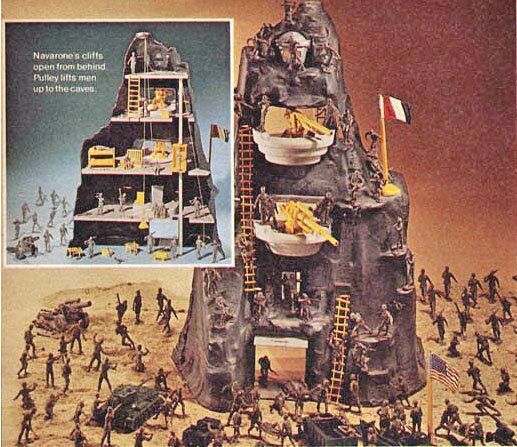 Following the company's sale to Quaker Oats in 1972, the company issued two military playsets that included a large plastic mountain about two feet tall: Navarone and Iwo Jima playsets. The Navarone set is based on the book Guns of Navarone (1957) and its film version (1961). While they are based on a World War II campaign to capture German-held islands in Aegean Sea, the story is fictitious. The Iwo Jima set, of course, is based on the bloody and controversial World War II battle for Iwo Jima Island in the Pacific Ocean. The famous photo of U. S. Marines raising the American flag was taken on top of an Iwo Jima mountain.
Following the company's sale to Quaker Oats in 1972, the company issued two military playsets that included a large plastic mountain about two feet tall: Navarone and Iwo Jima playsets. The Navarone set is based on the book Guns of Navarone (1957) and its film version (1961). While they are based on a World War II campaign to capture German-held islands in Aegean Sea, the story is fictitious. The Iwo Jima set, of course, is based on the bloody and controversial World War II battle for Iwo Jima Island in the Pacific Ocean. The famous photo of U. S. Marines raising the American flag was taken on top of an Iwo Jima mountain.My collecting experience suggests that these sets are very popular among many collectors today, probably because the mountain provides a focal point for collectors to display (or play with) their Marx troops. I've also noticed that, for whatever reason, the Navarone set seems to come up for sale much more often than the Iwo Jima set. An extensive article on Marx military playsets in PFPC's Special Collector Edition of 1994 provides some information on these sets.
As you can see from the advertising photo at right (courtesy of Kent Sprecher) and of my playset box on the left, the front of the mountain has
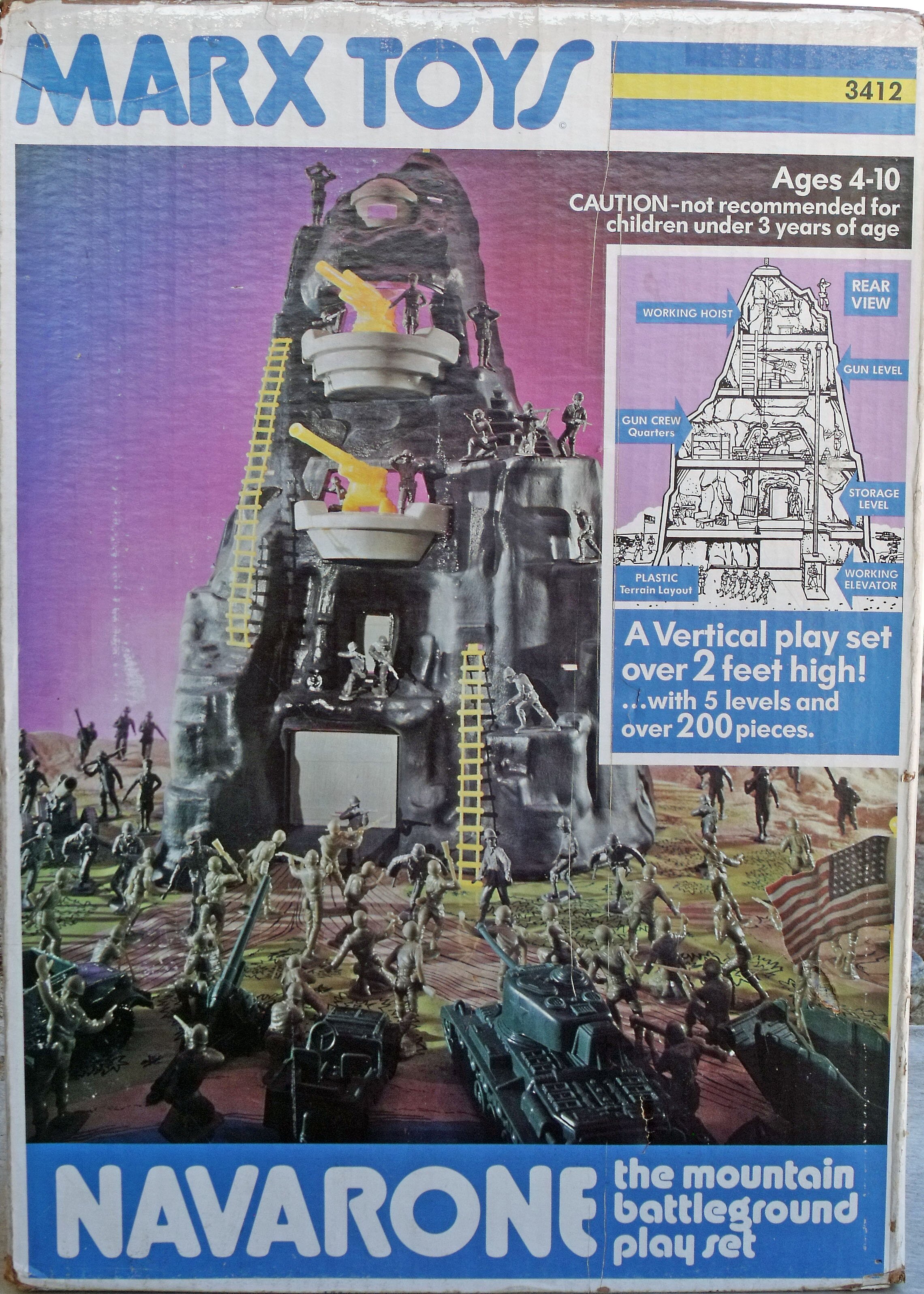 numerous positions to place troops, two operating doors, and pillbox openings that hold a pair of cannons. The back of the mountain is open with five (yes, 5!) floors for troop activity. It also has an elevator that can be pulled up and down by a string, and a hook attached to a similar string that can be used to haul supplies up to the top floors.
numerous positions to place troops, two operating doors, and pillbox openings that hold a pair of cannons. The back of the mountain is open with five (yes, 5!) floors for troop activity. It also has an elevator that can be pulled up and down by a string, and a hook attached to a similar string that can be used to haul supplies up to the top floors. Although I do not show the Giant Iwo Jima set here as yet, it was basically the same, except that Navarone included German soldiers and Iwo Jima had Japanese. Two down-sized airplanes were also added to the Iwo Jima set. The mountain in the Navarone set was dark gray hard plastic, and a new group of small accessories were an ugly waxy yellow hard plastic. In the Iwo Jima set, these colors were reversed to a mustard yellow mountain and waxy light gray accessories. PFPC states that the mountain measures about 25 inches high, 17 inches wide, and 10-1/2 inches deep. I measure it a little less wide, but either way, it is one humdinger of an accessory!
In addition to the mountain and new accessories, the sets included the standard 6-piece vehicles group and 54mm American and German or Japanese troops in their usual colors. I have found no listing of specific items included in the sets, but based on the nearly complete set that I own, I believe all parts -- at least for the Navarone set -- are shown below.
The new small accessory group, by the way, was used only in these two playsets. My personal favorite piece in these new accessories has to be the tiny radio! On the other hand, if you want to talk about all the new accessories, the mountain has to be right up there at the top!
Due to the large size of the mountain and numerous photos, items below are not all shown in the correct proportion to one another.
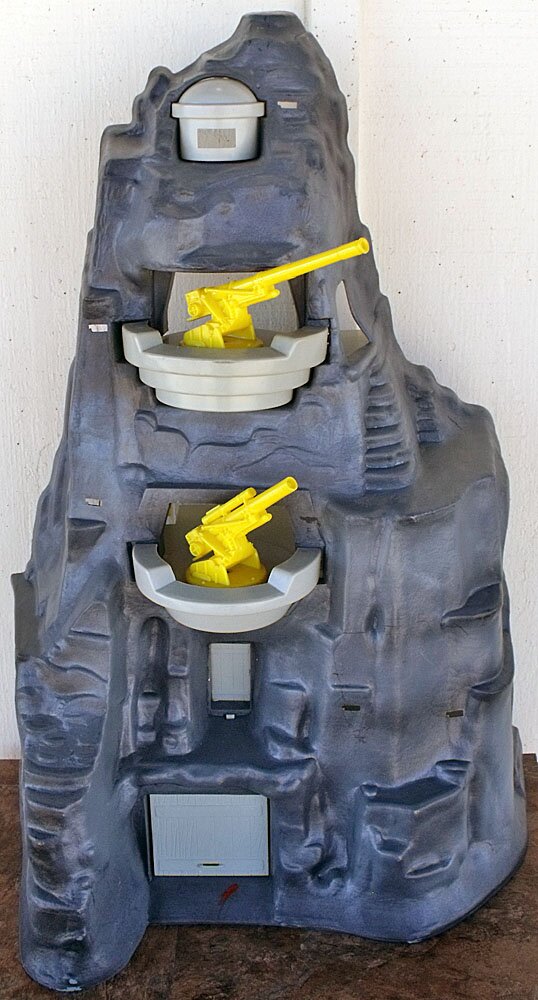 |
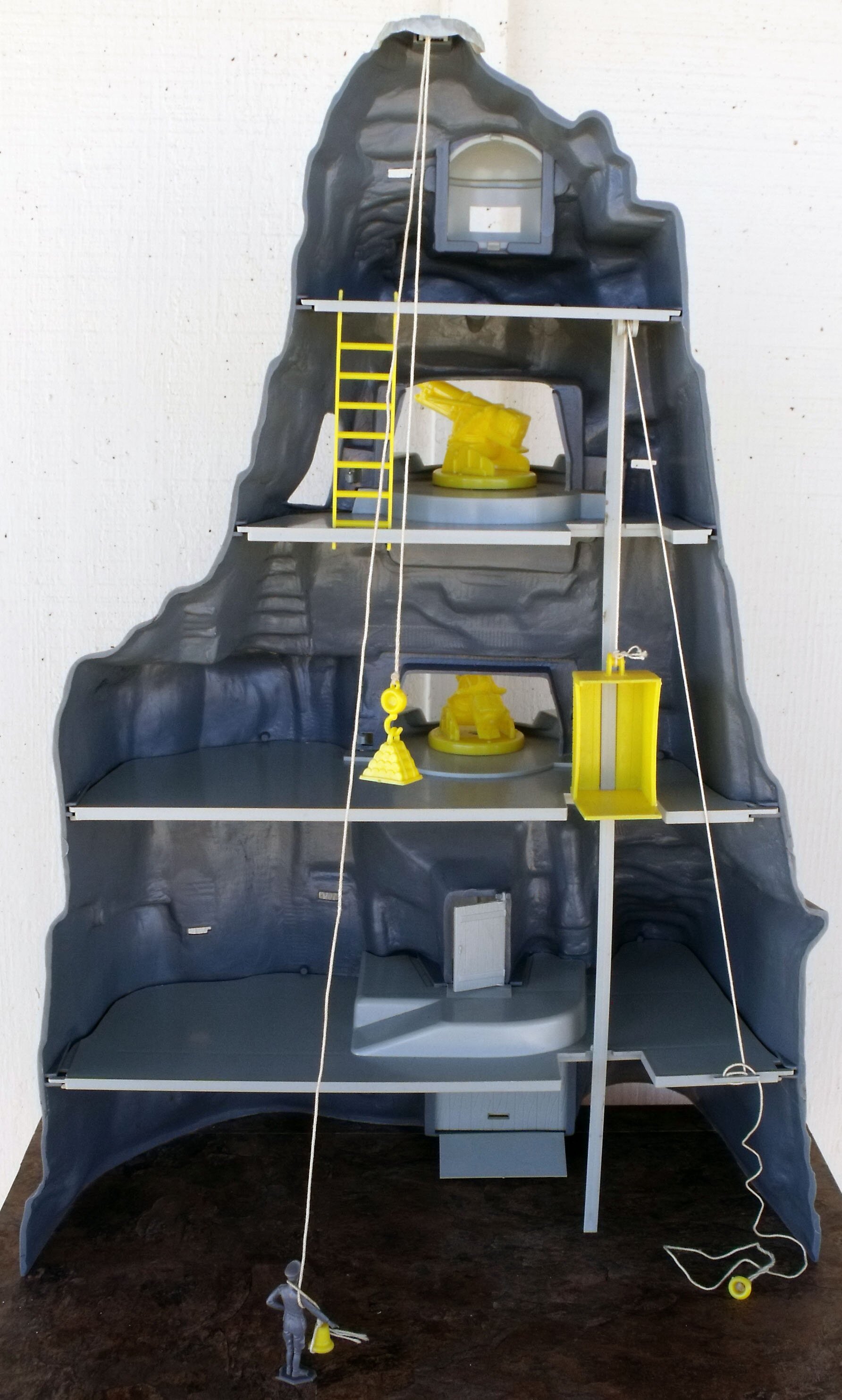 |
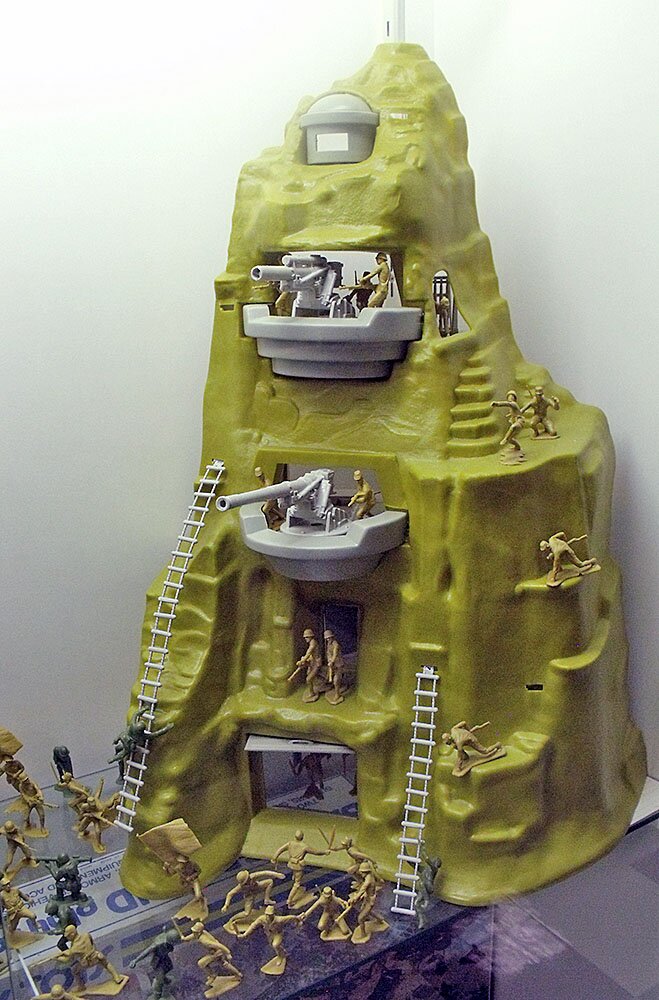 |
| Front and back views of Navarone mountain Back view includes cap piece that has hole for flag pole and pulley for string "cable" that is used to haul up supplies. Elevator on right is also moved with this "cable" and tied off at bracket on second floor. |
Iwo Jima mountain Photo courtesy of Marx Museum in Moundsville, West Virginia |
|
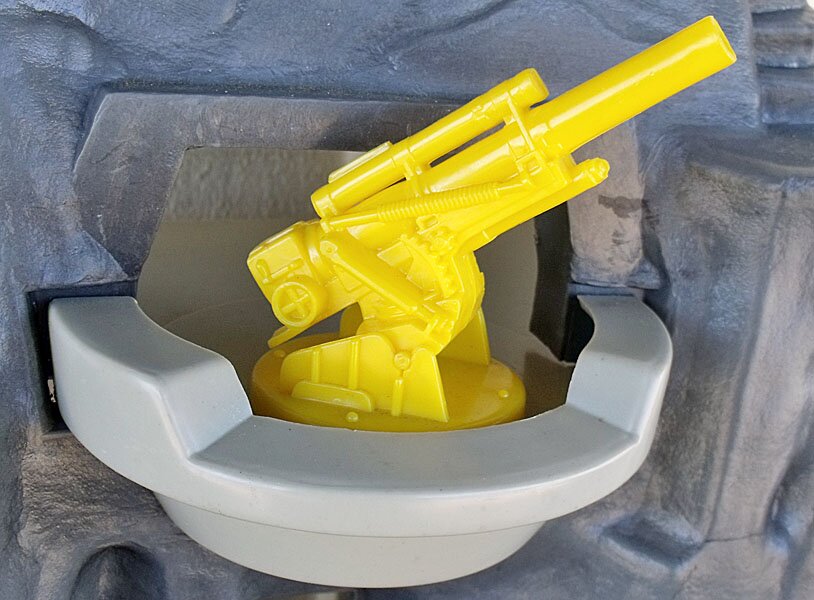 |
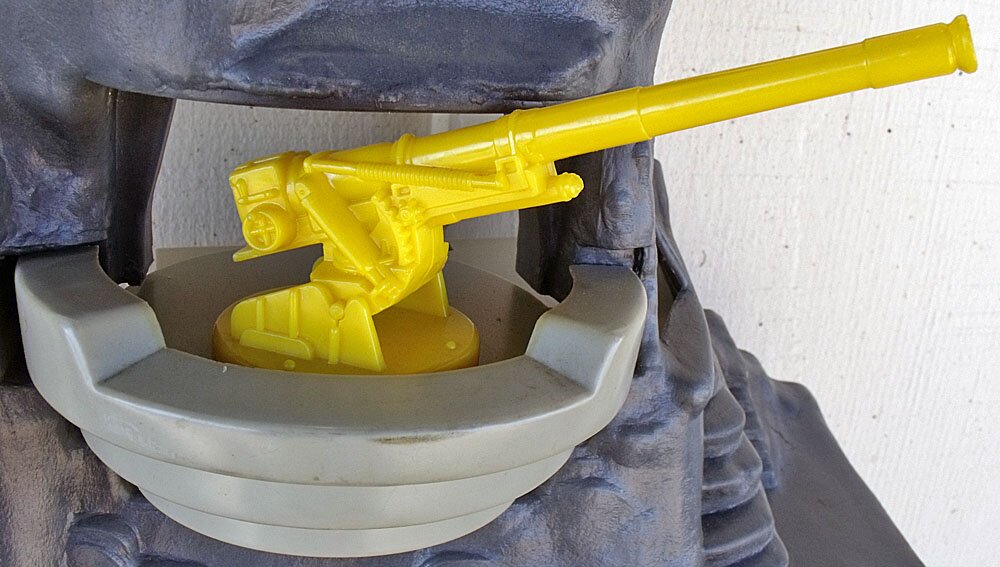 |
| Close-up of small cannon | Close-up of larger cannon |
| Cannons are in three pieces -- light gray base that fits into mountain, base of cannon, and cannon itself. Both cannons can be rotated upward and side-to-side; neither actually fires. Small cannon is 4 inches long; large cannon 5-1/2. | |
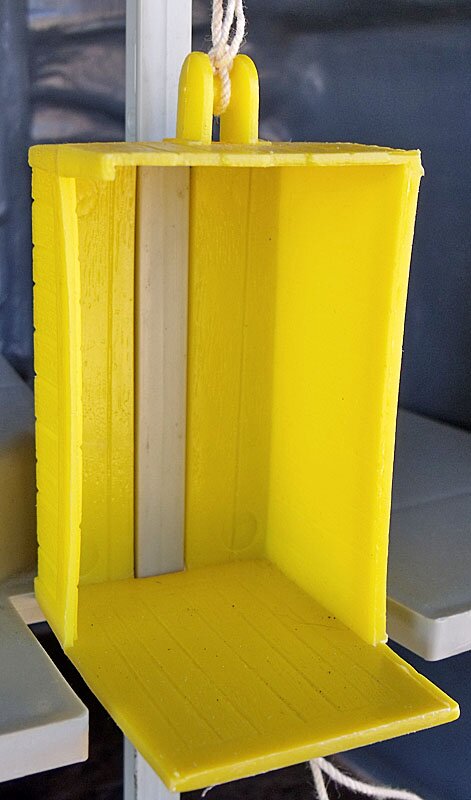  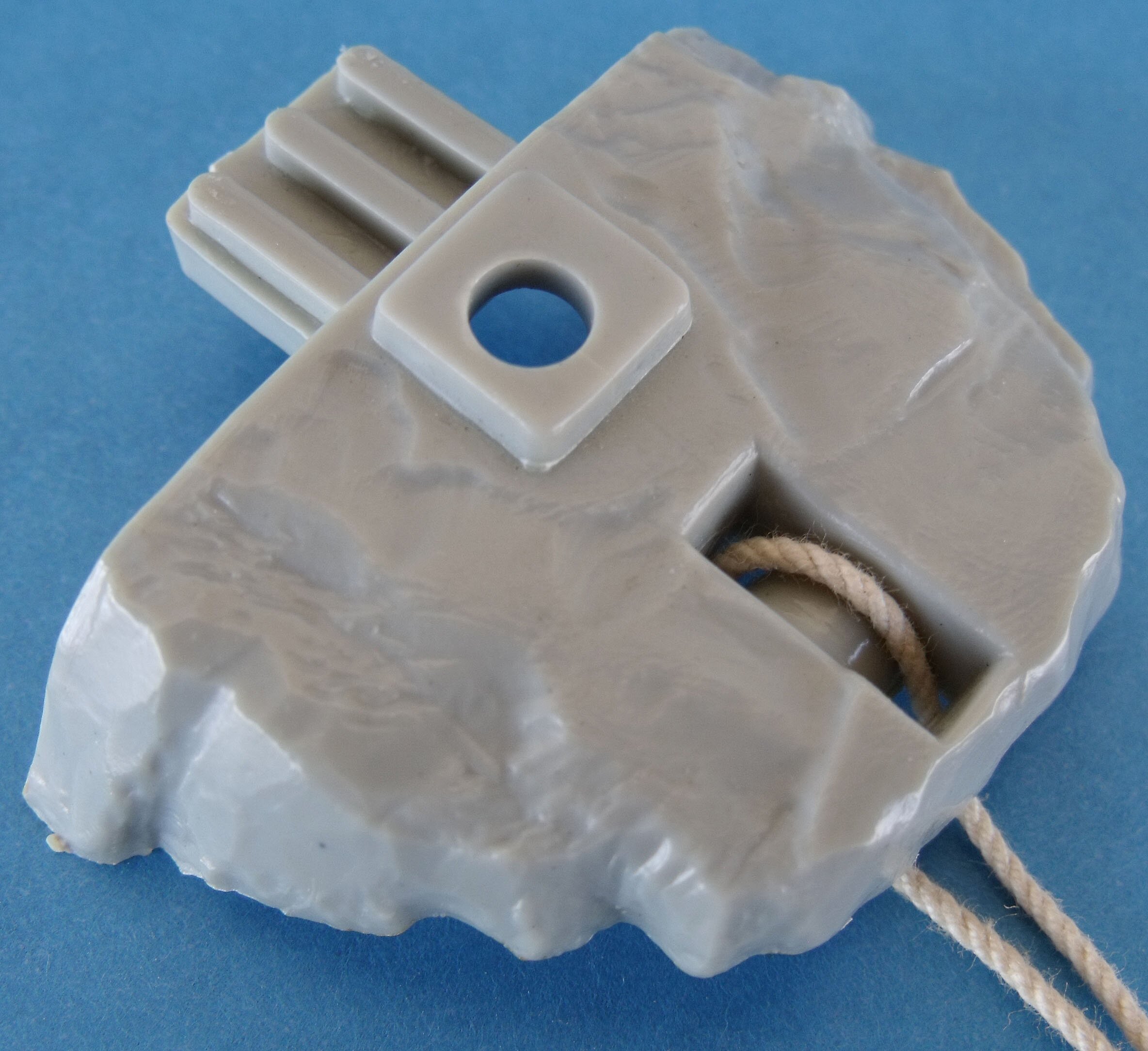 |
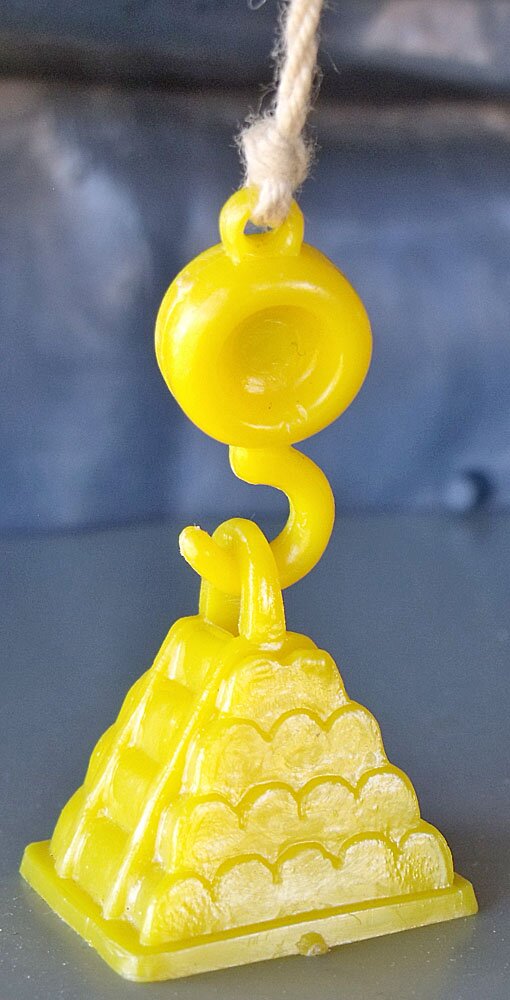 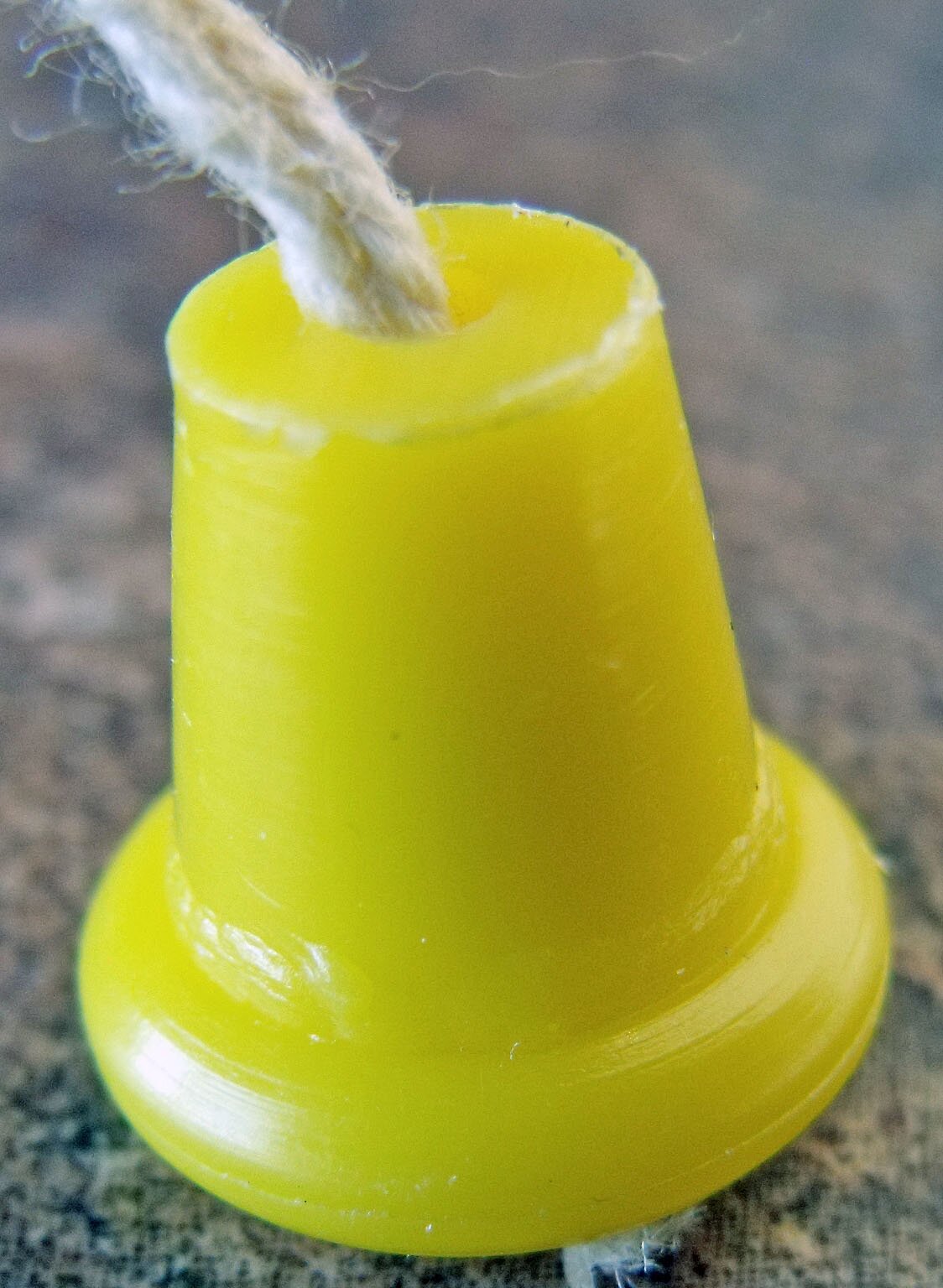 |
| Close-ups of elevator, interior ladder from 4th floor to top floor, and cap piece that fits into back of mountain top with hole for flag pole and pulley for supply cable. | Close-up of 1) hook for supply cable (string) with ammo pile attached and 2) handle for other end of cable. |
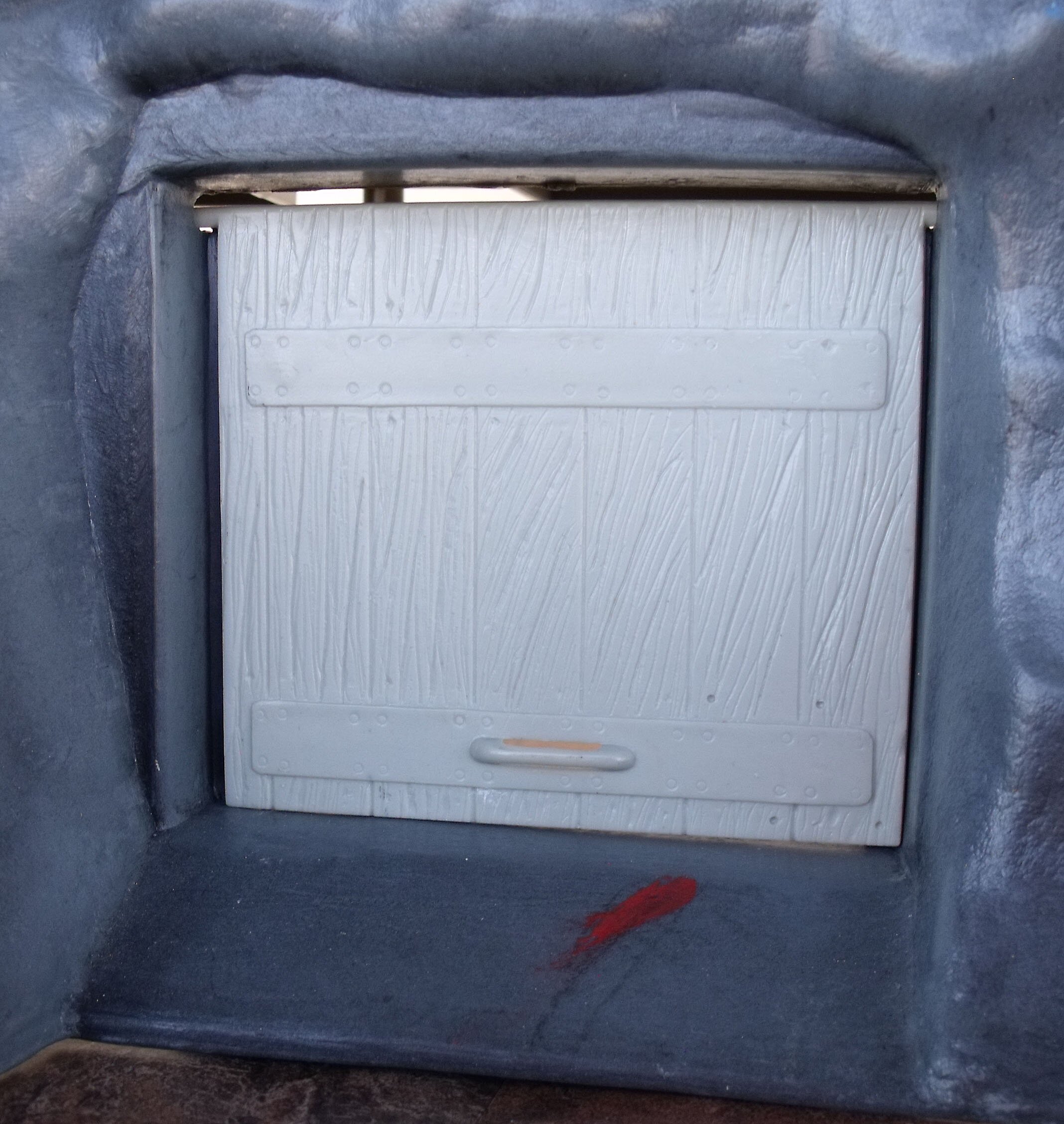 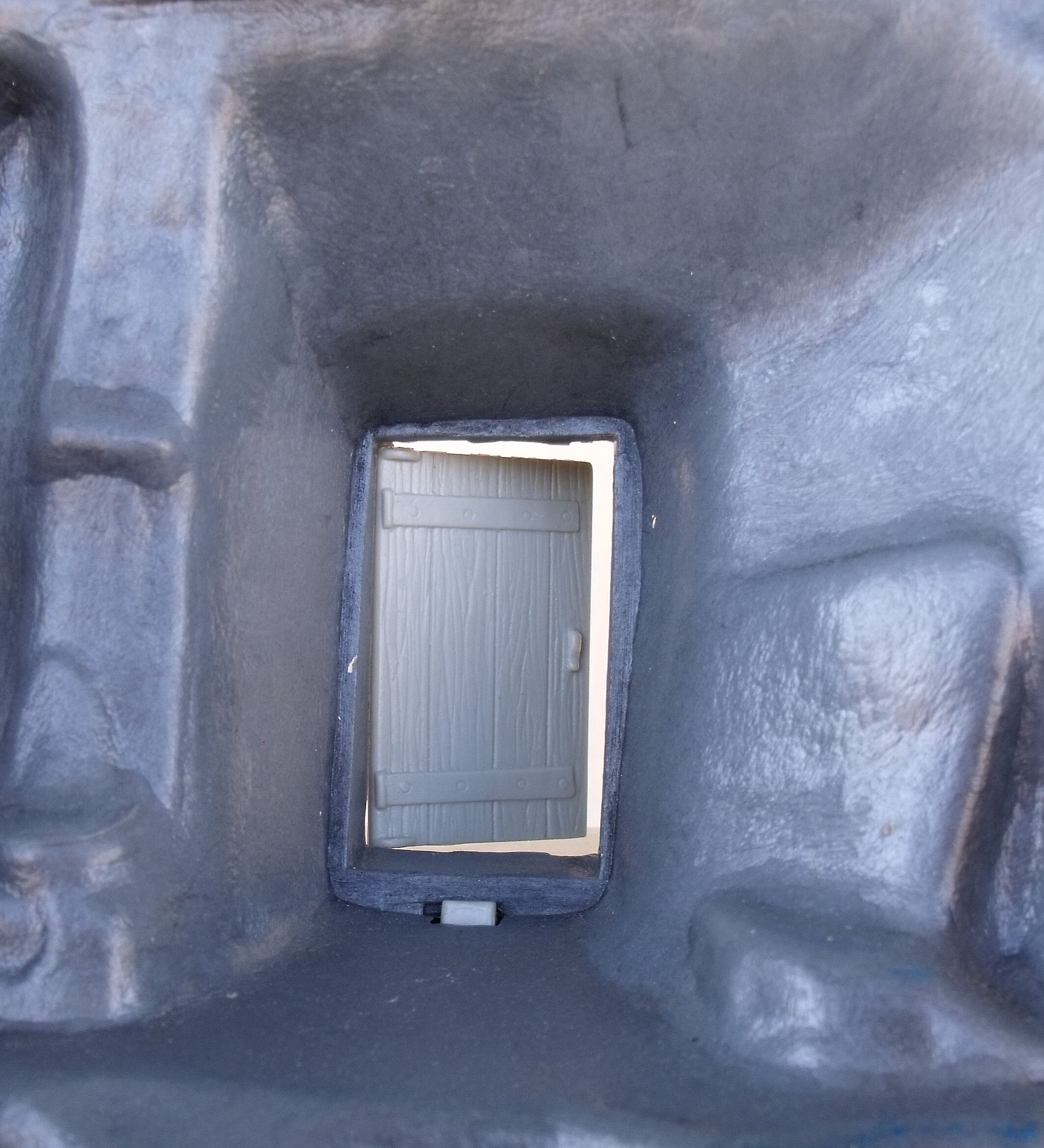 |
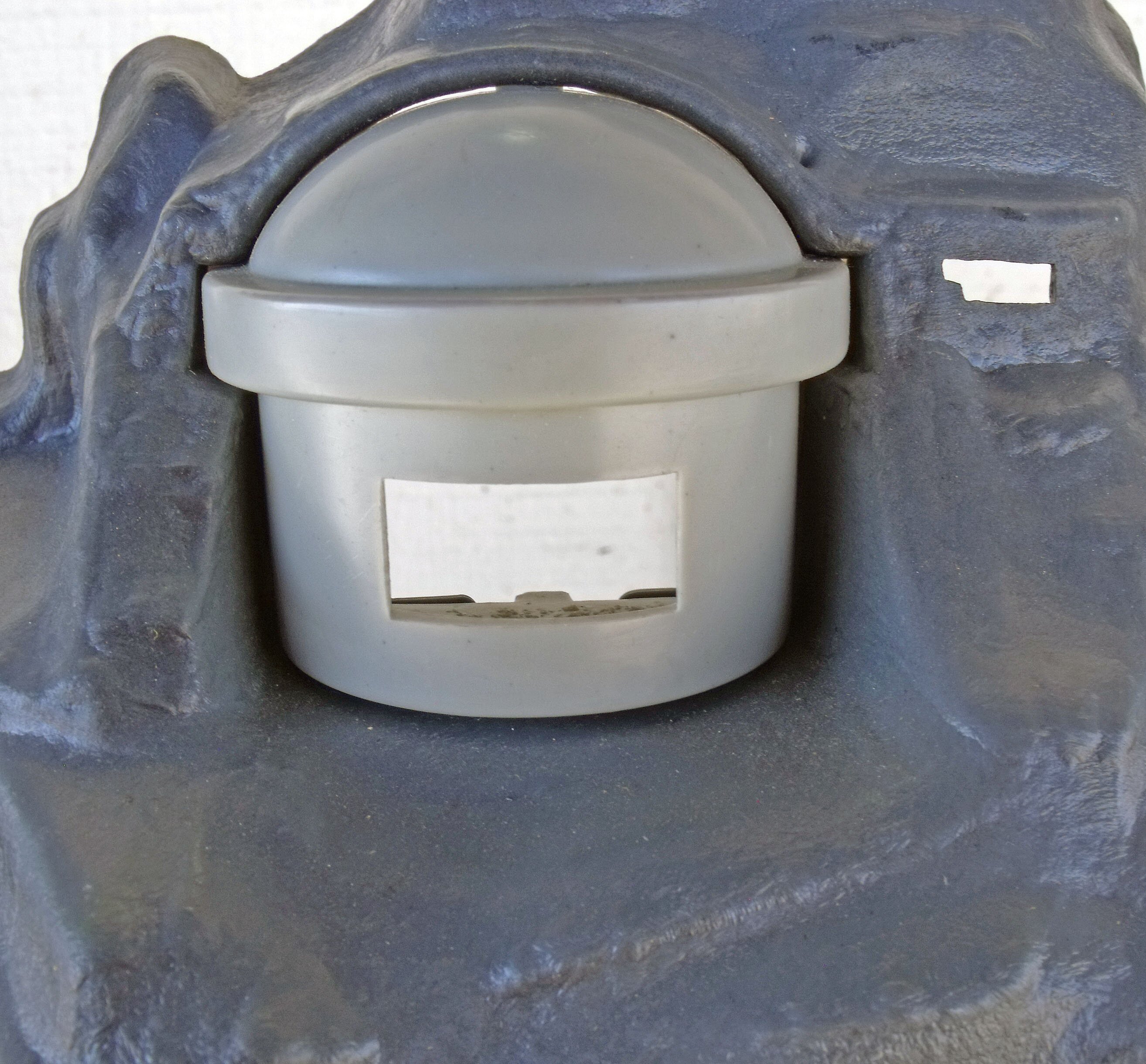 |
| Exterior doors on front of mountain Both doors open and shut. The bottom door opens like an overhead garage door. |
Pill box at top of mountain Note the hole for one of the exterior ladders at the right. |
As shown in the advertising and playset box photos above, the set includes ladders that attach to the front of the mountain. I remain uncertain as to just what these are intended to be. Certainly the troops holding the mountain would not put them up, and it would appear that attacking troops trying to scale the mountain on these ladders would be quickly picked off by German riflemen. But then, perhaps we need to suspend reality just a bit. In any case, although my set includes four of these ladders (as shown below), the tabs that should hold them into slots on the mountain are broken off. I have been told that these are commonly missing, as they are difficult to insert and frequently break off when the ladders are removed.
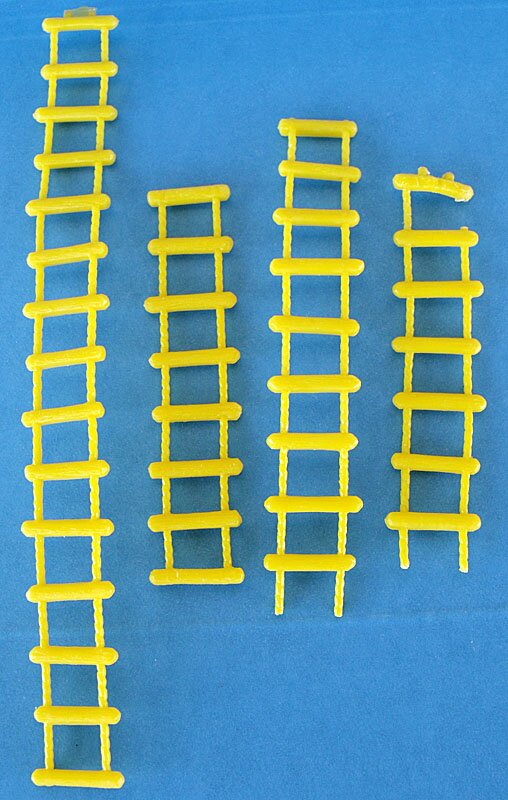 |
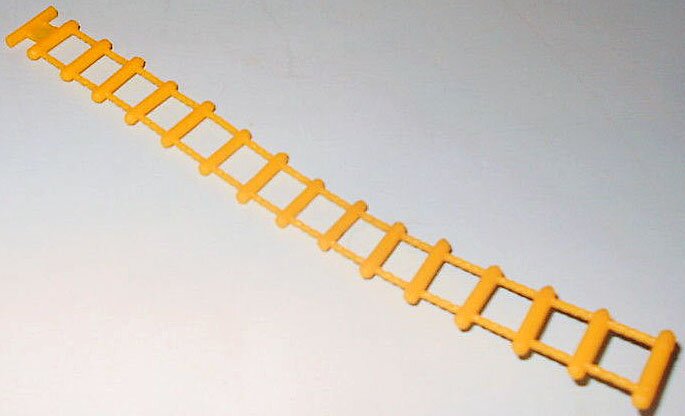 |
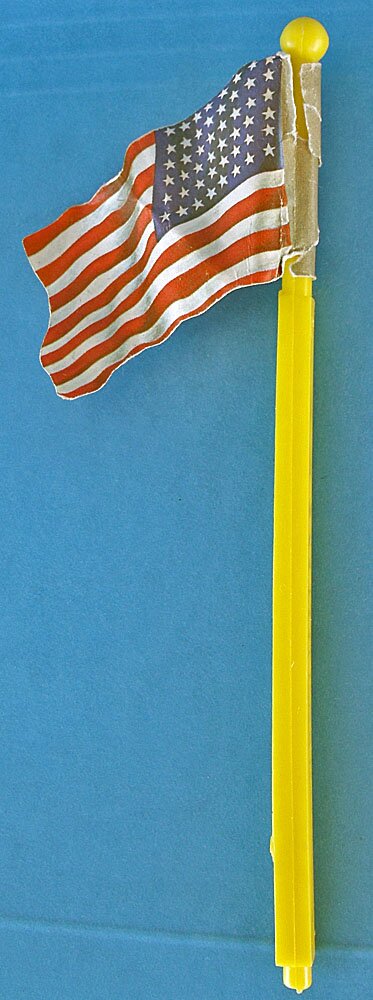 |
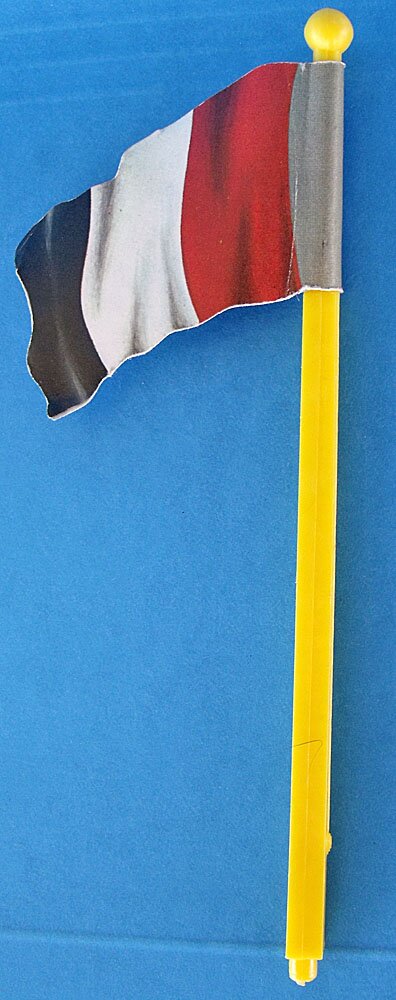 |
| Outside scaling ladders | Navarone ladder - complete with connecting tab at top | U.S. flag | German flag |
| These are the ones included in my set. The long one with a tiny part of the original tab that held it in place at the top is almost seven inches tall. | Photo courtesy of veteran collector and seller Rick Koch. | Flag poles are six inches tall. The flags are paper stickers with both flag sides that fold around the pole. | |
Navarone/Iwo Jima Small Accessory Group
I am not sure, but I would imagine that the yellow pieces shown above (cannons, evelator, flag poles, etc.) were made in the same mold as the accessories shown below.
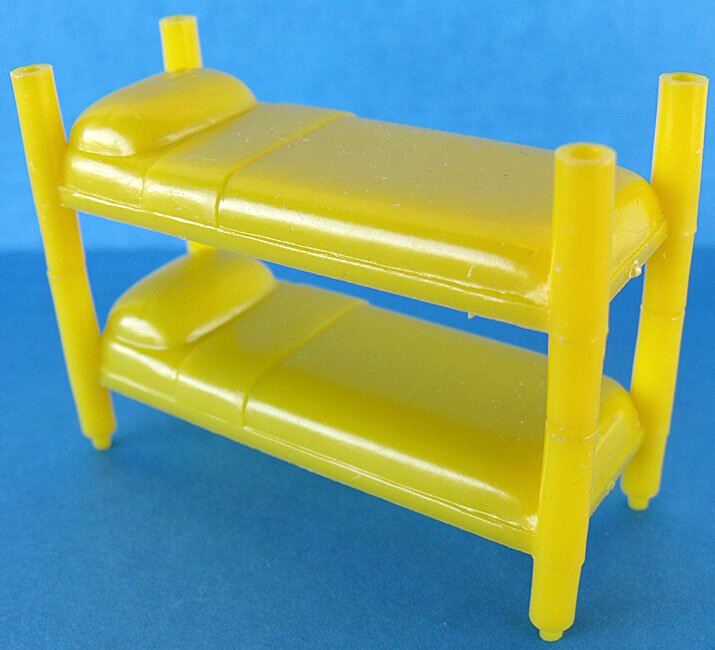 |
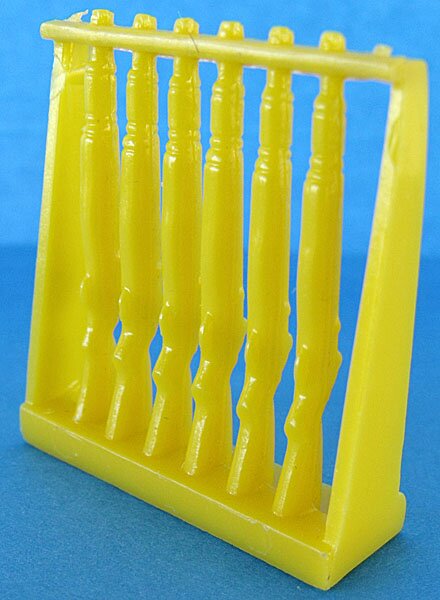 |
| 1. Beds Beds can be stacked by pegs on bottom and holes on top of bed posts. All beds are the same; more than two can be stacked if desired. Beds are 2-3/4 inches long. |
2. Rifle rack Rack is about 1-1/2 inches tall and wide. |
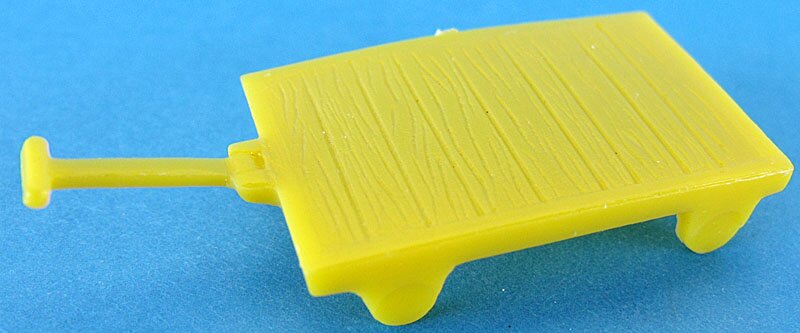 |
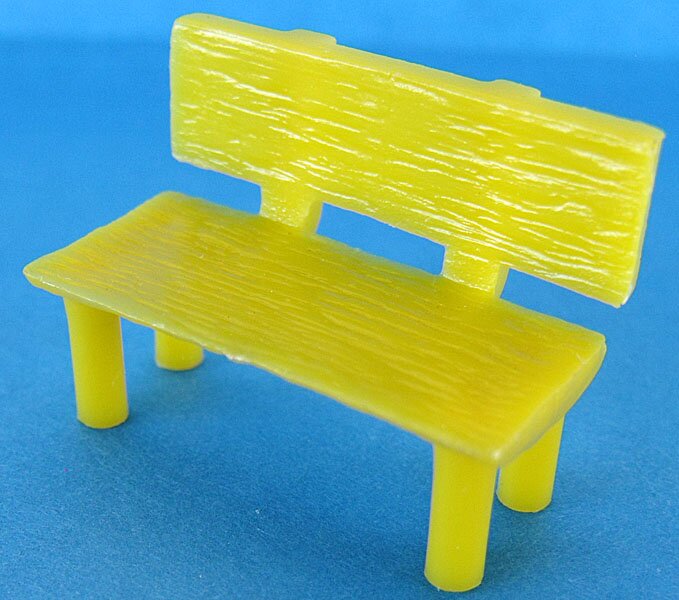 |
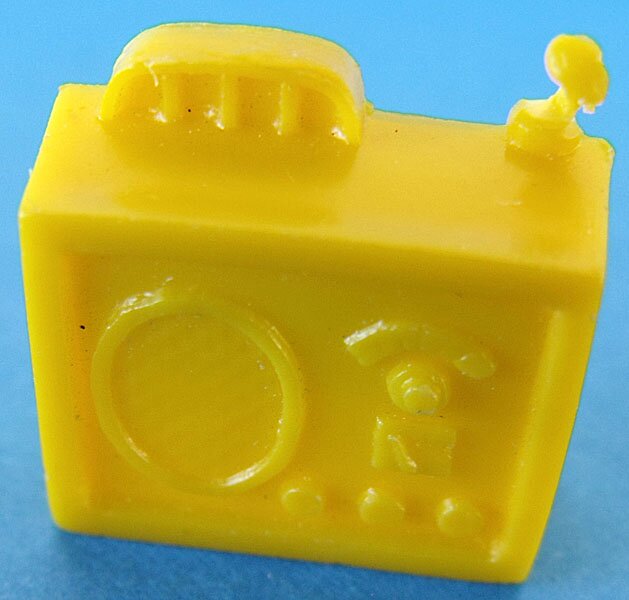 |
| 3. Cart Cart is two inches long. |
4. Bench Bench is small, just 1-1/4 inches wide. |
5. Radio This small accessory is 3/4 inches square. |
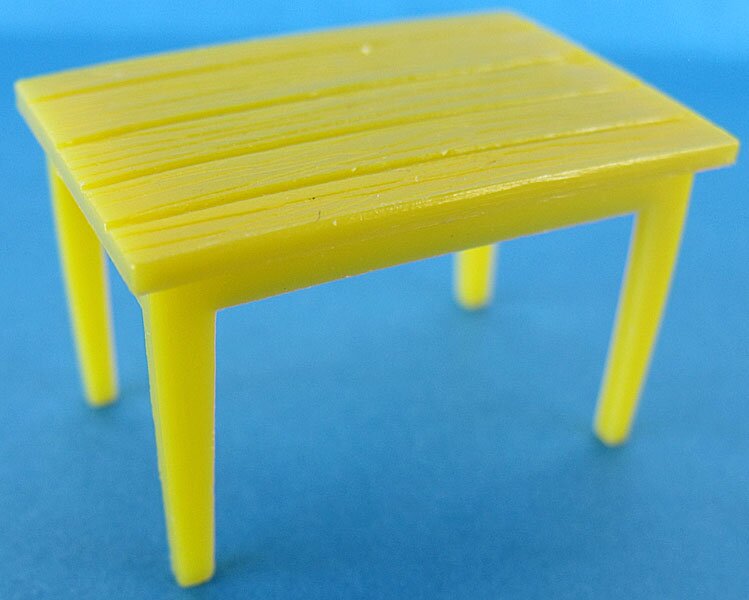 |
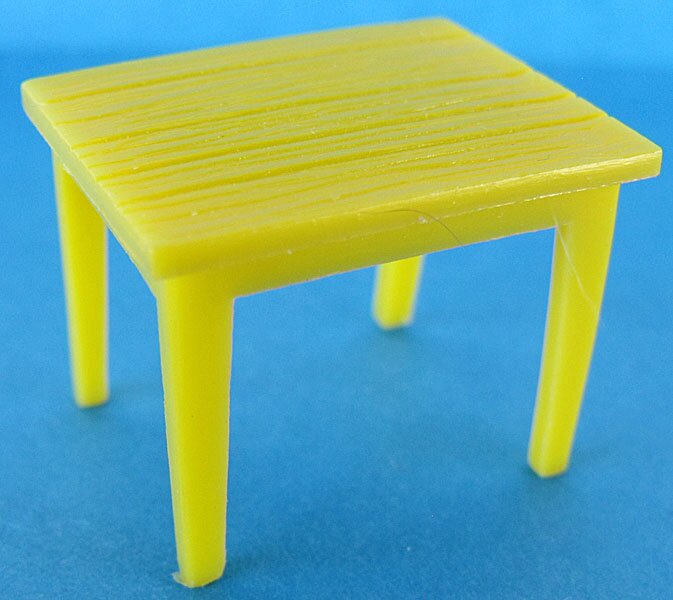 |
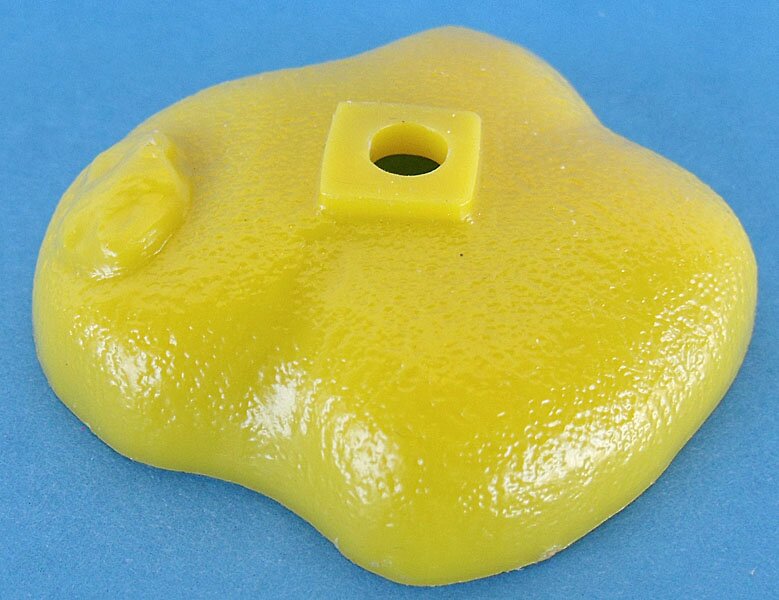 |
| 6. Large table 1-1/2 inches wide |
7. Small table 1-1/4 inches wide |
8. Flag base 1-7/8 inches at greatest width |
| Both tables are the same height and depth, but the large one is about 1-1/2 inches wide and the small one about 1-1/4 inches wide. It's difficult to understand why the company did not just make two of the same table instead of creating two molds. | This is for the flag of whoever is not currently in control of the mountain (whose flag should be at the top of the mountain!). | |
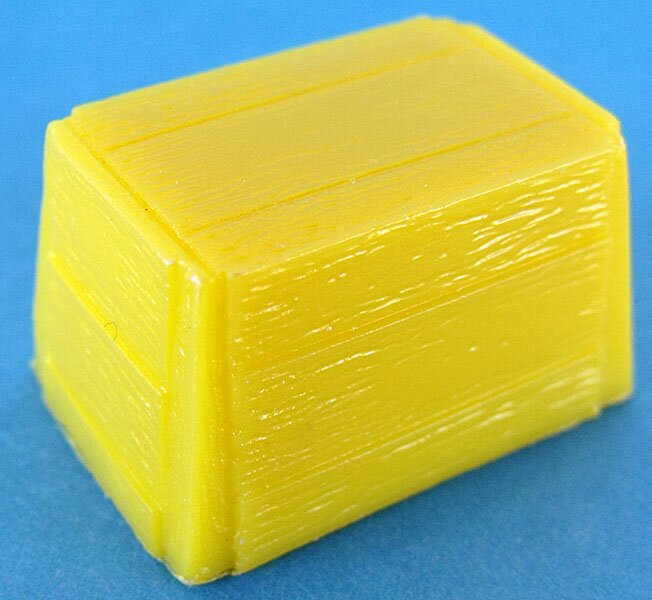 |
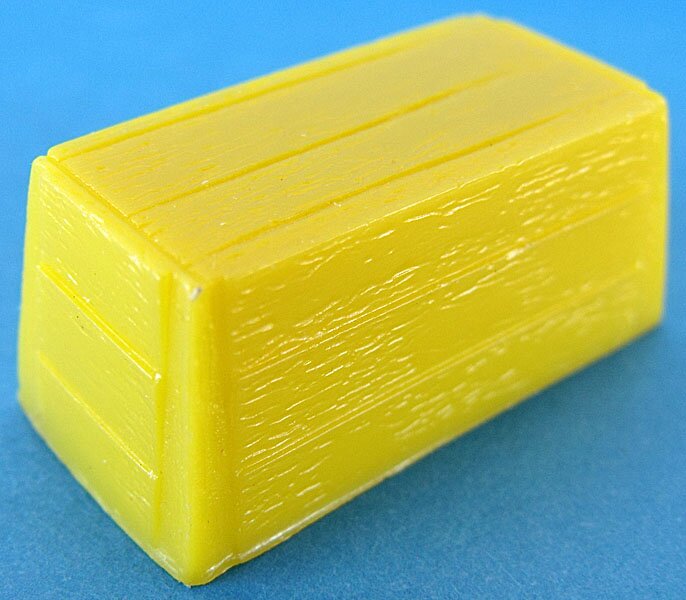 |
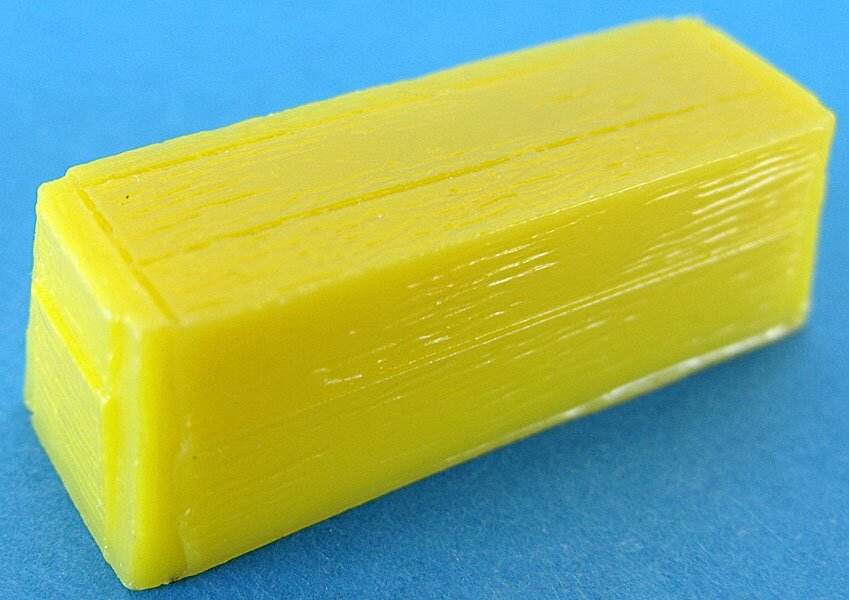 |
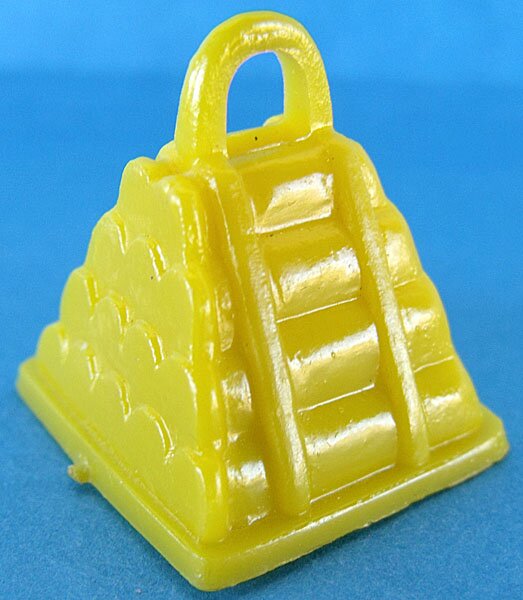 |
| 9. Small box | 10. Large box | 11. Long box | 12. Pile of ammunition |
| Small and large box are both 5/8 inches tall, but small box is an inch wide and large box is 1-3/8 inches wide. Long box is not quite as wide as large box -- only 1-1/4 inches wide -- but is only 3/8 inches tall. Bottoms of all boxes are slightly larger than tops. | |||
Note that a playmat also came with the Navarone set. It is shown earlier on this page, under the Playmats and Bases Section.
